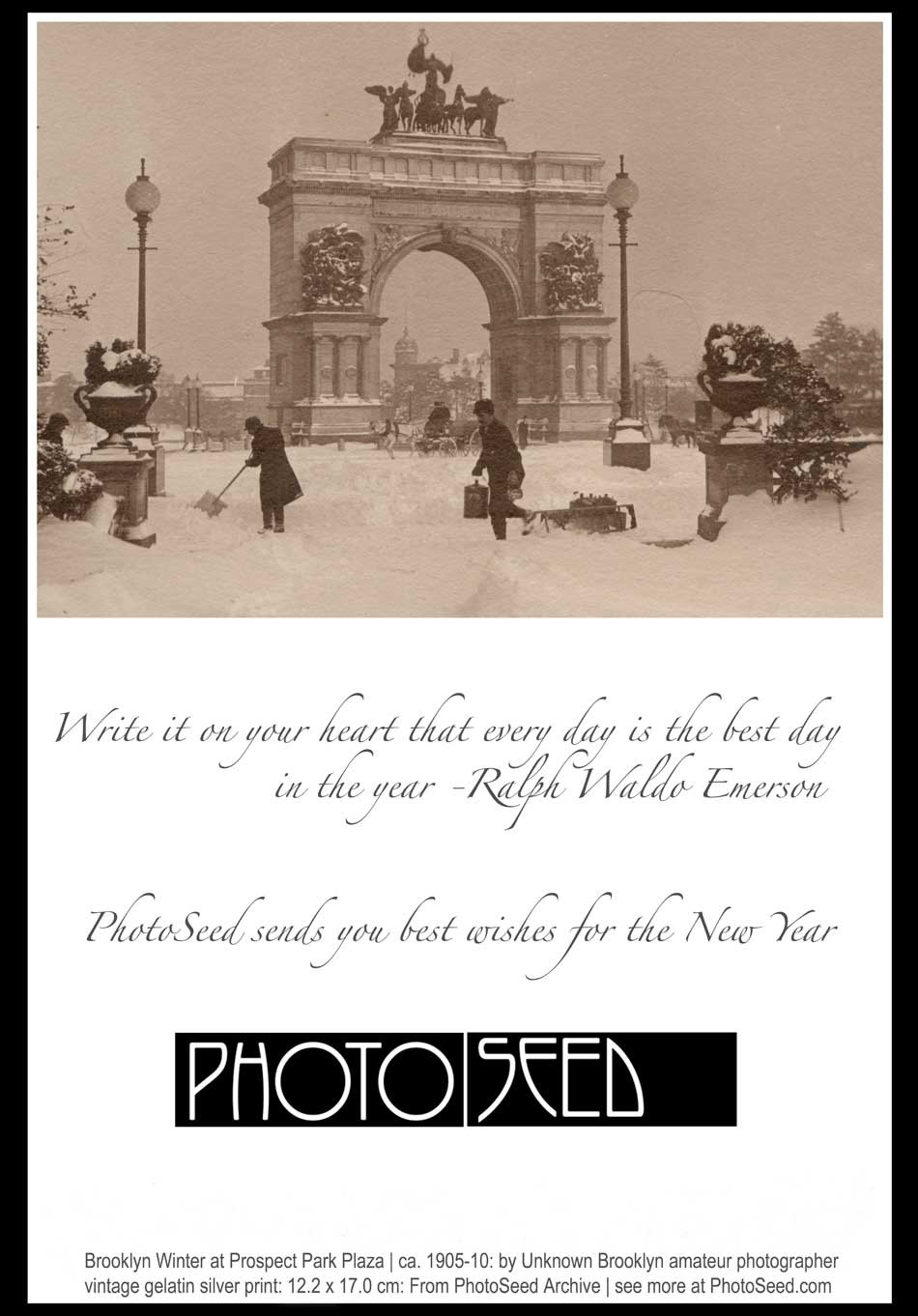Category
Unknown Photographers
15 entries in this category | view all categories
Freedom of Jones
Posted July 2017 in Documentary Photography, History of Photography, Unknown Photographers
That experiment of American Democracy, culminating in our annual celebration today of the Fourth of July holiday, has survived 241 times since that fateful Philadelphia signing, in 1776, of a remarkable document giving notice to the larger world our Declaration of Independence and legal right to self-rule, with benefits.
 Detail: "Asbury Park Boardwalk": Laural J. Jones, American: 2004 digital scan taken from ca. 1938-1945 black and white film negative: A woman who may have become the photographer's second wife, Edith, sits with a white hat on her lap on a bench at center in this bustling summer boardwalk scene taken at the Fourth Ave. entrance. The 18-hole Asbury Park Obstacle Golf course can be seen directly behind the bench at center and at left. Courtesy: Private Florida Collection
Detail: "Asbury Park Boardwalk": Laural J. Jones, American: 2004 digital scan taken from ca. 1938-1945 black and white film negative: A woman who may have become the photographer's second wife, Edith, sits with a white hat on her lap on a bench at center in this bustling summer boardwalk scene taken at the Fourth Ave. entrance. The 18-hole Asbury Park Obstacle Golf course can be seen directly behind the bench at center and at left. Courtesy: Private Florida Collection
Freedom of expression, and with it speech as it relates to the right of picking up a camera and chronicling daily life in one own’s creative bent without fear or favor are American freedoms held dearly by this website. I long hope our presently divided country can see the worth and value of all her citizens understanding each other and getting along for the betterment of the whole.
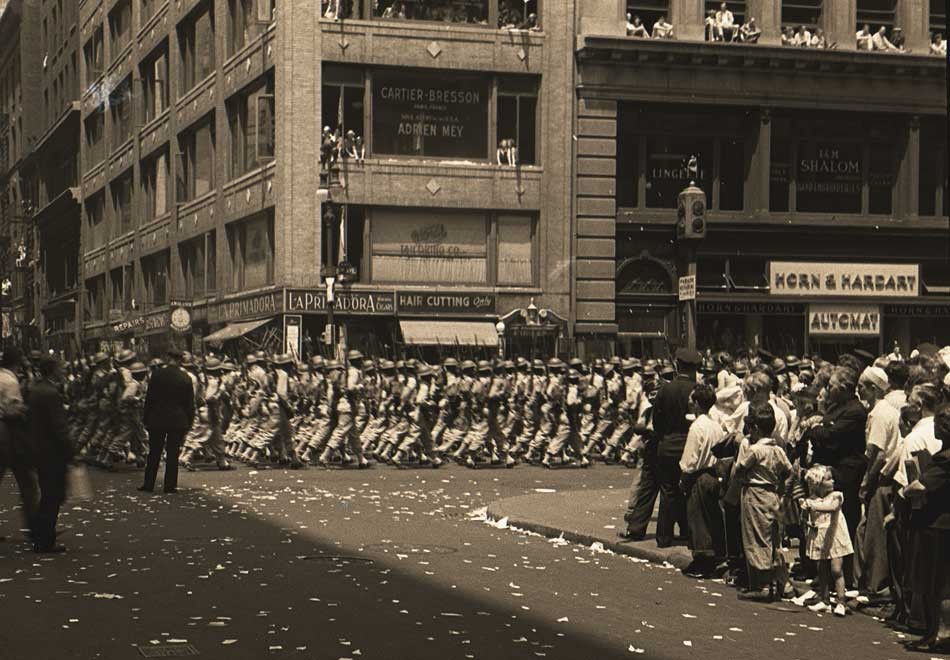 Detail: "Fifth Avenue Military Parade": Laural J. Jones, American: 2004 digital scan taken from ca. 1938-1945 black and white film negative: Possibly taken before World War II, a little girl at far right holds an American flag as US infantry troops march up Fifth Ave. in New York City. The location of the photograph is W. 27th Street. The former La Primadora Havana Cigar shop can be seen at center at 234 Fifth Ave. and a Horn & Hardart automat is in the lower floor retail area next door at 236 Fifth Ave. Courtesy: Private Florida Collection
Detail: "Fifth Avenue Military Parade": Laural J. Jones, American: 2004 digital scan taken from ca. 1938-1945 black and white film negative: Possibly taken before World War II, a little girl at far right holds an American flag as US infantry troops march up Fifth Ave. in New York City. The location of the photograph is W. 27th Street. The former La Primadora Havana Cigar shop can be seen at center at 234 Fifth Ave. and a Horn & Hardart automat is in the lower floor retail area next door at 236 Fifth Ave. Courtesy: Private Florida Collection
Not Lost Forever: the work of Laural J. Jones
With the blessing of a good friend who owns this documentary work in the form of developed 35mm black & white film negatives, and dating more than 20 years past the offerings of the more typical pictorialist body of work featured on PhotoSeed, I’m taking advantage of America’s national holiday to introduce to the world a gentleman who knew a thing or two about self-expressionistic ideals enshrined in our Constitution, the work of American amateur photographer Laural J.(ohn) Jones. (1897-1980)
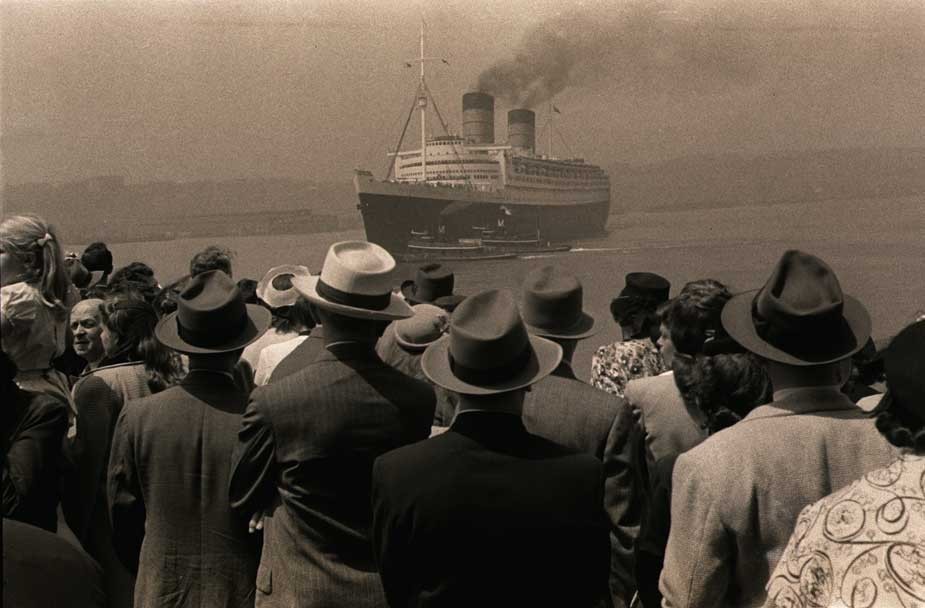 Detail: "RMS Queen Elizabeth in New York Harbor": Laural J. Jones, American: 2004 digital scan taken from ca. 1940-1945 black and white film negative: Although it is unknown when this photograph was taken, onlookers witness the famed 85,000 ton RMS Queen Elizabeth ocean liner in this photo. She initially docked on March 7, 1940 at Pier 90 in quarantine anchorage off Staten Island following a secret voyage to the US from Greenock, Scotland in order to evade German bombers. Courtesy: Private Florida Collection
Detail: "RMS Queen Elizabeth in New York Harbor": Laural J. Jones, American: 2004 digital scan taken from ca. 1940-1945 black and white film negative: Although it is unknown when this photograph was taken, onlookers witness the famed 85,000 ton RMS Queen Elizabeth ocean liner in this photo. She initially docked on March 7, 1940 at Pier 90 in quarantine anchorage off Staten Island following a secret voyage to the US from Greenock, Scotland in order to evade German bombers. Courtesy: Private Florida Collection
Reminiscent in some ways to the much larger body of unknown photographs done by Chicago nanny Vivian Maier (1926-2009) after her life’s work was rescued from a storage locker in 2007, Jones work by contrast and fate was preserved in only two shoe boxes. Residing for more than five years in a Florida antique store before being discovered and saved, spooled negatives by Laural Jones along with an assortment of very small printed photographs are believed to have been placed there from an estate sale originating from the photographer’s second wife Edith, who had lived with Laural in the community of Harbour Oaks, south of Daytona Beach.
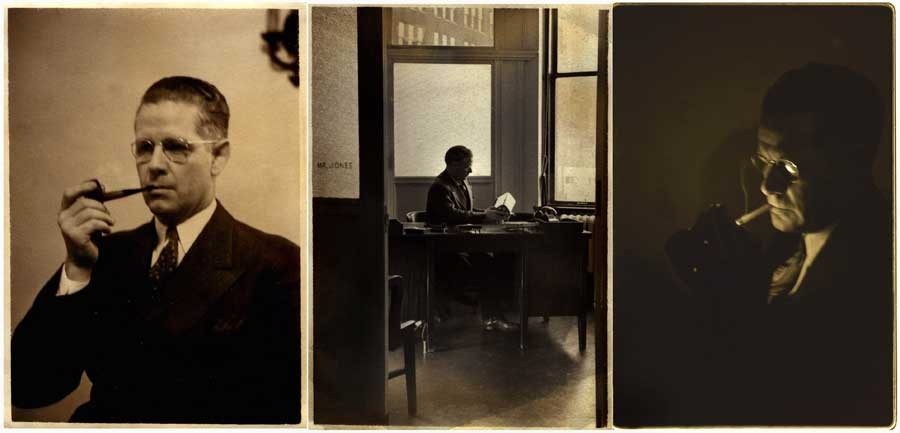 "Self-Portraits of Laural J. Jones: 1897-1980": Laural J. Jones, American: 2004 digital scans taken from ca. 1938-1953: black and white film negatives: The photographer is seen here in a series of self portraits with the center view taken at his office in New York City, where he was employed as the secretary of purchasing for Bell Bakeries, Inc. Courtesy: Private Florida Collection
"Self-Portraits of Laural J. Jones: 1897-1980": Laural J. Jones, American: 2004 digital scans taken from ca. 1938-1953: black and white film negatives: The photographer is seen here in a series of self portraits with the center view taken at his office in New York City, where he was employed as the secretary of purchasing for Bell Bakeries, Inc. Courtesy: Private Florida Collection
Since all that remains are negatives, and with sparse details of his life slowly emerging from US Census and other web resources and records only recently, the Michigan-born Jones is known to have owned the then-new Leica camera sometime around 1938, around the time he is believed to have commenced his early interest in photography. In one surviving photograph stamped 1942 that is an obvious self-portrait, the photographer is nattily dressed and smoking a pipe while he inspects a copy of Popular Photography magazine.
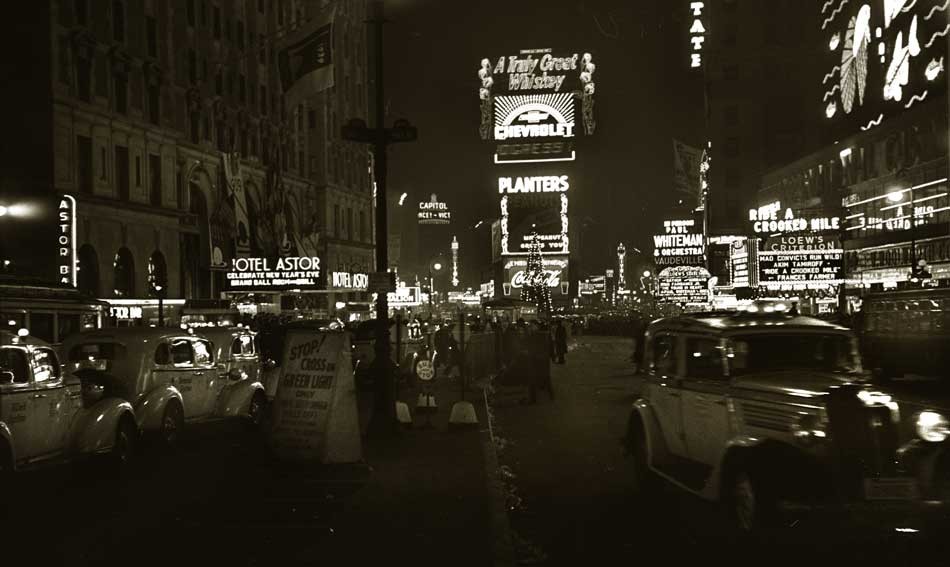 Detail: "1938: Times Square at Night": Laural J. Jones, American: 2004 digital scans taken from ca. 1938 black and white film negative: In this view showing Times Square at night in New York City taken between Christmas and New Year's Eve 1938, a large banner for the year 1939 hangs above the entrance to the Hotel Astor at far left which exclaims those to Celebrate New year's Eve in their Grand Ball Room and Grill. A large lighted Christmas tree is in center background while at far right, the Loew's Criterion marquee advertises in glowing lights the American movie western "Ride a Crooked Mile" starring Akim Tamiroff and Frances Farmer. Courtesy: Private Florida Collection
Detail: "1938: Times Square at Night": Laural J. Jones, American: 2004 digital scans taken from ca. 1938 black and white film negative: In this view showing Times Square at night in New York City taken between Christmas and New Year's Eve 1938, a large banner for the year 1939 hangs above the entrance to the Hotel Astor at far left which exclaims those to Celebrate New year's Eve in their Grand Ball Room and Grill. A large lighted Christmas tree is in center background while at far right, the Loew's Criterion marquee advertises in glowing lights the American movie western "Ride a Crooked Mile" starring Akim Tamiroff and Frances Farmer. Courtesy: Private Florida Collection
Earlier, on Thanksgiving day in 1918, he was first married to the former Ruby A. Armour, (1899-1977) and is listed in a newspaper wedding announcement from the time as being the assistant manager of the Grand Leader Department Store in Battle Creek, with Ruby working there as a clerk. The year of the marriage, the future photographer is described as tall and slender with blue eyes on his World War I draft card, although it appears he was never called up. The couple lived with Laural’s father Mayver Jones, a carpenter for the Advance-Rumely Co., and mother Cora at their home at 129 Somerset Ave. in Battle Creek.
An interesting newspaper account from 1933 showed Laural shared a passion for carpentry like his father, and was also skilled in design. That year he spent several months constructing and designing a custom travel trailer coach in his father’s Someset Ave. carpentry shop meant to “conform with the new stream-line automobiles”. It was: “20 feet in length, maroon color with aluminum top. The interior is divided into two compartments, and is finished throughout in paneled veneer, walnut finish. The forward compartment is furnished with built-in library table, Pullman couch upholstered in brown Spanish leather with chairs to match, and folding typewriter desk, and radio, with an oval rug as floor covering.” The couple also seemed to have the luxery of time and money: they hit the road late that Fall pulling the new coach in route to St. Petersburg, FL, where they spent the Winter.
In 1935, according to his 1980 obituary, Laural moved to New York City from Michigan in order to serve as secretary in charge of purchasing for Bell Bakeries Inc., a large commercial concern with factories throughout the eastern seaboard and beyond. But it’s not clear if Laural’s wife Ruby accompanied him on the new adventure. That’s because 11 years later, the Battle Creek Enquirer newspaper for June 4, 1946 lists the couple receiving a divorce before Battle Creek circuit court Judge Blaine W. Hatch the day before.
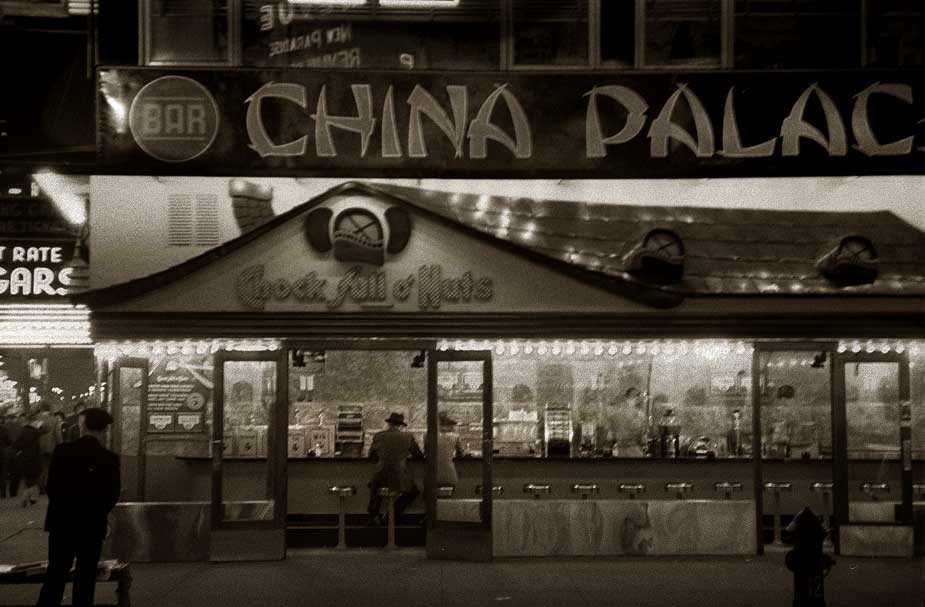 Detail: "Chock Full o' Nuts at Night": Laural J. Jones, American: 2004 digital scan taken from ca. 1938-1945 black and white film negative: This nighttime view believed to have been taken in Brooklyn Heights shows the popular post-Depression coffee shop with the large China Palace restaurant behind it. The coffee brand still marketed today featured shops selling a cup of coffee and sandwich for only a nickel. (at the time, there were 18 shops around New York) A police officer looks on at foreground left while a gentleman wearing his hat can be seen seated along a row of stools through the open doorway of the establishment at center. Courtesy: Private Florida Collection
Detail: "Chock Full o' Nuts at Night": Laural J. Jones, American: 2004 digital scan taken from ca. 1938-1945 black and white film negative: This nighttime view believed to have been taken in Brooklyn Heights shows the popular post-Depression coffee shop with the large China Palace restaurant behind it. The coffee brand still marketed today featured shops selling a cup of coffee and sandwich for only a nickel. (at the time, there were 18 shops around New York) A police officer looks on at foreground left while a gentleman wearing his hat can be seen seated along a row of stools through the open doorway of the establishment at center. Courtesy: Private Florida Collection
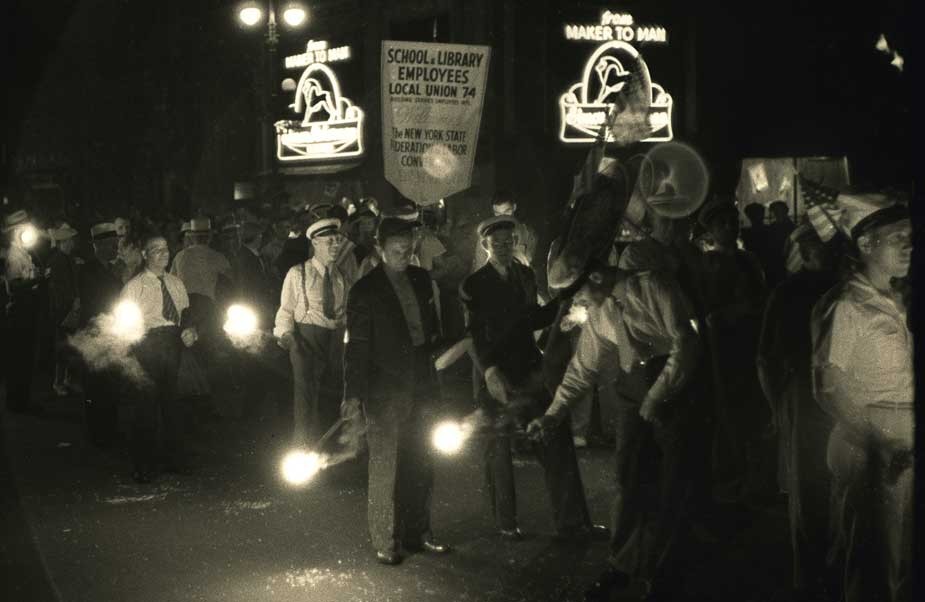 Detail: "Union Rally at Night": Laural J. Jones, American: 2004 digital scan taken from ca. 1938-1945 black and white film negative: Holding flares and American flags, a nighttime rally of custodians employed by New York City custodians, members of School & Library Employees Local Union 74, takes place at an unknown New York City location. Courtesy: Private Florida Collection
Detail: "Union Rally at Night": Laural J. Jones, American: 2004 digital scan taken from ca. 1938-1945 black and white film negative: Holding flares and American flags, a nighttime rally of custodians employed by New York City custodians, members of School & Library Employees Local Union 74, takes place at an unknown New York City location. Courtesy: Private Florida Collection
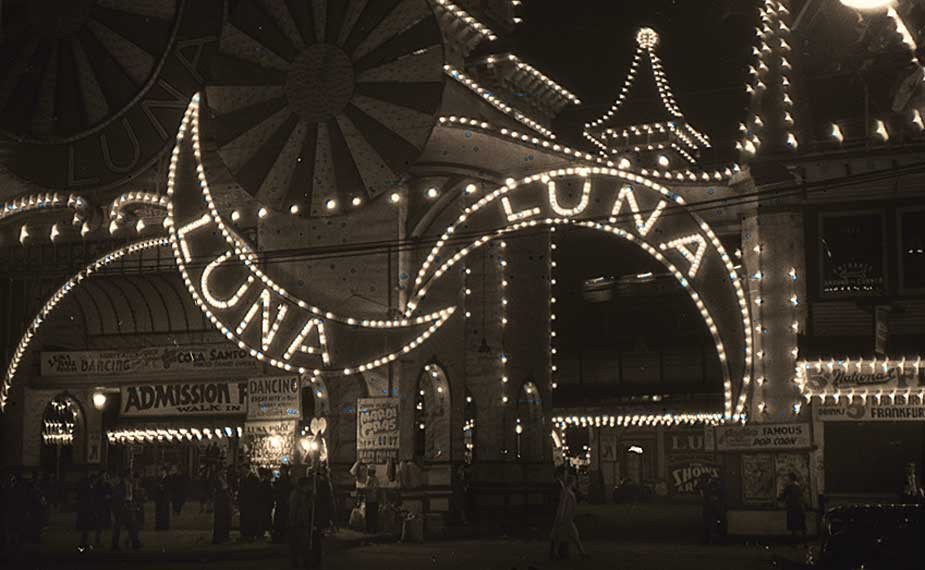 Detail: "Entrance to Luna Park, Coney Island at Night": Laural J. Jones, American: 2004 digital scan taken from ca. 1938-1945 black and white film negative: Luna Park was an amusement park in Coney Island, Brooklyn, in New York City that first opened in 1903 and was destroyed by fire in 1944. It finally closed in 1946 after a second fire. Courtesy: Private Florida Collection
Detail: "Entrance to Luna Park, Coney Island at Night": Laural J. Jones, American: 2004 digital scan taken from ca. 1938-1945 black and white film negative: Luna Park was an amusement park in Coney Island, Brooklyn, in New York City that first opened in 1903 and was destroyed by fire in 1944. It finally closed in 1946 after a second fire. Courtesy: Private Florida Collection
Taking advantage of city life, while using the Leica 35mm rangefinder to record night scenes a speciality, Laural Jones documented a fascinating and important record of Manhattan and the outer boroughs from the late 1930’s and into the 1940’s, with some of the larger events unfolding before his camera spanning the later years of the American Depression and leading through to the re-ordering of a new world order brought on by World War II. Sadly, the story of preservation as it relates to someones creative and personal artistic endeavors is one consistent with people’s indifference to memories and Photography’s evolving history. But survivors like Laural Jones do show up, thankfully, and in these nine digital offerings, I think you will find plenty to be fascinated with and hopefully inspired by.
David Spencer-
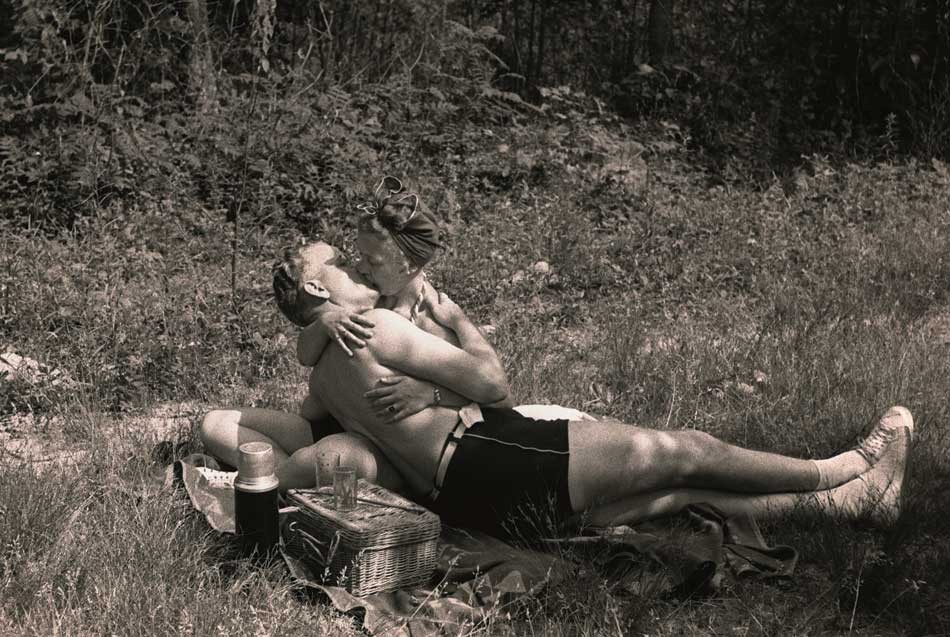 Detail: "Picnic Kiss": Laural J. Jones, American: 2004 digital scan taken from ca. 1938-1945 black and white film negative. Laying on a blanket shirtless, and with a picnic hamper and two glasses balancing on top at left, the photographer Laural Jones kisses a woman that may be his future spouse Edith at an unknown location. This woman appears in many surviving negatives taken by the photographer, including one of her on the Asbury Park boardwalk at the top of this post. Courtesy: Private Florida Collection
Detail: "Picnic Kiss": Laural J. Jones, American: 2004 digital scan taken from ca. 1938-1945 black and white film negative. Laying on a blanket shirtless, and with a picnic hamper and two glasses balancing on top at left, the photographer Laural Jones kisses a woman that may be his future spouse Edith at an unknown location. This woman appears in many surviving negatives taken by the photographer, including one of her on the Asbury Park boardwalk at the top of this post. Courtesy: Private Florida Collection
SpringSprung
Posted April 2016 in Alternate Processes, Color Photography, Fashion Photography, New Additions, Unknown Photographers
The Northern Hemisphere has once again thankfully undergone rebirth, becoming the season of spring and with it, all the hope it represents for the continuation of our natural and human worlds.
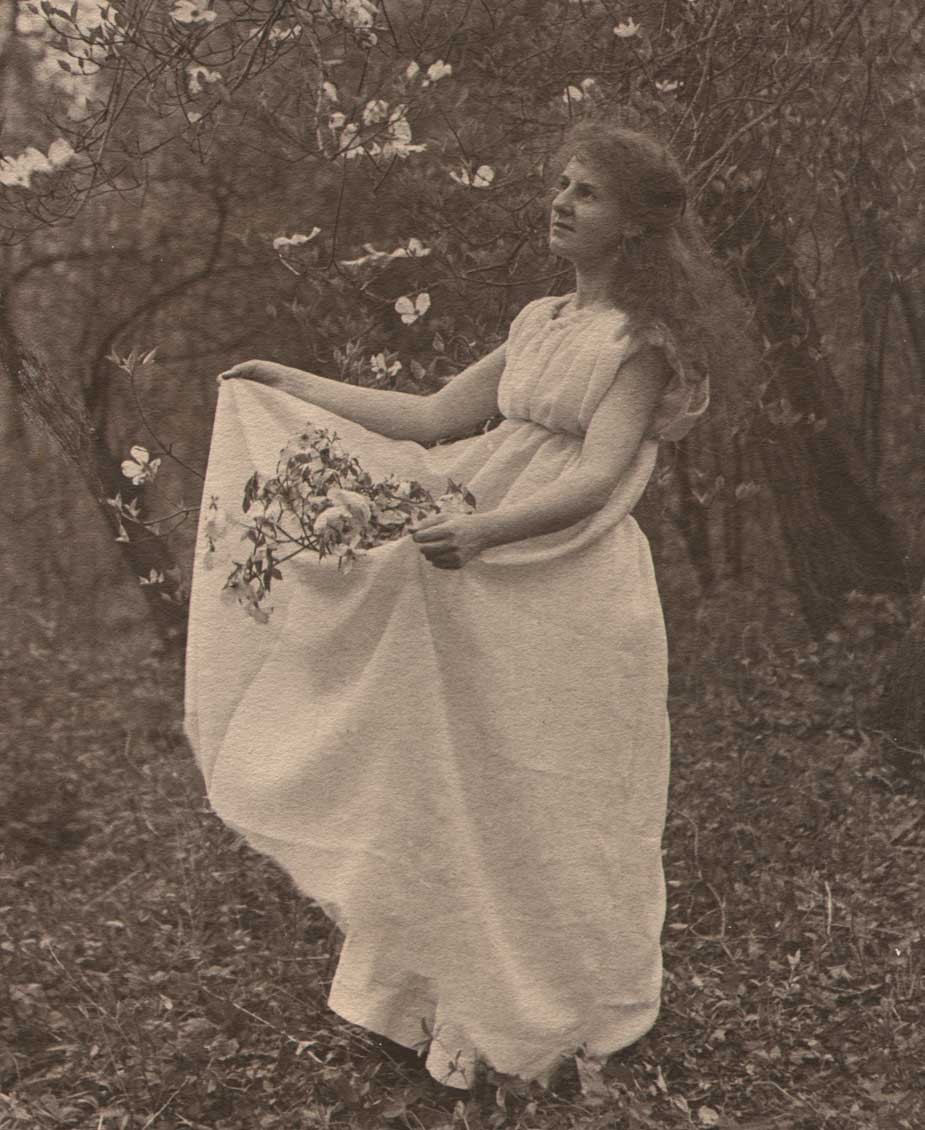 Detail: "Curtis High School Girl Gathering Dogwood Boughs": Charles Rollins Tucker: American: platinum: ca. 1910-15: 19.7 x 13.1 | 30.5 x 23.3 cm: A genre landscape study celebrating both spring and womanhood, the model is perhaps a thespian known to have attended Curtis High School on Staten Island in New York City, where photographer C.R. Tucker taught Physics at the time. From: PhotoSeed Archive
Detail: "Curtis High School Girl Gathering Dogwood Boughs": Charles Rollins Tucker: American: platinum: ca. 1910-15: 19.7 x 13.1 | 30.5 x 23.3 cm: A genre landscape study celebrating both spring and womanhood, the model is perhaps a thespian known to have attended Curtis High School on Staten Island in New York City, where photographer C.R. Tucker taught Physics at the time. From: PhotoSeed Archive
Photographically, with the exceptions of those open-minded enough to embrace the obvious-something Alfred Stieglitz seized upon in 1893 when winter proved more than suitable for subject matter- the majority of amateurs a bit later at the turn of the 20th century seemed interested in dusting off their cameras only when those first buds and flowers of the season awoke once more.
This abbreviated compilation of images spanning the 1890’s through about 1940 from the PhotoSeed Archive-no matter how dated they may appear from the mores of days long gone by- is a reaffirmation dedicated to you that spring’s beauty and potential might give us all a bit of hope towards the future betterment of our often fragmented, present-day world. David Spencer- April, 2016
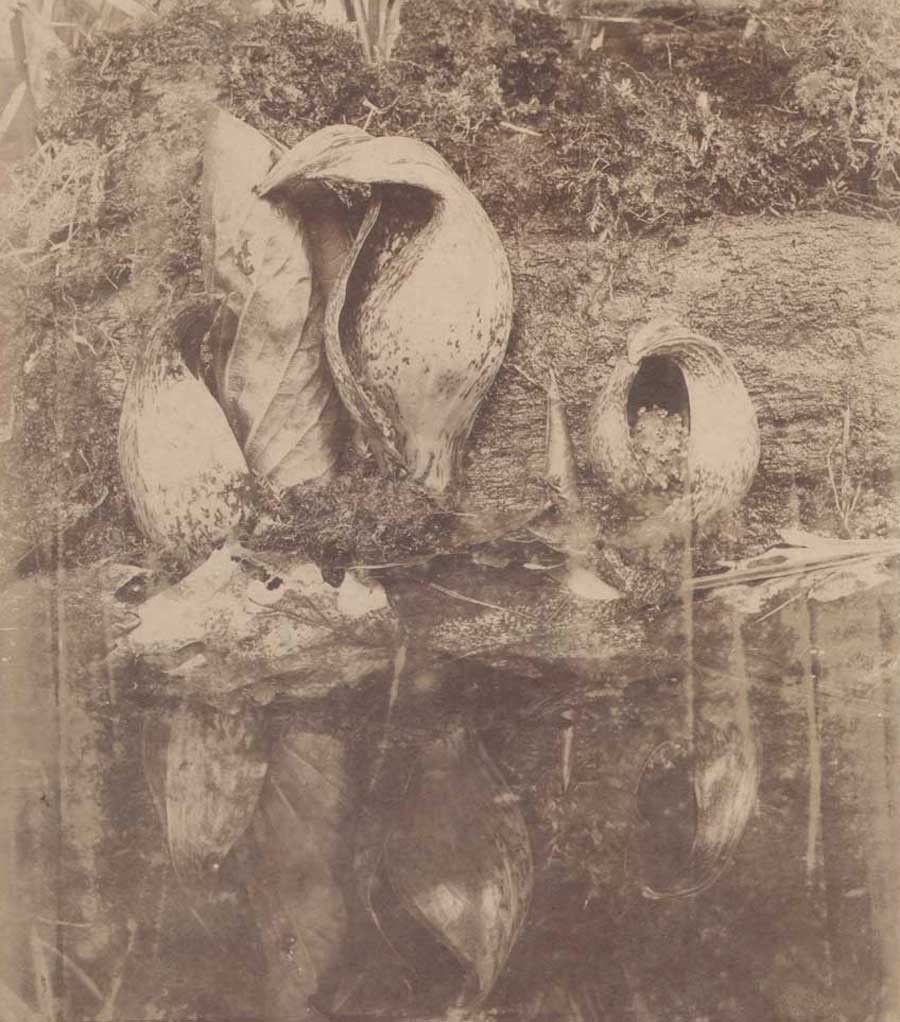 Detail: "Harbingers of Spring": Louise Birt Baynes: American: gelatin silver: 1904: 20.8 x 15.5 | 35.6 x 27.9 cm: This study of skunk cabbage growing in the spring time may have been taken using an artificial light source. Author Frank Roy Fraprie mentioned the work in his article on photographing wild flowers for the March, 1904 issue of Boston’s Photo-Era magazine: "The plant must be photographed in its surroundings, for it has no stem or leaves at this season, to make possible a graceful arrangement at home, even if one were inclined to extend it hospitality. Mrs. Baynes has conquered all these difficulties, and her picture, “Harbingers of Spring,” is interesting to both the naturalist and the artistic photographer, - to one for its fidelity and to the other for its good composition." From: PhotoSeed Archive
Detail: "Harbingers of Spring": Louise Birt Baynes: American: gelatin silver: 1904: 20.8 x 15.5 | 35.6 x 27.9 cm: This study of skunk cabbage growing in the spring time may have been taken using an artificial light source. Author Frank Roy Fraprie mentioned the work in his article on photographing wild flowers for the March, 1904 issue of Boston’s Photo-Era magazine: "The plant must be photographed in its surroundings, for it has no stem or leaves at this season, to make possible a graceful arrangement at home, even if one were inclined to extend it hospitality. Mrs. Baynes has conquered all these difficulties, and her picture, “Harbingers of Spring,” is interesting to both the naturalist and the artistic photographer, - to one for its fidelity and to the other for its good composition." From: PhotoSeed Archive
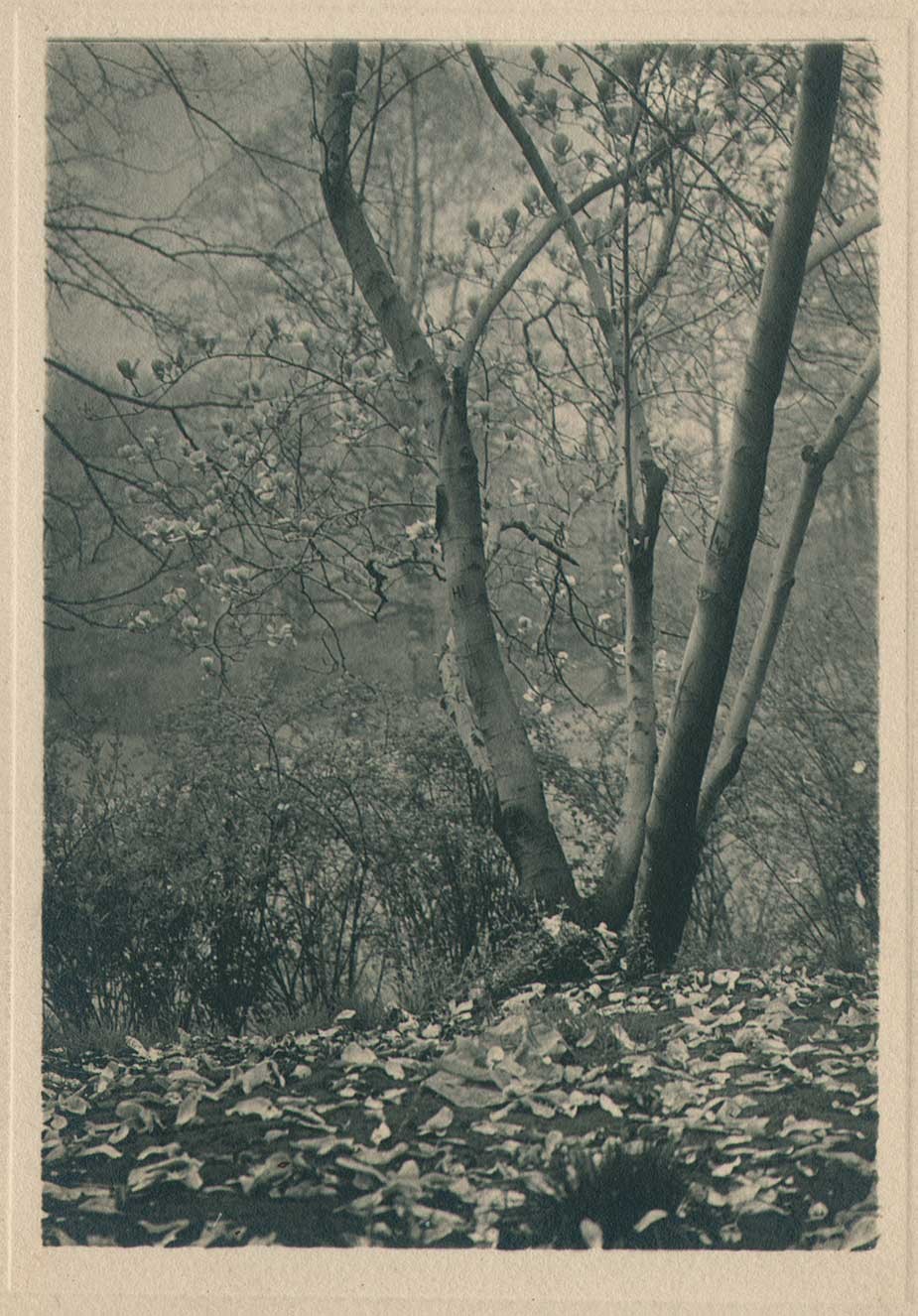 "Spring Vista with Fallen Leaves": by Unknown Brooklyn (photographer) : American: carbon?: ca. 1905-10: 11.9 x 8.2 | 17.8 x 12.1 cm: What are believed to be Magnolia tree blossoms litter the ground in the foreground of this spring landscape study featuring a blooming Magnolia in the background, with the setting believed to be Brooklyn's Prospect Park as many known examples of this location were taken by this photographer. This photograph, with title supplied by this archive, is by an Unknown Brooklyn amateur photographer whose surviving work was discovered in a trunk in the American South. Background can be found by searching for this site's 2015 blog post: "No Junk in Trunk". From: PhotoSeed Archive
"Spring Vista with Fallen Leaves": by Unknown Brooklyn (photographer) : American: carbon?: ca. 1905-10: 11.9 x 8.2 | 17.8 x 12.1 cm: What are believed to be Magnolia tree blossoms litter the ground in the foreground of this spring landscape study featuring a blooming Magnolia in the background, with the setting believed to be Brooklyn's Prospect Park as many known examples of this location were taken by this photographer. This photograph, with title supplied by this archive, is by an Unknown Brooklyn amateur photographer whose surviving work was discovered in a trunk in the American South. Background can be found by searching for this site's 2015 blog post: "No Junk in Trunk". From: PhotoSeed Archive
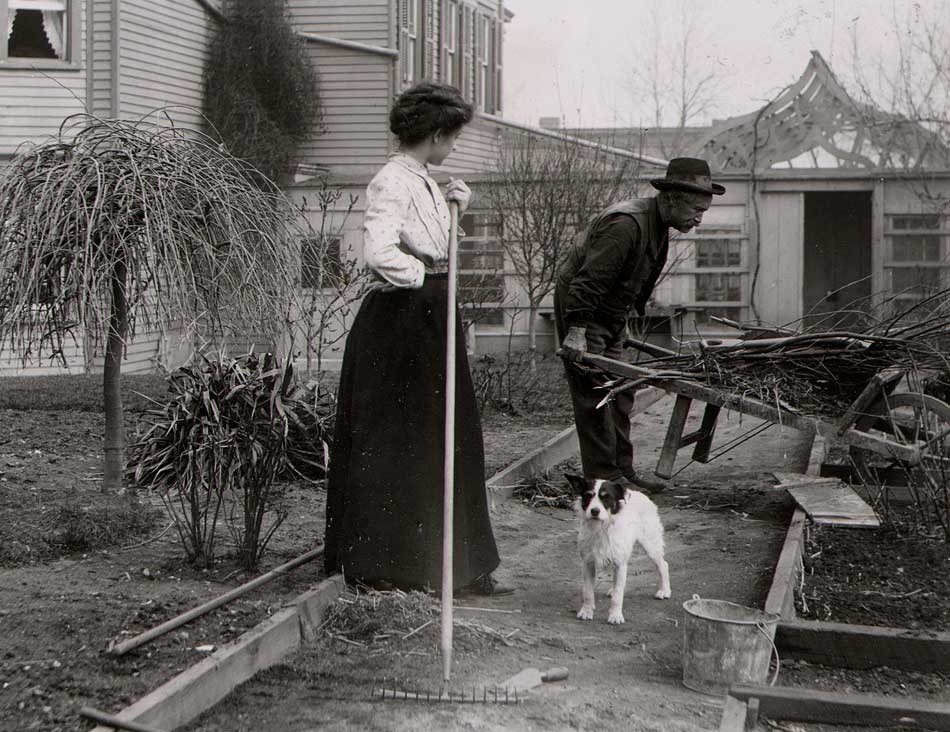 Detail: "Cleaning up the Yard in Spring": c. 1900-05 by Jeanette Bernard: American, born Germany: (1855-1941) gelatin silver print c. 1935-40 from original glass plate negative acquired by Culver Service : 15.4 x 13.9 cm: alternate title: "Woman and Man Gardening"-George Eastman House NEG: 40724: 83:2640:0025: A spring cleaning study in a garden shows the photographer's daughter with pet terrier dog at her feet watching as a gentleman (perhaps a hired man) prepares to move a collection of dead branches using a wheelbarrow. From: PhotoSeed Archive
Detail: "Cleaning up the Yard in Spring": c. 1900-05 by Jeanette Bernard: American, born Germany: (1855-1941) gelatin silver print c. 1935-40 from original glass plate negative acquired by Culver Service : 15.4 x 13.9 cm: alternate title: "Woman and Man Gardening"-George Eastman House NEG: 40724: 83:2640:0025: A spring cleaning study in a garden shows the photographer's daughter with pet terrier dog at her feet watching as a gentleman (perhaps a hired man) prepares to move a collection of dead branches using a wheelbarrow. From: PhotoSeed Archive
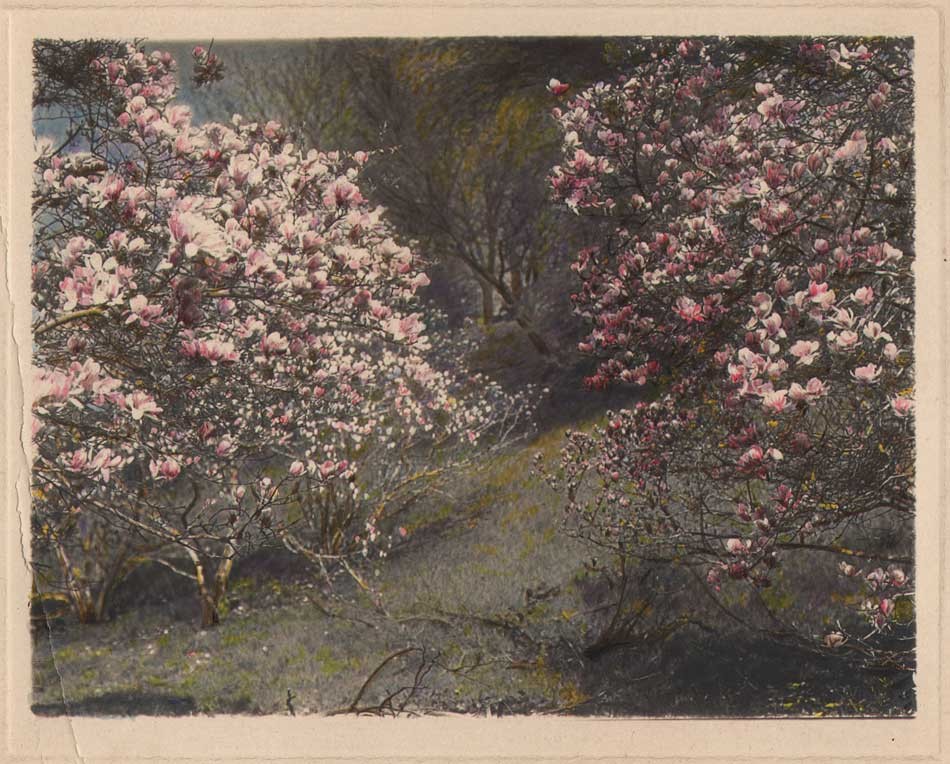 "Magnolia Trees Blooming in Spring": by Unknown Brooklyn (photographer) : American: gelatin silver (hand-colored) from copy print: ca. 1910-15: 9.0 x 11.6 | 12.4 x 16.4 cm: This hand-colored landscape study showing several blooming Magnolia trees is believed to have been taken at Brooklyn's Prospect Park as many known examples of this location were taken by this photographer. This photograph, with title supplied by this archive, is by an Unknown Brooklyn amateur photographer whose surviving work was discovered in a trunk in the American South. Background can be found by searching for this site's 2015 blog post: "No Junk in Trunk". From: PhotoSeed Archive
"Magnolia Trees Blooming in Spring": by Unknown Brooklyn (photographer) : American: gelatin silver (hand-colored) from copy print: ca. 1910-15: 9.0 x 11.6 | 12.4 x 16.4 cm: This hand-colored landscape study showing several blooming Magnolia trees is believed to have been taken at Brooklyn's Prospect Park as many known examples of this location were taken by this photographer. This photograph, with title supplied by this archive, is by an Unknown Brooklyn amateur photographer whose surviving work was discovered in a trunk in the American South. Background can be found by searching for this site's 2015 blog post: "No Junk in Trunk". From: PhotoSeed Archive
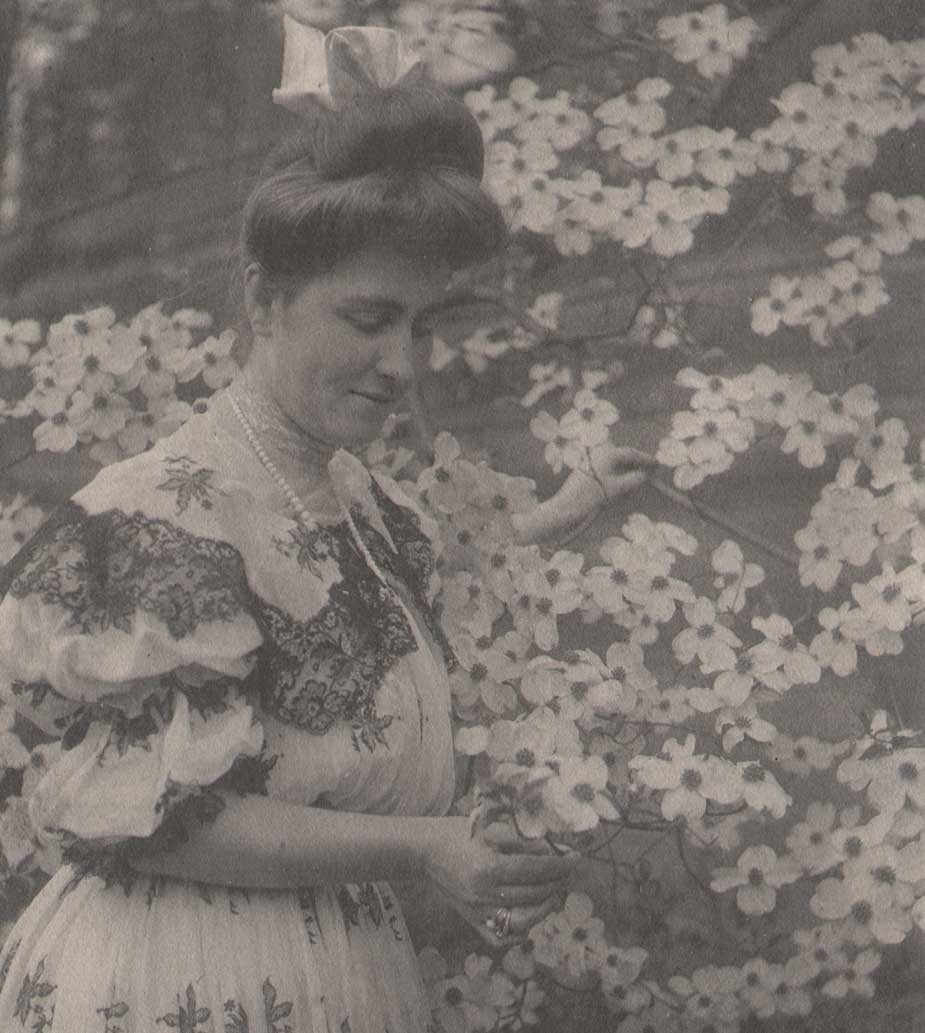 Detail: "Clare Shipman with Dogwood Blossoms": C.M. Shipman: American: platinum: 1904 or before: 17.5 x 11.8 cm | 27.9 x 36.0 cm tipped to black art-paper leaf from album: Born ca. 1880, Clare Cressey Shipman, spouse of amateur photographer Charles Melville Shipman, (1874-1947) examines a cluster of dogwood blossoms, most likely taken in the borough of Richmond on Staten Island, New York City, where the couple lived at the time. The photograph was included with other mostly naturalistic studies compiled in an album by the photographer with the final photograph signed and dated 1904. From: PhotoSeed Archive
Detail: "Clare Shipman with Dogwood Blossoms": C.M. Shipman: American: platinum: 1904 or before: 17.5 x 11.8 cm | 27.9 x 36.0 cm tipped to black art-paper leaf from album: Born ca. 1880, Clare Cressey Shipman, spouse of amateur photographer Charles Melville Shipman, (1874-1947) examines a cluster of dogwood blossoms, most likely taken in the borough of Richmond on Staten Island, New York City, where the couple lived at the time. The photograph was included with other mostly naturalistic studies compiled in an album by the photographer with the final photograph signed and dated 1904. From: PhotoSeed Archive
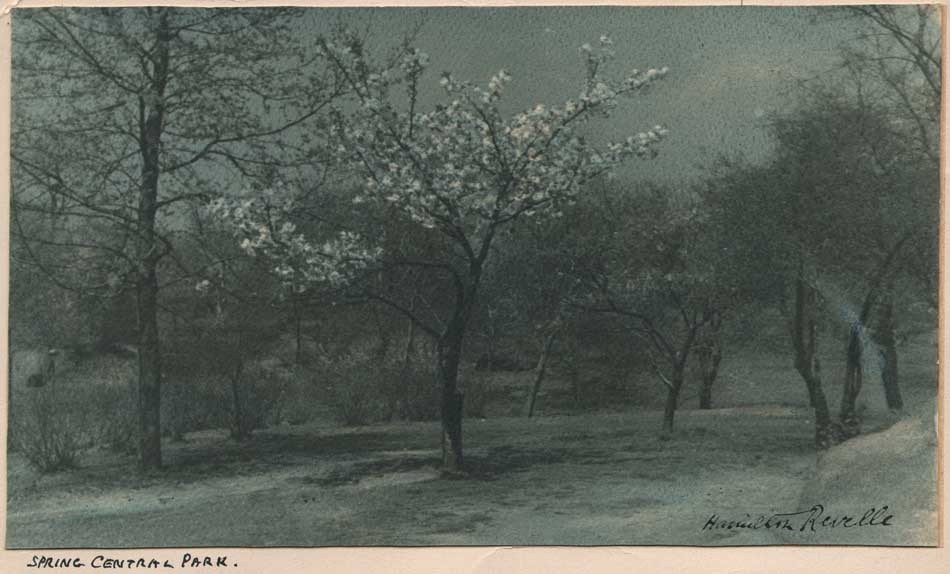 "Spring Central Park": Hamilton Revelle, (1872-1958) English, born Gibraltar: bromoil (hand-colored) ca. 1930-40: 10.2 x 18.5 | 14.3 x 22.4 cm: This delicate hand-colored, blue hued study of a blooming tree in springtime in New York City's Central Park was probably done in the early 1930's along with another landscape study shown with this post. A British born stage and screen actor and consummate amateur photography on the side, he later specialized in the bromoil-transfer process after mastering other processes. The Broadway Photographs website includes a short bio: "Revelle's intense interest in photography perhaps derived from the art's capacity to arrest beauty in timeless perfection. He began carrying his camera equipment with him everywhere and spent his days, before going to the theater in early evening, perfecting his technical mastery of the medium, in platinum, silver, and autochrome. He was an avid experimenter with various printing papers and popularized the print of works on parchment. His portraits were displayed in international salons regularly during the first decade of the 20th century. The Royal Photographic Society of London awarded him its gold medal for excellence in portraiture." From: PhotoSeed Archive
"Spring Central Park": Hamilton Revelle, (1872-1958) English, born Gibraltar: bromoil (hand-colored) ca. 1930-40: 10.2 x 18.5 | 14.3 x 22.4 cm: This delicate hand-colored, blue hued study of a blooming tree in springtime in New York City's Central Park was probably done in the early 1930's along with another landscape study shown with this post. A British born stage and screen actor and consummate amateur photography on the side, he later specialized in the bromoil-transfer process after mastering other processes. The Broadway Photographs website includes a short bio: "Revelle's intense interest in photography perhaps derived from the art's capacity to arrest beauty in timeless perfection. He began carrying his camera equipment with him everywhere and spent his days, before going to the theater in early evening, perfecting his technical mastery of the medium, in platinum, silver, and autochrome. He was an avid experimenter with various printing papers and popularized the print of works on parchment. His portraits were displayed in international salons regularly during the first decade of the 20th century. The Royal Photographic Society of London awarded him its gold medal for excellence in portraiture." From: PhotoSeed Archive
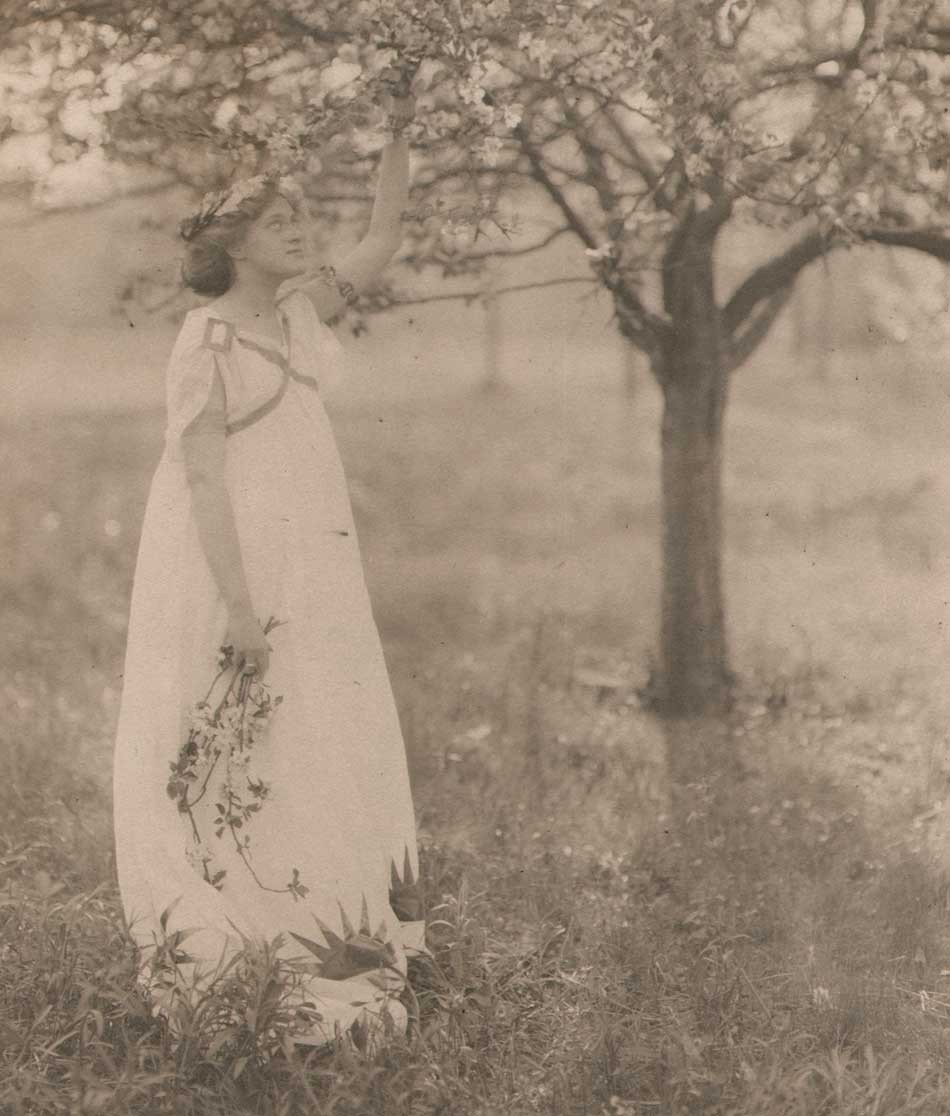 Detail: "Apple Blossoms": Charles Rollins Tucker: American: platinum: ca. 1905-10: 20.3 x 14.7 | 32.7 x 25.5 cm: A genre landscape study celebrating both spring and womanhood, (notice the sunbursts at the bottom of her dress) the model is perhaps a thespian who most likely attended Curtis High School on Staten Island in New York City, where photographer C.R. Tucker taught Physics at the time. From: PhotoSeed Archive
Detail: "Apple Blossoms": Charles Rollins Tucker: American: platinum: ca. 1905-10: 20.3 x 14.7 | 32.7 x 25.5 cm: A genre landscape study celebrating both spring and womanhood, (notice the sunbursts at the bottom of her dress) the model is perhaps a thespian who most likely attended Curtis High School on Staten Island in New York City, where photographer C.R. Tucker taught Physics at the time. From: PhotoSeed Archive
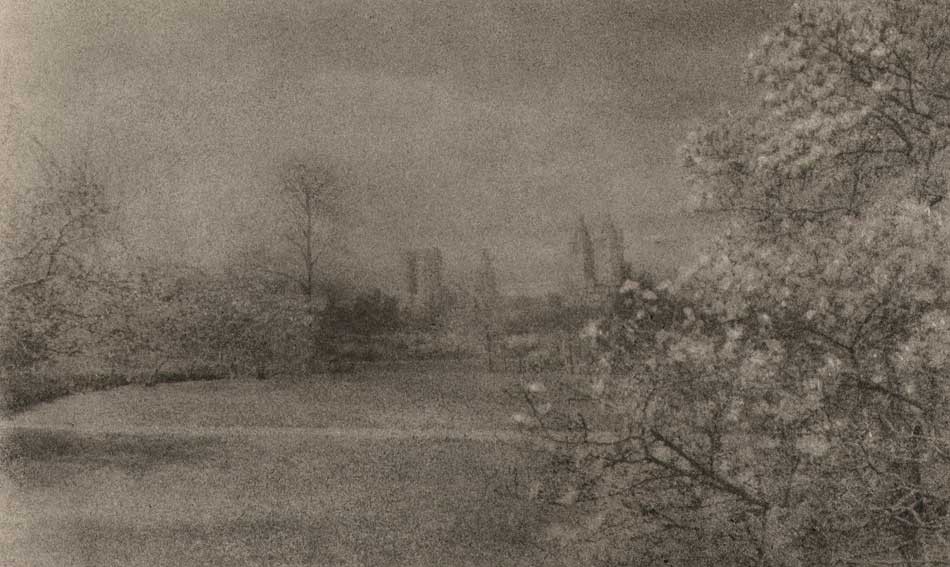 "Central Park Spring with Eldorado": Hamilton Revelle, (1872-1958) English, born Gibraltar: bromoil: ca. 1935-40: 11.5 x 18.5 | 17.6 x 27.8 cm: This bromoil landscape study taken in New York City's Central Park includes a few hints of the Manhattan skyline, including the luxury twin-spired Eldorado apartment building opened in 1931, seen just to the left of the blooming tree on the right side of frame. A British born stage and screen actor and consummate amateur photographer, Revelle later specialized in the bromoil-transfer process after mastering other photographic processes. From: PhotoSeed Archive
"Central Park Spring with Eldorado": Hamilton Revelle, (1872-1958) English, born Gibraltar: bromoil: ca. 1935-40: 11.5 x 18.5 | 17.6 x 27.8 cm: This bromoil landscape study taken in New York City's Central Park includes a few hints of the Manhattan skyline, including the luxury twin-spired Eldorado apartment building opened in 1931, seen just to the left of the blooming tree on the right side of frame. A British born stage and screen actor and consummate amateur photographer, Revelle later specialized in the bromoil-transfer process after mastering other photographic processes. From: PhotoSeed Archive
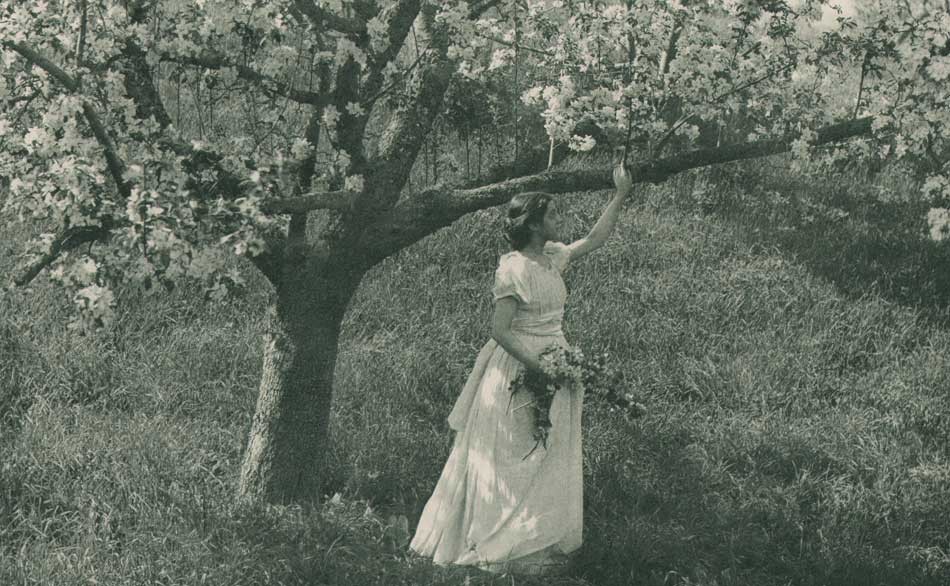 Detail: "Apple Blossoms": Emma Justine Farsworth, American: hand-pulled photogravure published in periodical "Sun & Shade" New York: June, 1893: whole #58: N.Y. Photogravure Co.: 17.0 x 21.7 cm | 27.5 x 34.7 cm: From: PhotoSeed Archive
Detail: "Apple Blossoms": Emma Justine Farsworth, American: hand-pulled photogravure published in periodical "Sun & Shade" New York: June, 1893: whole #58: N.Y. Photogravure Co.: 17.0 x 21.7 cm | 27.5 x 34.7 cm: From: PhotoSeed Archive
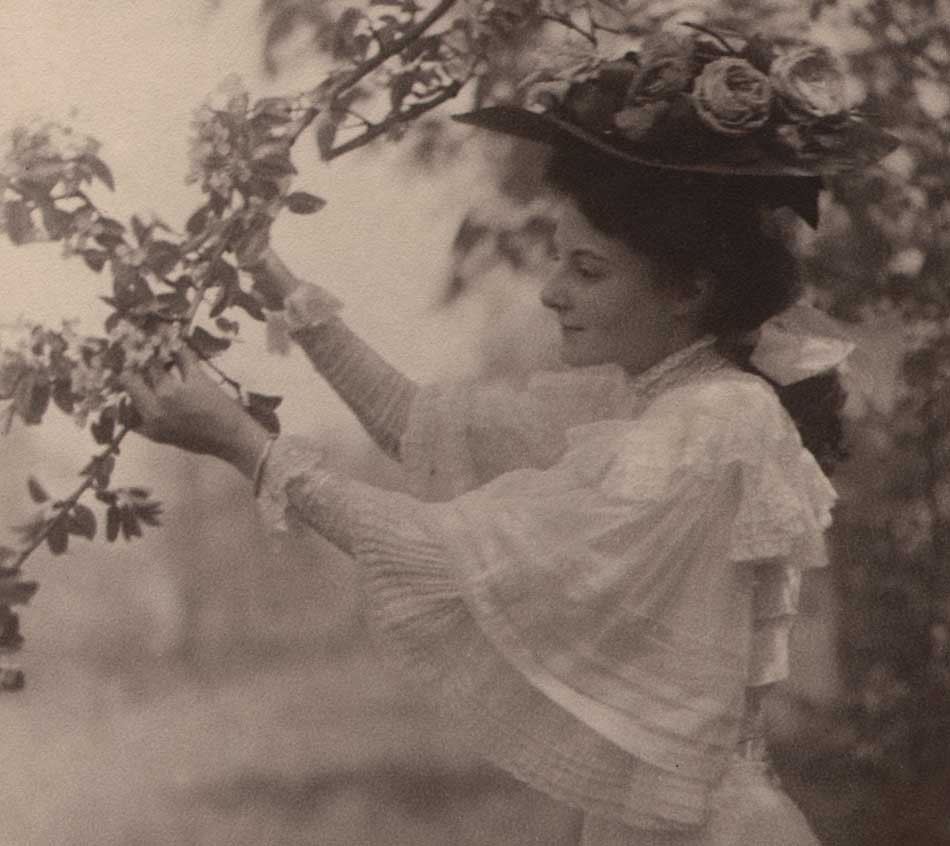 Detail: "Mary Tucker with Apple Blossoms": Charles Rollins Tucker: American: platinum: ca. 1905-10: 26.1 x 19.2 | 30.0 x 22.0 cm: Mary (Carruthers) Tucker, (1870-1940) spouse of amateur photographer C.R. Tucker, holds a bough of blossoms from an apple tree while wearing a hat adorned with flowers in this classic genre study celebrating womanhood in early spring. From: PhotoSeed Archive
Detail: "Mary Tucker with Apple Blossoms": Charles Rollins Tucker: American: platinum: ca. 1905-10: 26.1 x 19.2 | 30.0 x 22.0 cm: Mary (Carruthers) Tucker, (1870-1940) spouse of amateur photographer C.R. Tucker, holds a bough of blossoms from an apple tree while wearing a hat adorned with flowers in this classic genre study celebrating womanhood in early spring. From: PhotoSeed Archive
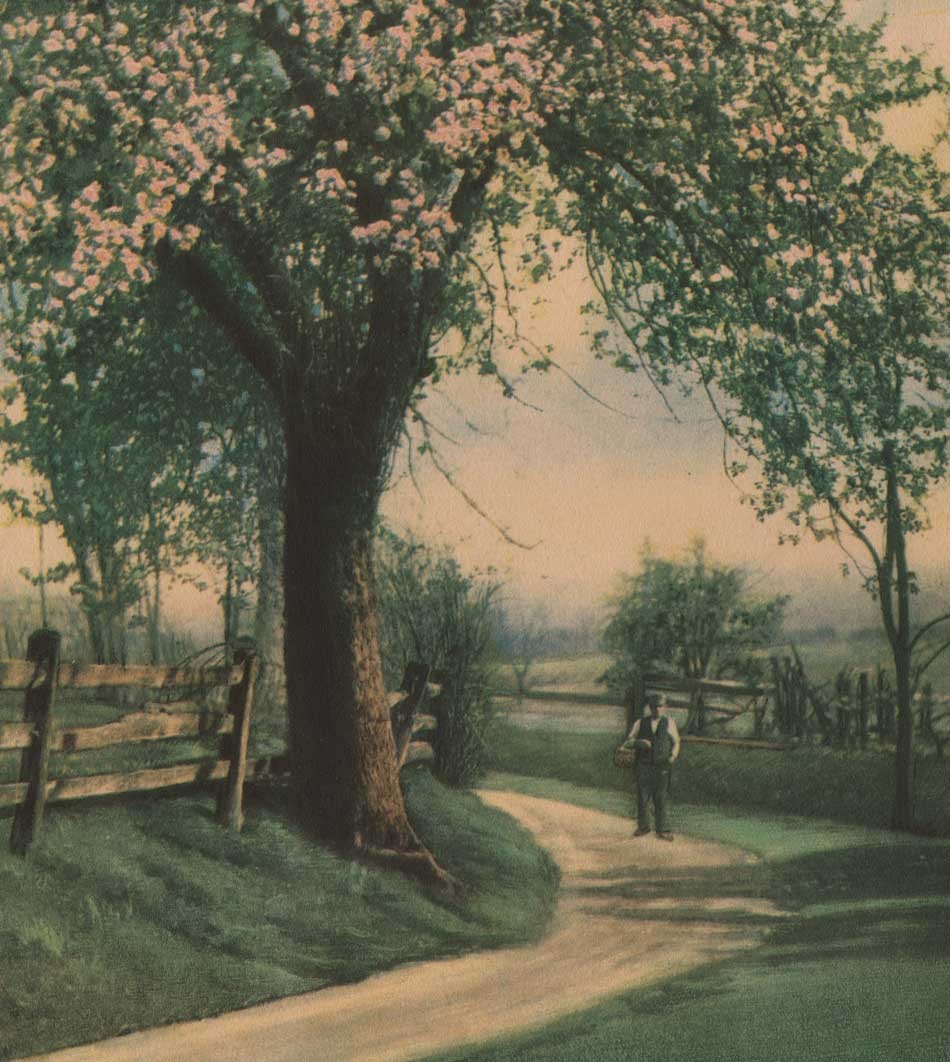 Detail: "In Apple Blossom Time": Henry Troth: American: lithograph, four-color: ca. 1915: 24.7 x 20.3: paperboard mount remnants with following additional details: Negative by Henry Troth; Artist Proof Fac-Simile; Published by the Henry Heininger Co NY.: This landscape study of a gentleman holding a basket in a roadway by Henry Troth shows a large flowering apple tree in the foreground. The Heininger firm, founded in 1885, marketed art reproductions and published postcards in addition to larger works like this. Metropostcard.com states this firm's "Fac-Simile Hand painted Nature Views were of course not hand colored but reproduced hand colored work in four color lithography through the use of paper grains. These cards also have a false plate mark." Another reference included in the publishing trade journal Geyer's Stationer from 1915 when this work is believed to have been produced stated: "The Heininger Co. are famed as well for their extensive line of artist proof facsimile nature pictures so perfectly executed that they readily pass for the high-priced hand-colored photoprints that command such generous prices on the market. The popular prices at which these art subjects are offered should command the instant attention of buyers, who already know the good value of their Abelart line, a complete display of which will be on view." Another Troth spring landscape, "The Hill Road" also appeared in 1915 produced by this firm. From: PhotoSeed Archive
Detail: "In Apple Blossom Time": Henry Troth: American: lithograph, four-color: ca. 1915: 24.7 x 20.3: paperboard mount remnants with following additional details: Negative by Henry Troth; Artist Proof Fac-Simile; Published by the Henry Heininger Co NY.: This landscape study of a gentleman holding a basket in a roadway by Henry Troth shows a large flowering apple tree in the foreground. The Heininger firm, founded in 1885, marketed art reproductions and published postcards in addition to larger works like this. Metropostcard.com states this firm's "Fac-Simile Hand painted Nature Views were of course not hand colored but reproduced hand colored work in four color lithography through the use of paper grains. These cards also have a false plate mark." Another reference included in the publishing trade journal Geyer's Stationer from 1915 when this work is believed to have been produced stated: "The Heininger Co. are famed as well for their extensive line of artist proof facsimile nature pictures so perfectly executed that they readily pass for the high-priced hand-colored photoprints that command such generous prices on the market. The popular prices at which these art subjects are offered should command the instant attention of buyers, who already know the good value of their Abelart line, a complete display of which will be on view." Another Troth spring landscape, "The Hill Road" also appeared in 1915 produced by this firm. From: PhotoSeed Archive
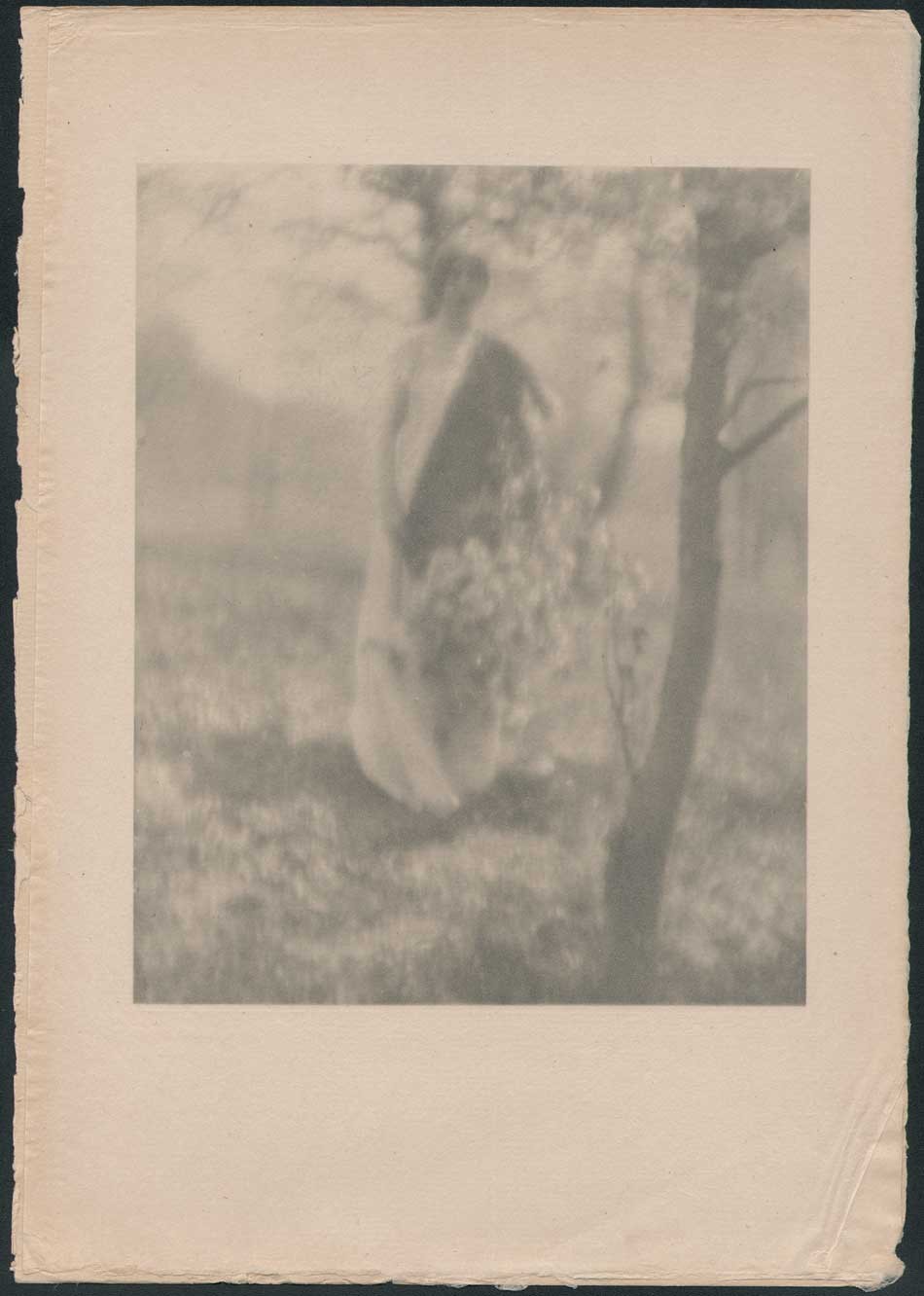 "Spring": George H. Seeley, American: hand-pulled Japan-paper tissue photogravure by the Manhattan Photogravure Co. included with Camera Work issue XXIX, January 1910: 19.7 x 15.8 | 29.7 x 20.6 cm | 30.0 x 21.0 cm- Enfield 1887 watermarked laid paper mount: A review in the February 25, 1910 issue of The British Journal of Photography discusses the ten photogravure plates by Seeley included with CW 29, and singles out this spring study with female model at the critique's conclusion: "Of the plates, the ten photogravures after photographs, by George H. Seeley, are remarkably rich examples of that idle sort of decorative toying with photography which “Camera Work" has always fostered. Mr. Seeley’s technical powers are very considerable. He is master enough to take great liberties with focussing, and does so with impunity; but the greatest enthusiast in art for art’s sake must admit that the subject-matter of Mr. Seeley's work is trivial and tiresome. "Girl with Bowl” is well designed and of exquisite quality. “Autumn" introduces a tambourine and bulrushes, with an inexplicable pose of the model. “The White Screen" shows the lady out of doors, dappled with the shadow from a tree. This is a charming study in tones. Next follow two subjects introducing an artist's palette—the first ridiculous and the next mystifying. Then comes a male nude of no attractions. “White Trees" and “Spring,” by their lightness and delicacy of tones, and the beauty of their suggestion, are, in our opinion, the best pictures of all. In the last two, the photographer’s title resources give out, and he contents himself with calling them No. 347 and No. 356. They do not suffer thereby. No. 356 is truly decorative, and shows us that Mr. Seeley has imbibed good ideas from the classics in painting."(p. 147: there is confusion as to the above numbers: a flysheet includes the pagination as plates VII (White Trees.) & VIII (Spring.): From: PhotoSeed Archive
"Spring": George H. Seeley, American: hand-pulled Japan-paper tissue photogravure by the Manhattan Photogravure Co. included with Camera Work issue XXIX, January 1910: 19.7 x 15.8 | 29.7 x 20.6 cm | 30.0 x 21.0 cm- Enfield 1887 watermarked laid paper mount: A review in the February 25, 1910 issue of The British Journal of Photography discusses the ten photogravure plates by Seeley included with CW 29, and singles out this spring study with female model at the critique's conclusion: "Of the plates, the ten photogravures after photographs, by George H. Seeley, are remarkably rich examples of that idle sort of decorative toying with photography which “Camera Work" has always fostered. Mr. Seeley’s technical powers are very considerable. He is master enough to take great liberties with focussing, and does so with impunity; but the greatest enthusiast in art for art’s sake must admit that the subject-matter of Mr. Seeley's work is trivial and tiresome. "Girl with Bowl” is well designed and of exquisite quality. “Autumn" introduces a tambourine and bulrushes, with an inexplicable pose of the model. “The White Screen" shows the lady out of doors, dappled with the shadow from a tree. This is a charming study in tones. Next follow two subjects introducing an artist's palette—the first ridiculous and the next mystifying. Then comes a male nude of no attractions. “White Trees" and “Spring,” by their lightness and delicacy of tones, and the beauty of their suggestion, are, in our opinion, the best pictures of all. In the last two, the photographer’s title resources give out, and he contents himself with calling them No. 347 and No. 356. They do not suffer thereby. No. 356 is truly decorative, and shows us that Mr. Seeley has imbibed good ideas from the classics in painting."(p. 147: there is confusion as to the above numbers: a flysheet includes the pagination as plates VII (White Trees.) & VIII (Spring.): From: PhotoSeed Archive
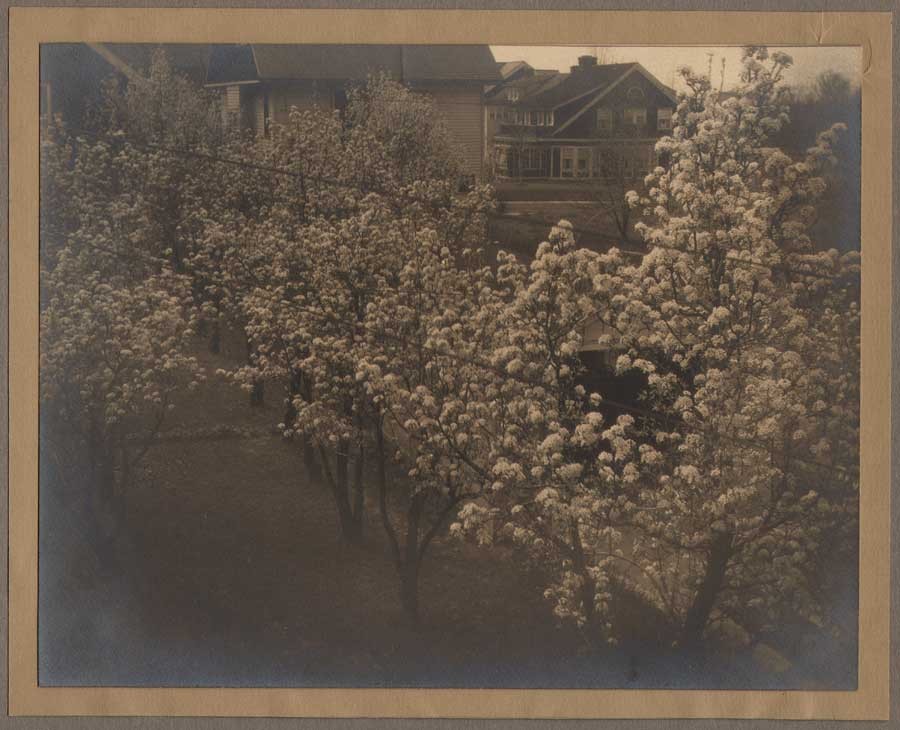 "Backyard Apple Trees Blossoming": Leo Kraft, (1885-1927) American: gelatin silver print, ca. 1915-20: 19.0 24.3 | 21.0 26.1 | 33.0 x 39.3 cm. This photograph most likely picture's the backyard area of the photographer's Lakewood, Ohio home outside Cleveland showing a double-line of flowering apple or crabapple trees. The print is believed to be printed on Kodak's P. M. C. Bromide (double weight) paper like other known examples by Kraft in this archive.: From: PhotoSeed Archive
"Backyard Apple Trees Blossoming": Leo Kraft, (1885-1927) American: gelatin silver print, ca. 1915-20: 19.0 24.3 | 21.0 26.1 | 33.0 x 39.3 cm. This photograph most likely picture's the backyard area of the photographer's Lakewood, Ohio home outside Cleveland showing a double-line of flowering apple or crabapple trees. The print is believed to be printed on Kodak's P. M. C. Bromide (double weight) paper like other known examples by Kraft in this archive.: From: PhotoSeed Archive
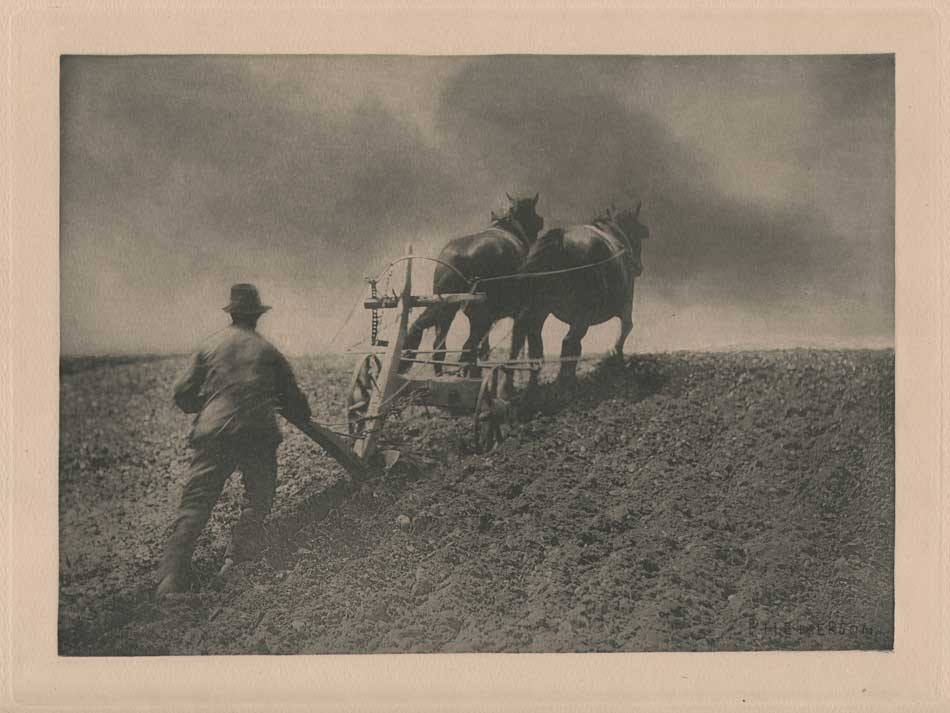 "A Stiff Pull": Peter Henry Emerson: British, born Cuba: hand-pulled photogravure by the photographer included in his limited, second-edition portfolio "Pictures of East Anglian Life": 1890: 20.7 x 28.8 | 34.1 x 42.6 cm: A farmer guides a plow behind a team of two horses as he tills the earth in the English spring countryside. England's Victoria & Albert Museum notes of this work included with this portfolio: "In 1889 Emerson published his controversial book 'Naturalistic Photography for Students of the Art' without images. 'Naturalistic Photography' examined his purist approach to photography, derived from his fascination with Naturalism in art, and attacked the prevailing artificial aesthetic in art photography. After its publication Emerson felt that his opponents had misunderstood his ideas. So, in 1890 he selected 10 plates from his book 'Pictures of East Anglian Life' (1888) that best illustrated his theories, and presented them loose in a portfolio dedicated to the ‘photographic student’, with the same title and cover of the book. He then donated copies of this portfolio to every photographic society in the country." Included in the work as plate III, "A Stiff Pull" is also reproduced as a line engraving on the oversized canvas board folio, but with the odd inclusion of the ocean with sailboats and gulls flying overhead on the horizon. From: PhotoSeed Archive
"A Stiff Pull": Peter Henry Emerson: British, born Cuba: hand-pulled photogravure by the photographer included in his limited, second-edition portfolio "Pictures of East Anglian Life": 1890: 20.7 x 28.8 | 34.1 x 42.6 cm: A farmer guides a plow behind a team of two horses as he tills the earth in the English spring countryside. England's Victoria & Albert Museum notes of this work included with this portfolio: "In 1889 Emerson published his controversial book 'Naturalistic Photography for Students of the Art' without images. 'Naturalistic Photography' examined his purist approach to photography, derived from his fascination with Naturalism in art, and attacked the prevailing artificial aesthetic in art photography. After its publication Emerson felt that his opponents had misunderstood his ideas. So, in 1890 he selected 10 plates from his book 'Pictures of East Anglian Life' (1888) that best illustrated his theories, and presented them loose in a portfolio dedicated to the ‘photographic student’, with the same title and cover of the book. He then donated copies of this portfolio to every photographic society in the country." Included in the work as plate III, "A Stiff Pull" is also reproduced as a line engraving on the oversized canvas board folio, but with the odd inclusion of the ocean with sailboats and gulls flying overhead on the horizon. From: PhotoSeed Archive
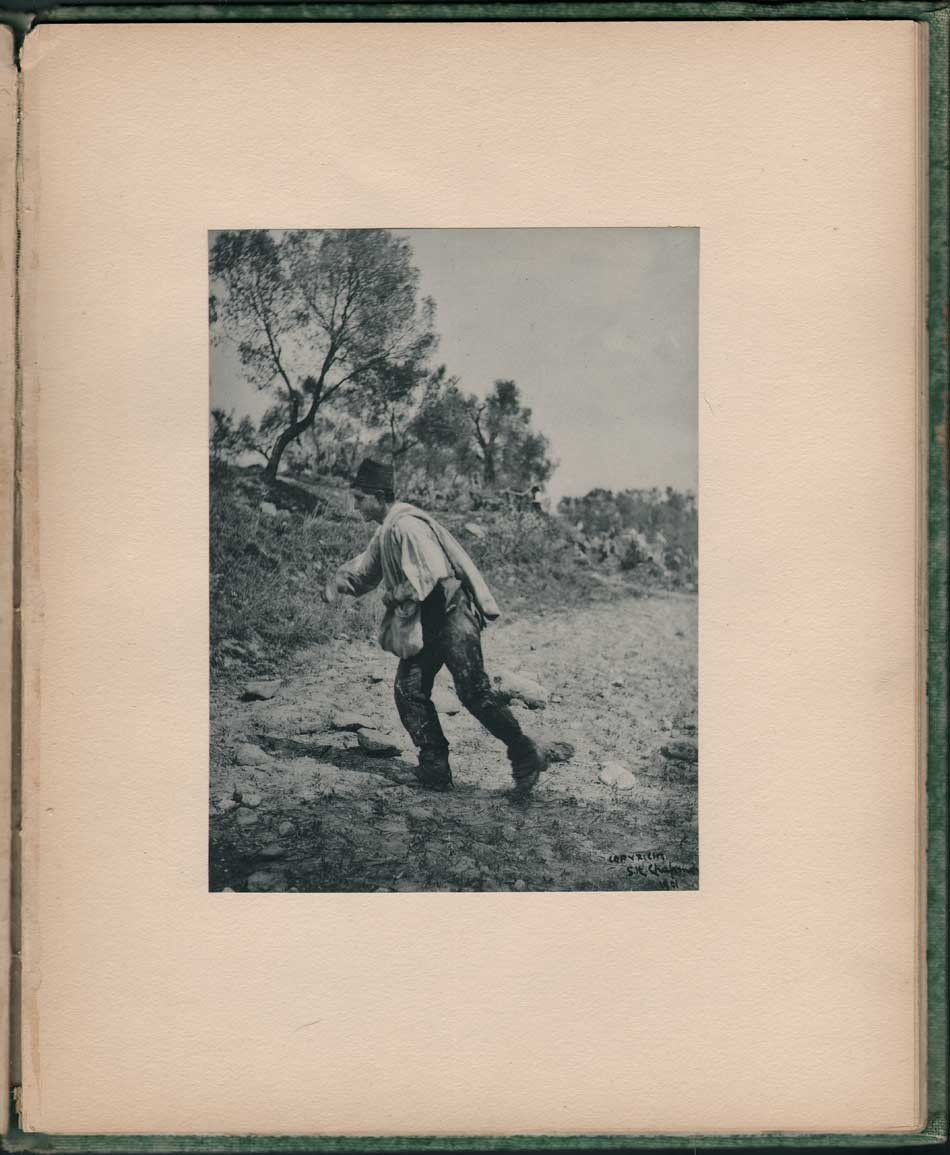 "Some fell upon Stony Places,…": Samuel Hudson Chapman, American (1857-1931): platinum print included in his self-published volume: "The Parable of the Sower, Illustrated From Life, With The Series of Pictures Awarded The Allison Silver Cup of the Photographic Society of Philadelphia For the Year 1900: S.H. & H. Chapman 1348 Pine Street, 1901: 18.8 x 13.9 corner-glued | 31.5 x 25.4 cm: A dealer in rare coins along with his brother Henry, Philadelphia resident Samuel Hudson Chapman was also an accomplished photographer and president of the Photographic Society of Philadelphia at the time he published this volume which included this photograph in 1901. Showing a farmhand sowing seeds in the springtime, most likely done in the Italian countryside, the following copy accompanies the work opposite, from the King James Version of the Bible's Book of Matthew: "Some fell upon Stony Places, where they had not much earth: and forthwith they sprung up, because they had no deepness of earth; and when the sun was up, they were scorched; and because they had no root, they withered away." From: PhotoSeed Archive
"Some fell upon Stony Places,…": Samuel Hudson Chapman, American (1857-1931): platinum print included in his self-published volume: "The Parable of the Sower, Illustrated From Life, With The Series of Pictures Awarded The Allison Silver Cup of the Photographic Society of Philadelphia For the Year 1900: S.H. & H. Chapman 1348 Pine Street, 1901: 18.8 x 13.9 corner-glued | 31.5 x 25.4 cm: A dealer in rare coins along with his brother Henry, Philadelphia resident Samuel Hudson Chapman was also an accomplished photographer and president of the Photographic Society of Philadelphia at the time he published this volume which included this photograph in 1901. Showing a farmhand sowing seeds in the springtime, most likely done in the Italian countryside, the following copy accompanies the work opposite, from the King James Version of the Bible's Book of Matthew: "Some fell upon Stony Places, where they had not much earth: and forthwith they sprung up, because they had no deepness of earth; and when the sun was up, they were scorched; and because they had no root, they withered away." From: PhotoSeed Archive
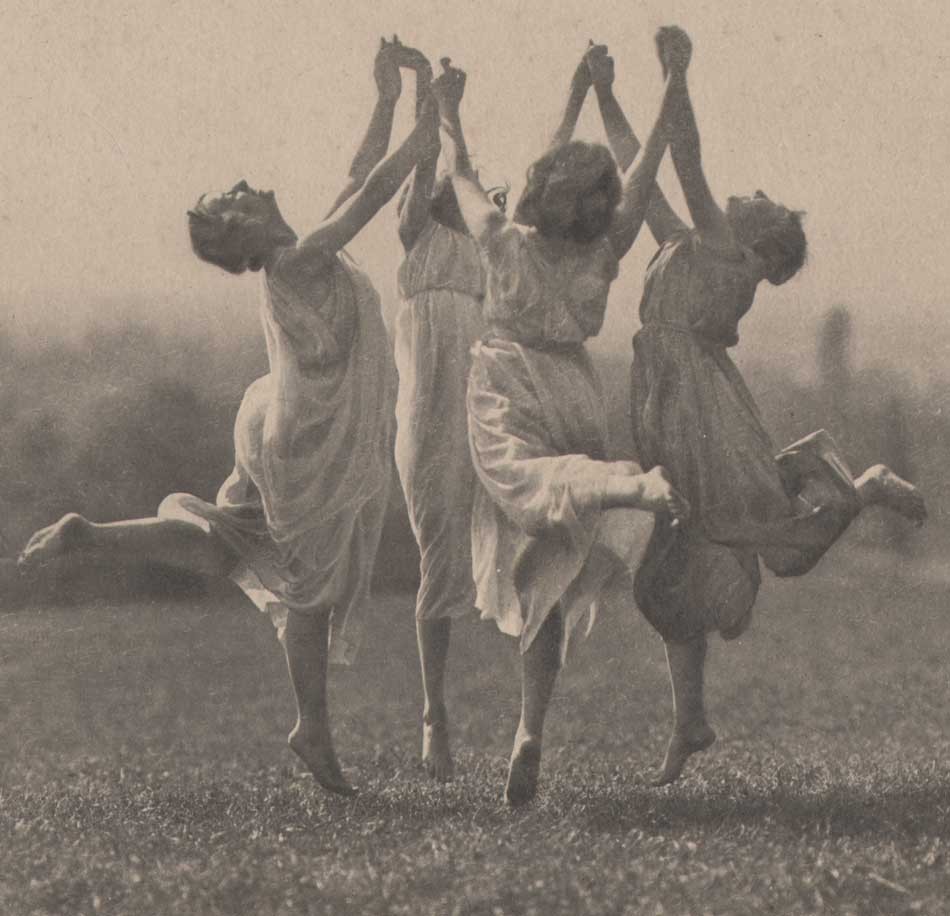 Detail: "Vers L'Idéal, Jeunes Filles Dansant : "Towards the Ideal, Young Girls Dancing" : Frederick Boissonnas, Swiss (1858-1946): hand-pulled photogravure by Munich's Verlagsanstalt F. Bruckmann A.-G. : 1911: 21.2 x 29.2 | 26.3 x 36.6 cm: Suggestive of an exuberant ritual acknowledging rebirth in spring, this photographic study of four female dancers can be dated to around 1911, when it was titled Vers L'Ideal "Towards the Ideal" and exhibited as part of the London Salon of Photography, where it was shown cropped to the central figures. These dancers were students attending a school teaching the "Dalcroze Method" of music pedagogy in Hellerau, Germany, now part of Dresden. The school was founded in 1910 by the Swiss composer, musician and music educator Émile Jaques-Dalcroze. (1865-1950) From: PhotoSeed Archive
Detail: "Vers L'Idéal, Jeunes Filles Dansant : "Towards the Ideal, Young Girls Dancing" : Frederick Boissonnas, Swiss (1858-1946): hand-pulled photogravure by Munich's Verlagsanstalt F. Bruckmann A.-G. : 1911: 21.2 x 29.2 | 26.3 x 36.6 cm: Suggestive of an exuberant ritual acknowledging rebirth in spring, this photographic study of four female dancers can be dated to around 1911, when it was titled Vers L'Ideal "Towards the Ideal" and exhibited as part of the London Salon of Photography, where it was shown cropped to the central figures. These dancers were students attending a school teaching the "Dalcroze Method" of music pedagogy in Hellerau, Germany, now part of Dresden. The school was founded in 1910 by the Swiss composer, musician and music educator Émile Jaques-Dalcroze. (1865-1950) From: PhotoSeed Archive
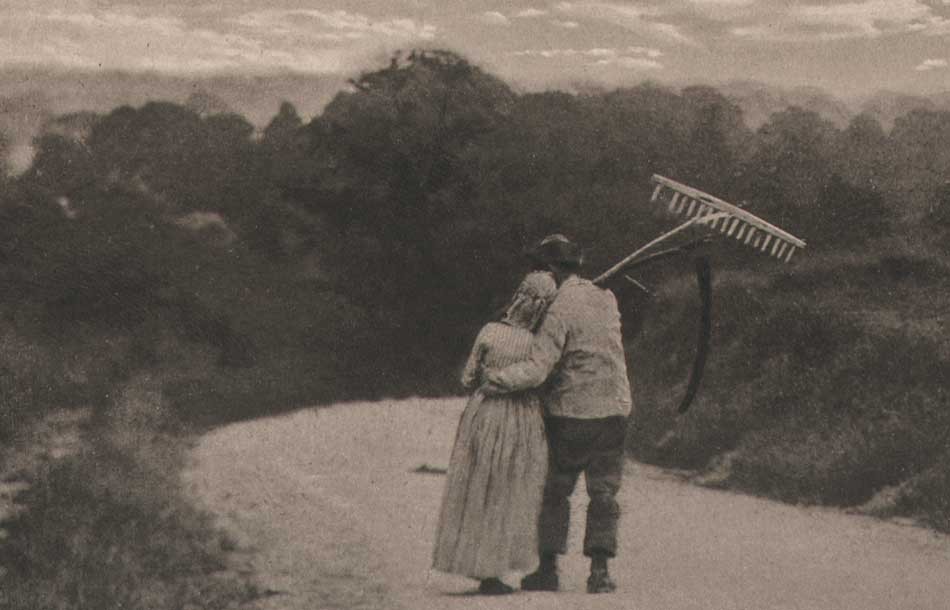 Detail: "Sweet Springtime" : Ralph Winwood-Robinson, English (1862-1942): hand-pulled, Chine-collé edition photogravure from limited-edition portfolio "Amateur-Kunst: 37 Photogravuren Nach Naturaufnahmen" (Amateur Art: 37 photo Engravings after nature Photographs) published by Richard Paulussen at Vienna's Gesellschaft für Vervielfältigende Kunst: 1891: 20.6 x 26.8 | 35.6 x 48.2 cm: Titled "Sweet Springtime", this romantic landscape genre study showing a couple walking together (please see this website for uncropped version) down a road past a windmill was taken by the son of renowned English photographer Henry Peach Robinson. It was exhibited in Vienna during the groundbreaking 1891 "Internationale Ausstellung Künstlerischer Photographien" (International Exhibition of Art Photographers) organized by the Club of Amateur Photographers in Austria (Club der Amateur Photographen in Wien) the same year.: From: PhotoSeed Archive
Detail: "Sweet Springtime" : Ralph Winwood-Robinson, English (1862-1942): hand-pulled, Chine-collé edition photogravure from limited-edition portfolio "Amateur-Kunst: 37 Photogravuren Nach Naturaufnahmen" (Amateur Art: 37 photo Engravings after nature Photographs) published by Richard Paulussen at Vienna's Gesellschaft für Vervielfältigende Kunst: 1891: 20.6 x 26.8 | 35.6 x 48.2 cm: Titled "Sweet Springtime", this romantic landscape genre study showing a couple walking together (please see this website for uncropped version) down a road past a windmill was taken by the son of renowned English photographer Henry Peach Robinson. It was exhibited in Vienna during the groundbreaking 1891 "Internationale Ausstellung Künstlerischer Photographien" (International Exhibition of Art Photographers) organized by the Club of Amateur Photographers in Austria (Club der Amateur Photographen in Wien) the same year.: From: PhotoSeed Archive
Blue Prince
Posted March 2016 in Alternate Processes, Childhood Photography, Exhibitions, History of Photography, Unknown Photographers, Unknown Photographs
Discovering a needle in a haystack, with apologies to this farmhand happily lounging atop a salt marsh haystack before the turn of the 20th century, is the proverbial sensation one beholds when encountering a fine blueprint, or cyanotype photograph, for the first time.
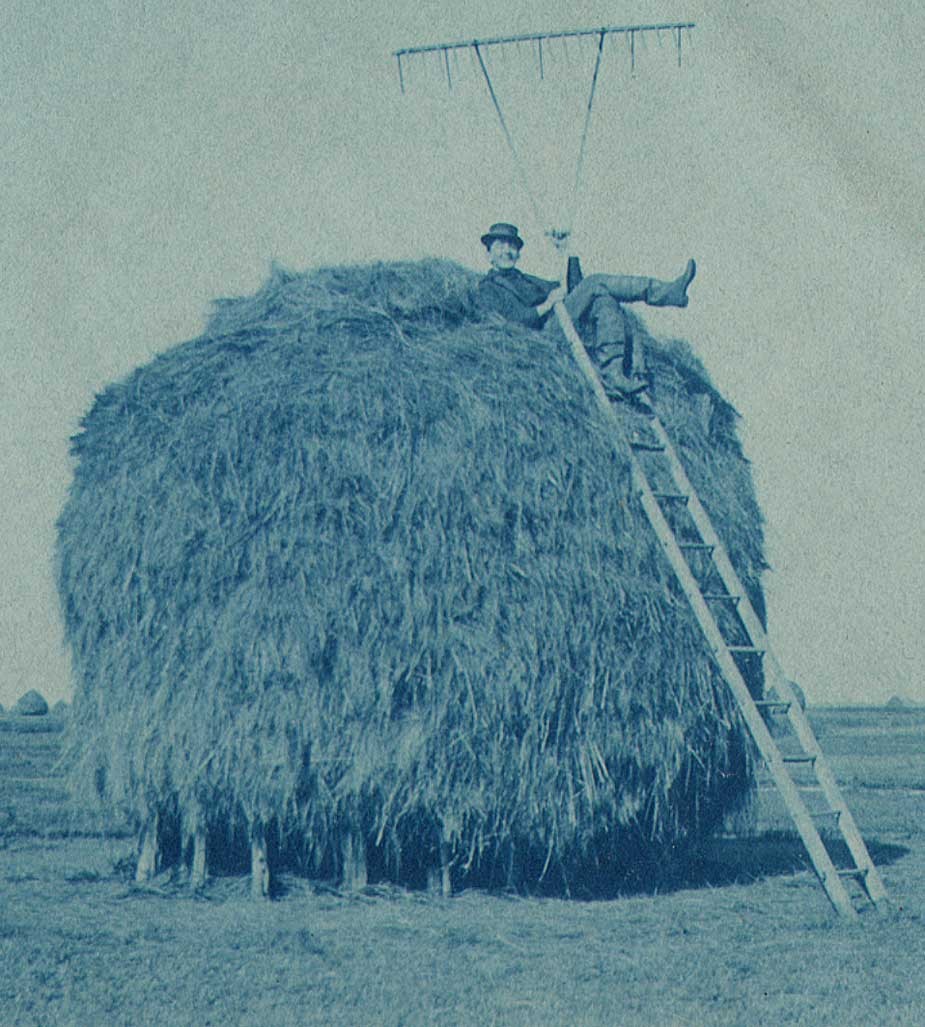 Detail: "Farmhand atop Salt Marsh Haystack" : anonymous American photographer: cyanotype: 1895-1900: 8.7 x 12.0 cm: The location of this photograph has been determined to be Plum Island in Newburyport, Mass, on Boston's North Shore. The marshes, in a tidal zone on the Atlantic ocean, is where salt marsh hay grows and then harvested. The farmhand would first use the wooden drag rake to collect the cut hay into piles. It would then be gathered and piled into layers above a platform (seen at bottom of photo) made from cedar wood staddles. This form of haystack making dates from the 17th Century is still practiced in the area in the present day. From: PhotoSeed Archive
Detail: "Farmhand atop Salt Marsh Haystack" : anonymous American photographer: cyanotype: 1895-1900: 8.7 x 12.0 cm: The location of this photograph has been determined to be Plum Island in Newburyport, Mass, on Boston's North Shore. The marshes, in a tidal zone on the Atlantic ocean, is where salt marsh hay grows and then harvested. The farmhand would first use the wooden drag rake to collect the cut hay into piles. It would then be gathered and piled into layers above a platform (seen at bottom of photo) made from cedar wood staddles. This form of haystack making dates from the 17th Century is still practiced in the area in the present day. From: PhotoSeed Archive
Given the excuse the Worcester Art Museum in Massachusetts is devoting significant wall space to their current exhibit: Cyanotypes: Photography’s Blue Period, (through April 24, 2016-publication here.) all while keeping with this institution’s admirable mission of presenting photography as an art form to the public since 1904, I’m mounting my own mini-exhibition of vintage cyanotypes from the PhotoSeed archive here with the added bonus of several photographs that literally embrace and further the definition of “blue print”. So like our “prince” above, whose raking abilities are indeed most impressive, here’s hoping your own photographic gatherings include finding the unique beauty these gems in blue offer.
-David Spencer, February, 2016
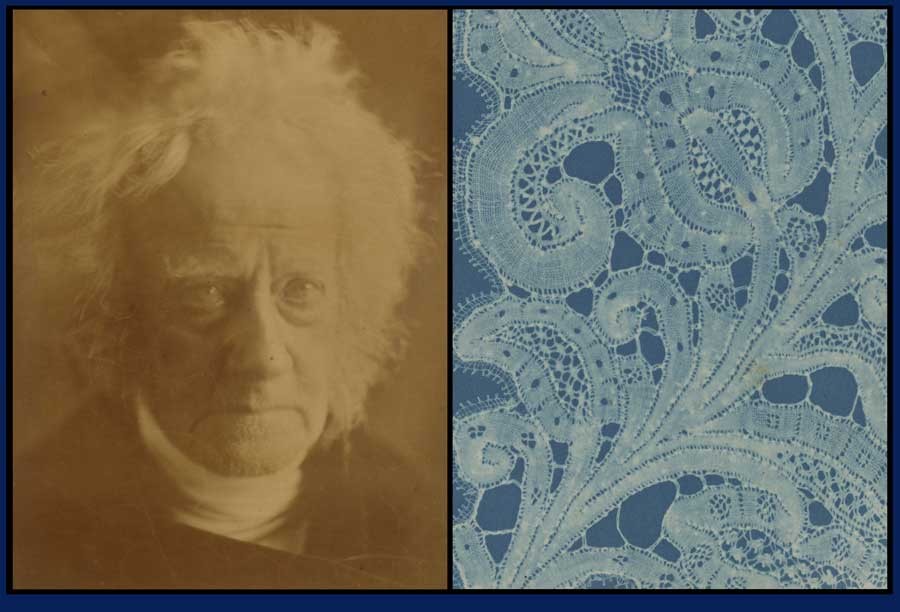 Left: Detail: "John Frederick William Herschel"(1792-1871): Julia Margaret Cameron: British: Albumen print: 1867: image: 35.5 x 27.1 cm (sight): The Cyanotype, or blueprint process, was first invented by John Herschel in 1842. It involves first exposing a negative, oftentimes through the contact print method with paper (or even cloth or another matrix) first treated with ammonium ferric citrate. In daylight, the matrix is then developed using a solution of potassium ferricyanide. The resulting print reveals itself as a brilliant blue hue known as Prussian blue. (ferric iron compounds being changed into ferrous iron). From: PhotoSeed Archive. Right: Detail: "Braid and Thread Lace": Julia Herschel: British : (1842-1933 ) : cyanotype: 1869 or before. It's intriguing to know the inventors daughter used the process herself (John Herschel was known to only use his blueprint process to reproduce notes and diagrams) to create artistic statements, like this original photograph bound with the volume: A Handbook for Greek and Roman Lace Making published in London in 1869 and printed by R. Barrett and Sons. From: Spencer Collection, The New York Public Library. "A handbook for Greek and Roman lace making" The New York Public Library Digital Collections. 1869. http://digitalcollections.nypl.org/items/7dd58e00-0898-0133-038f-58d385a7bbd0
Left: Detail: "John Frederick William Herschel"(1792-1871): Julia Margaret Cameron: British: Albumen print: 1867: image: 35.5 x 27.1 cm (sight): The Cyanotype, or blueprint process, was first invented by John Herschel in 1842. It involves first exposing a negative, oftentimes through the contact print method with paper (or even cloth or another matrix) first treated with ammonium ferric citrate. In daylight, the matrix is then developed using a solution of potassium ferricyanide. The resulting print reveals itself as a brilliant blue hue known as Prussian blue. (ferric iron compounds being changed into ferrous iron). From: PhotoSeed Archive. Right: Detail: "Braid and Thread Lace": Julia Herschel: British : (1842-1933 ) : cyanotype: 1869 or before. It's intriguing to know the inventors daughter used the process herself (John Herschel was known to only use his blueprint process to reproduce notes and diagrams) to create artistic statements, like this original photograph bound with the volume: A Handbook for Greek and Roman Lace Making published in London in 1869 and printed by R. Barrett and Sons. From: Spencer Collection, The New York Public Library. "A handbook for Greek and Roman lace making" The New York Public Library Digital Collections. 1869. http://digitalcollections.nypl.org/items/7dd58e00-0898-0133-038f-58d385a7bbd0
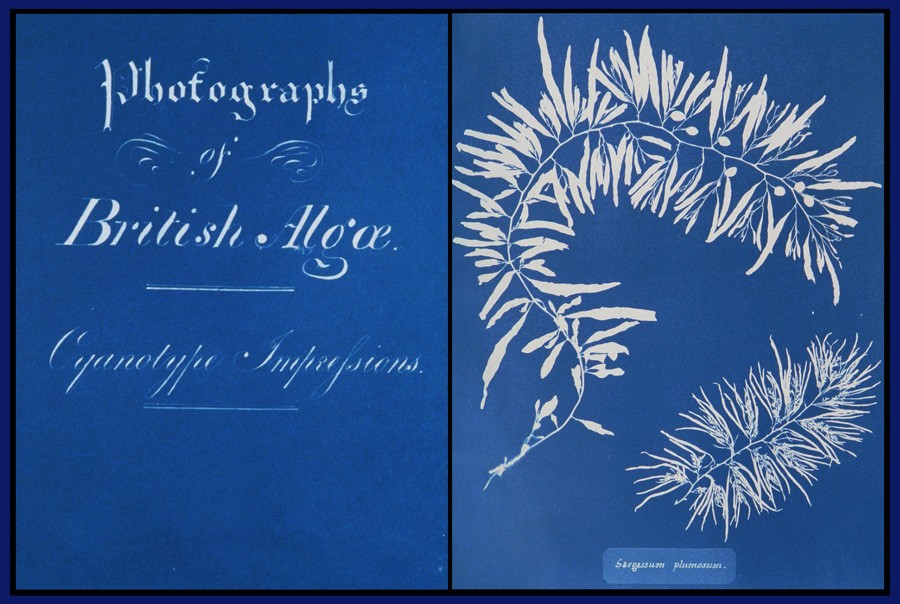 Left: Detail: "Title Page": from: Photographs of British Algae: Cyanotype Impressions: Anna Atkins: British: (1799-1871) : cyanotype: 1843-1853. This title page in the author's own hand is part of a multi-part volume of 231 original cyanotypes featuring contact prints of British seaweed specimens first copied on individual glass sheets by William Henry Fox Talbot's photogenic drawing method by Atkins and then reproduced by John Herschel's newly invented cyanotype or blueprinting process. The importance of the work is summed up by The New York Public Library, which owns this rare volume formerly in the library of Herschel: "Photographs of British Algae is a landmark in the histories both of photography and of publishing: the first photographic work by a woman, and the first book produced entirely by photographic means." From: Spencer Collection, The New York Public Library. "Titlepage." The New York Public Library Digital Collections. 1843 - 1853. http://digitalcollections.nypl.org/items/510d47d9-4af4-a3d9-e040-e00a18064a99. Right: Detail: "Sargassum plumosum":from: Photographs of British Algae: Cyanotype Impressions: Anna Atkins: British: (1799-1871) : cyanotype: 1843-1853. These beautiful seaweed specimens was the second plate in the pagination for Vol. 1 of "British Algae". From: Spencer Collection, The New York Public Library. "Sargassum plumosum." The New York Public Library Digital Collections. 1843 - 1853. http://digitalcollections.nypl.org/items/510d47d9-4af6-a3d9-e040-e00a18064a99
Left: Detail: "Title Page": from: Photographs of British Algae: Cyanotype Impressions: Anna Atkins: British: (1799-1871) : cyanotype: 1843-1853. This title page in the author's own hand is part of a multi-part volume of 231 original cyanotypes featuring contact prints of British seaweed specimens first copied on individual glass sheets by William Henry Fox Talbot's photogenic drawing method by Atkins and then reproduced by John Herschel's newly invented cyanotype or blueprinting process. The importance of the work is summed up by The New York Public Library, which owns this rare volume formerly in the library of Herschel: "Photographs of British Algae is a landmark in the histories both of photography and of publishing: the first photographic work by a woman, and the first book produced entirely by photographic means." From: Spencer Collection, The New York Public Library. "Titlepage." The New York Public Library Digital Collections. 1843 - 1853. http://digitalcollections.nypl.org/items/510d47d9-4af4-a3d9-e040-e00a18064a99. Right: Detail: "Sargassum plumosum":from: Photographs of British Algae: Cyanotype Impressions: Anna Atkins: British: (1799-1871) : cyanotype: 1843-1853. These beautiful seaweed specimens was the second plate in the pagination for Vol. 1 of "British Algae". From: Spencer Collection, The New York Public Library. "Sargassum plumosum." The New York Public Library Digital Collections. 1843 - 1853. http://digitalcollections.nypl.org/items/510d47d9-4af6-a3d9-e040-e00a18064a99
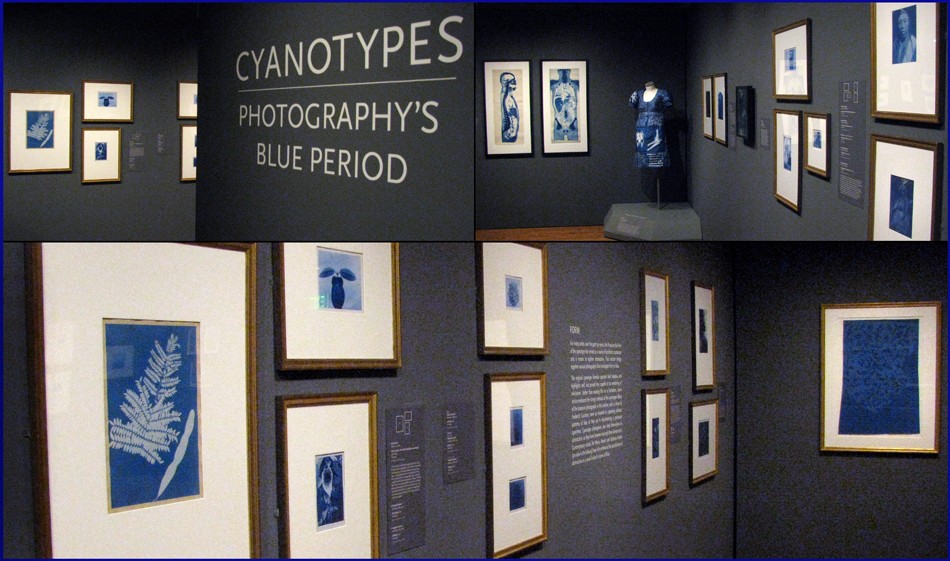 Composite: April, 2016 installation photographs from exhibit: "Cyanotypes: Photography's Blue Period" at the Worcester Art Museum in Worcester, MA. Running from January 16-April 24, 2016, the show was the first comprehensive exhibit on the medium of cyanotype ever held in the United States. Vintage examples from the museum's own holdings as well as loans from other institutions and private individuals spanned the period from the 1850's to the first decade of the 21st Century. The exhibit was curated by Nancy Kathryn Burns, Assistant Curator of Prints, Drawings, and Photographs at the museum & Kristina Wilson, Associate Professor of Art History, Clark University. Both additionally edited the volume: "Cyanotypes: Photography's Blue Period" published by the museum: ISBN# 978-0-936042-06-0. Installation photographs by David Spencer for PhotoSeed Archive
Composite: April, 2016 installation photographs from exhibit: "Cyanotypes: Photography's Blue Period" at the Worcester Art Museum in Worcester, MA. Running from January 16-April 24, 2016, the show was the first comprehensive exhibit on the medium of cyanotype ever held in the United States. Vintage examples from the museum's own holdings as well as loans from other institutions and private individuals spanned the period from the 1850's to the first decade of the 21st Century. The exhibit was curated by Nancy Kathryn Burns, Assistant Curator of Prints, Drawings, and Photographs at the museum & Kristina Wilson, Associate Professor of Art History, Clark University. Both additionally edited the volume: "Cyanotypes: Photography's Blue Period" published by the museum: ISBN# 978-0-936042-06-0. Installation photographs by David Spencer for PhotoSeed Archive
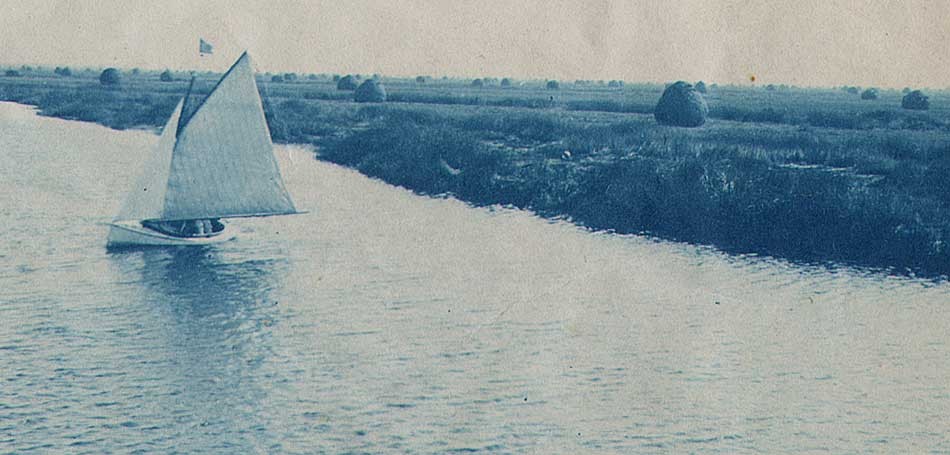 Detail: "Sailboat near Plum Island" : anonymous American photographer: cyanotype: 1895-1900: 9.2 x 12.5 cm: The location of this photograph has been determined to be Plum Island Sound (the Parker River) in Newburyport, Mass, on Boston's North Shore. In the distance can be seen many salt marsh haystacks. From: PhotoSeed Archive
Detail: "Sailboat near Plum Island" : anonymous American photographer: cyanotype: 1895-1900: 9.2 x 12.5 cm: The location of this photograph has been determined to be Plum Island Sound (the Parker River) in Newburyport, Mass, on Boston's North Shore. In the distance can be seen many salt marsh haystacks. From: PhotoSeed Archive
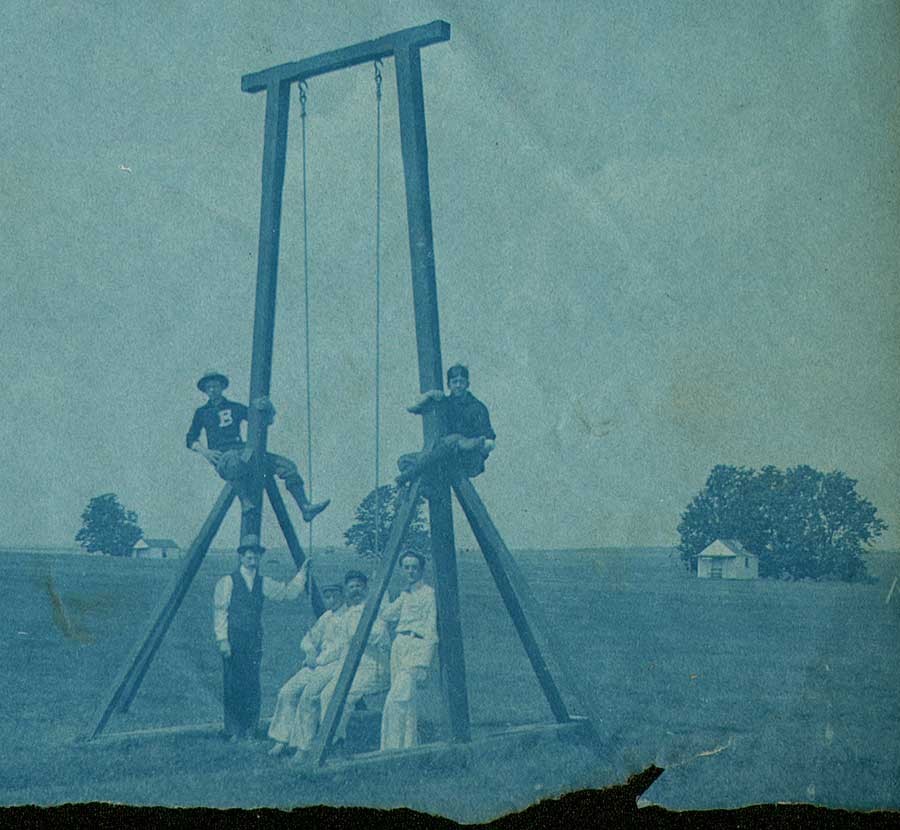 Detail: "Portrait Grouping with Tall Wooden Swing" : anonymous American photographer: cyanotype: 1895-1900: 8.5 x 11.5 cm: Most likely taken within the Plum Island area of Newburyport, Mass., (by the same photographer as it was included in small album of views as previous post photographs) this intriguing photograph shows an oversized wooden swing within a mowed field. One theory for the size of this swing would be because tidal changes could submerge the structure. Note lower margin of photograph where it was torn to fit a pre-cut window within a small album. From: PhotoSeed Archive
Detail: "Portrait Grouping with Tall Wooden Swing" : anonymous American photographer: cyanotype: 1895-1900: 8.5 x 11.5 cm: Most likely taken within the Plum Island area of Newburyport, Mass., (by the same photographer as it was included in small album of views as previous post photographs) this intriguing photograph shows an oversized wooden swing within a mowed field. One theory for the size of this swing would be because tidal changes could submerge the structure. Note lower margin of photograph where it was torn to fit a pre-cut window within a small album. From: PhotoSeed Archive
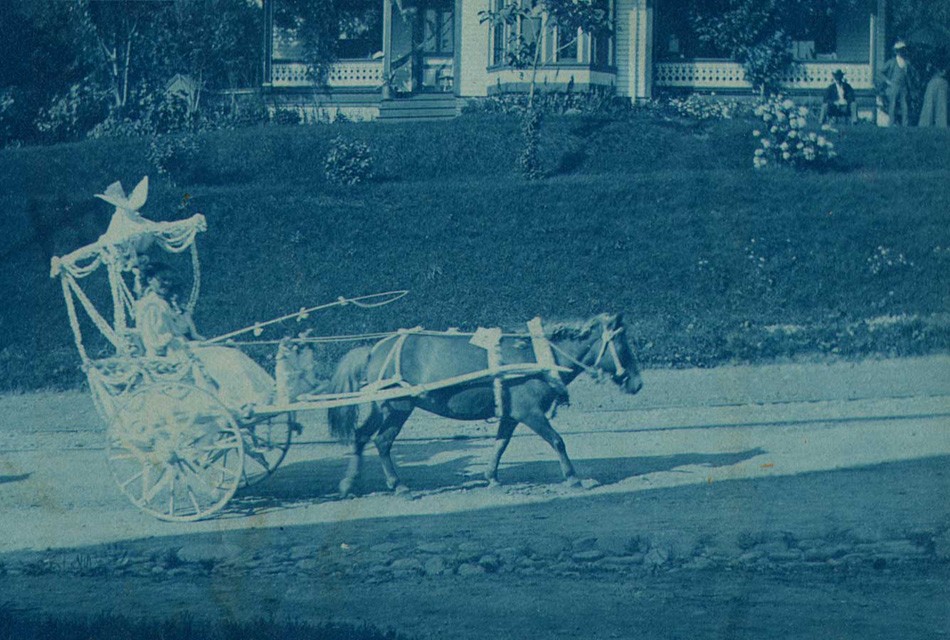 Detail: "Pony Cart in Parade" : anonymous American photographer: cyanotype: 1895-1900: 8.8 x 11.4 cm: Most likely taken in or near Newburyport, Mass., (by the same photographer as it was included in small album of views as previous post photographs) this slice of small-town American life shows a pony pulling a floral-decorated cart guided by a young lady traveling down a dirt road, perhaps on Memorial Day. Above can be seen a Victorian home with three parade watchers who stand at upper right. A set of trolley tracks can be seen in road beyond horse. From: PhotoSeed Archive
Detail: "Pony Cart in Parade" : anonymous American photographer: cyanotype: 1895-1900: 8.8 x 11.4 cm: Most likely taken in or near Newburyport, Mass., (by the same photographer as it was included in small album of views as previous post photographs) this slice of small-town American life shows a pony pulling a floral-decorated cart guided by a young lady traveling down a dirt road, perhaps on Memorial Day. Above can be seen a Victorian home with three parade watchers who stand at upper right. A set of trolley tracks can be seen in road beyond horse. From: PhotoSeed Archive
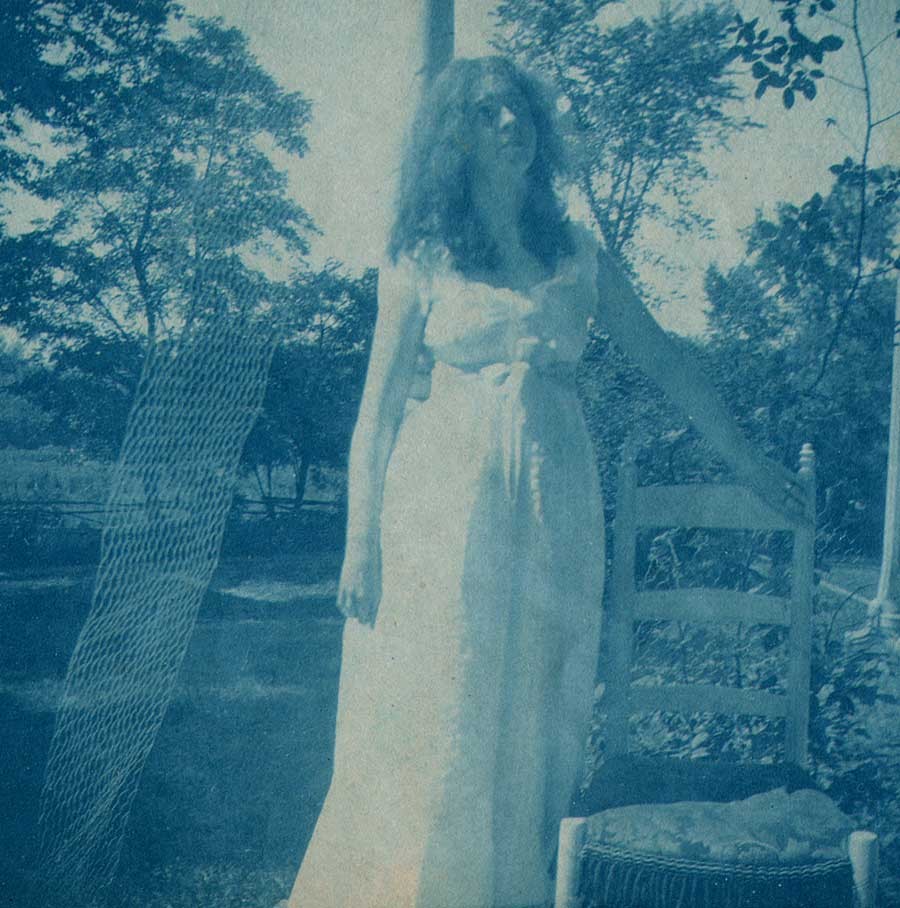 Detail: "Woman in White Dress Standing next to Chair" : anonymous American photographer: cyanotype: 1895-1900: 8.3 x 8.5 cm: Her name perhaps lost to history, a young woman wearing a white dress stands on a porch and looks away from the camera: a most unusual genre pose indicating she may have been playing a role of some type: for a play? or as an honored guest who had taken part in the parade depicted in the previous photograph? This view also likely taken in or near Newburyport, Mass. (and was included in the same small album of views as previous post photographs) From: PhotoSeed Archive
Detail: "Woman in White Dress Standing next to Chair" : anonymous American photographer: cyanotype: 1895-1900: 8.3 x 8.5 cm: Her name perhaps lost to history, a young woman wearing a white dress stands on a porch and looks away from the camera: a most unusual genre pose indicating she may have been playing a role of some type: for a play? or as an honored guest who had taken part in the parade depicted in the previous photograph? This view also likely taken in or near Newburyport, Mass. (and was included in the same small album of views as previous post photographs) From: PhotoSeed Archive
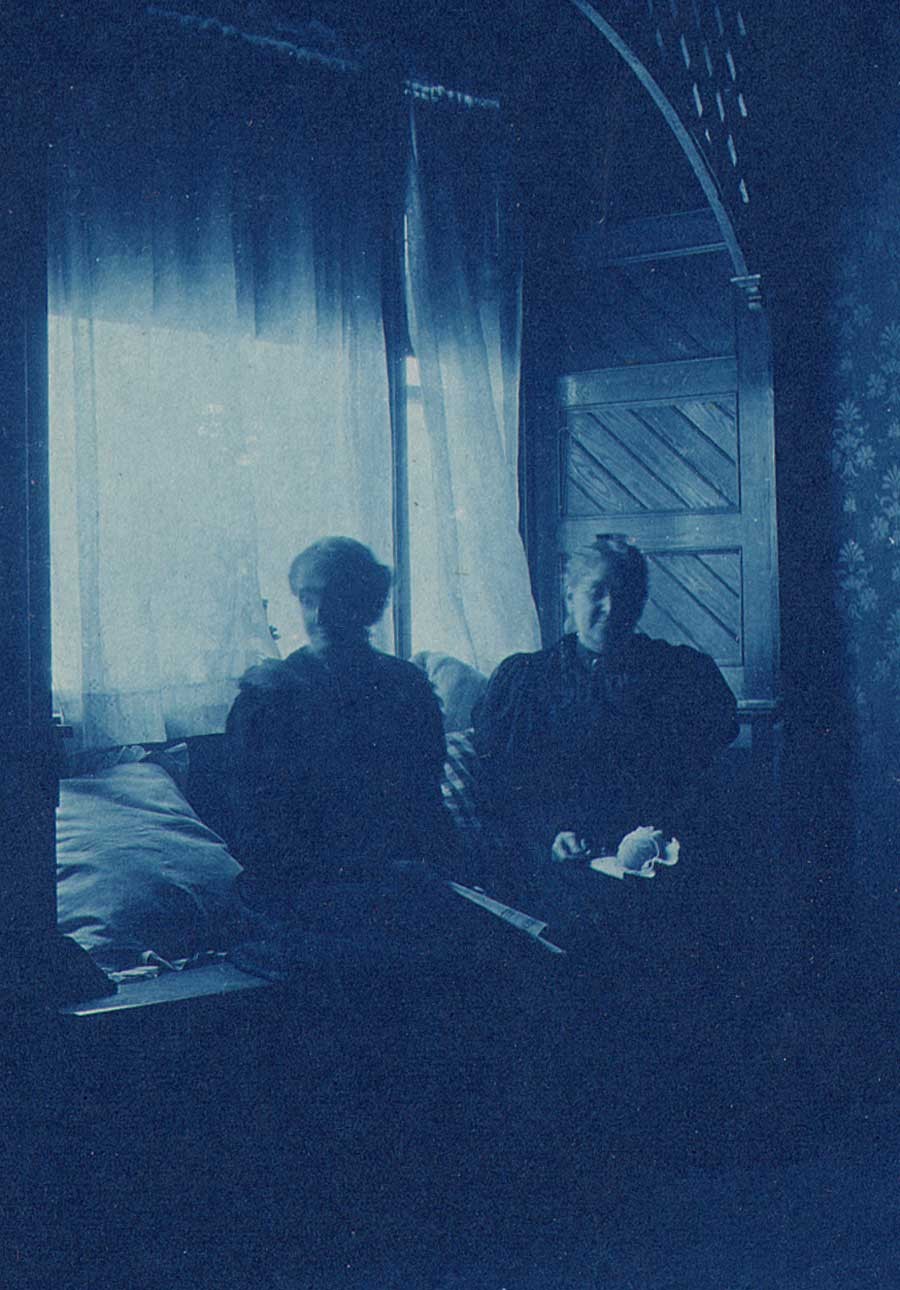 Detail: "Portrait Study near Window" : anonymous American photographer: cyanotype: 1899: 9.7 x 6.3 cm: Most likely sisters, this moody interior portrait is unusual for amateur work of the period because the photographer instructed his subjects to avert their gaze to the camera. The woman at left holds what is believed to be a folded fan while her companion holds a ball of yarn in her lap. Photograph may have been additionally printed on commercially available presensitized Venus paper manufactured by the Peerless Blue Print Co., as it was included in a cardboard box of this brand with an expiration date of 1899. Location for this image may have been the midwestern United States, as it was included in this Peerless box of loose cyanotypes purchased from an Indiana seller. From: PhotoSeed Archive
Detail: "Portrait Study near Window" : anonymous American photographer: cyanotype: 1899: 9.7 x 6.3 cm: Most likely sisters, this moody interior portrait is unusual for amateur work of the period because the photographer instructed his subjects to avert their gaze to the camera. The woman at left holds what is believed to be a folded fan while her companion holds a ball of yarn in her lap. Photograph may have been additionally printed on commercially available presensitized Venus paper manufactured by the Peerless Blue Print Co., as it was included in a cardboard box of this brand with an expiration date of 1899. Location for this image may have been the midwestern United States, as it was included in this Peerless box of loose cyanotypes purchased from an Indiana seller. From: PhotoSeed Archive
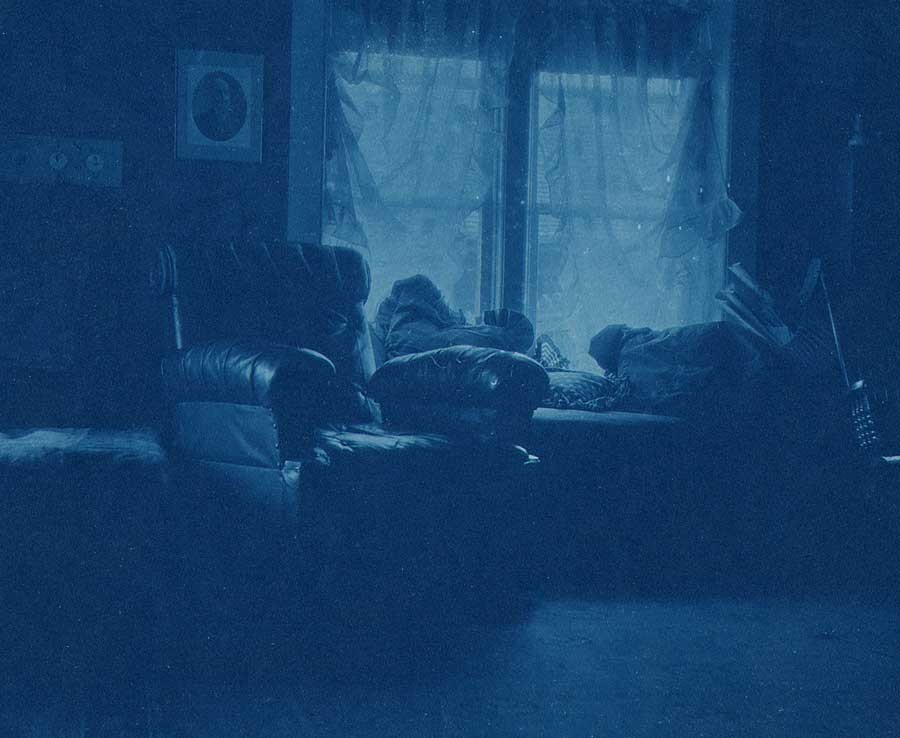 Detail: "Favorite Chair near Window" : anonymous American photographer: cyanotype: 1899: 9.4 x 12.0 cm: Another moody interior portrait, this time absent of any human subjects, is nonetheless interesting due to the feeling it evokes with the framed portrait of the bearded gentleman on the wall above what might be or was his favorite living room cushioned chair. Photograph may have been additionally printed on commercially available presensitized Venus paper manufactured by the Peerless Blue Print Co., as it was included in a cardboard box of this brand with an expiration date of 1899. Location for this image may have been the midwestern United States, as it was included in this Peerless box of loose cyanotypes purchased from an Indiana seller. From: PhotoSeed Archive
Detail: "Favorite Chair near Window" : anonymous American photographer: cyanotype: 1899: 9.4 x 12.0 cm: Another moody interior portrait, this time absent of any human subjects, is nonetheless interesting due to the feeling it evokes with the framed portrait of the bearded gentleman on the wall above what might be or was his favorite living room cushioned chair. Photograph may have been additionally printed on commercially available presensitized Venus paper manufactured by the Peerless Blue Print Co., as it was included in a cardboard box of this brand with an expiration date of 1899. Location for this image may have been the midwestern United States, as it was included in this Peerless box of loose cyanotypes purchased from an Indiana seller. From: PhotoSeed Archive
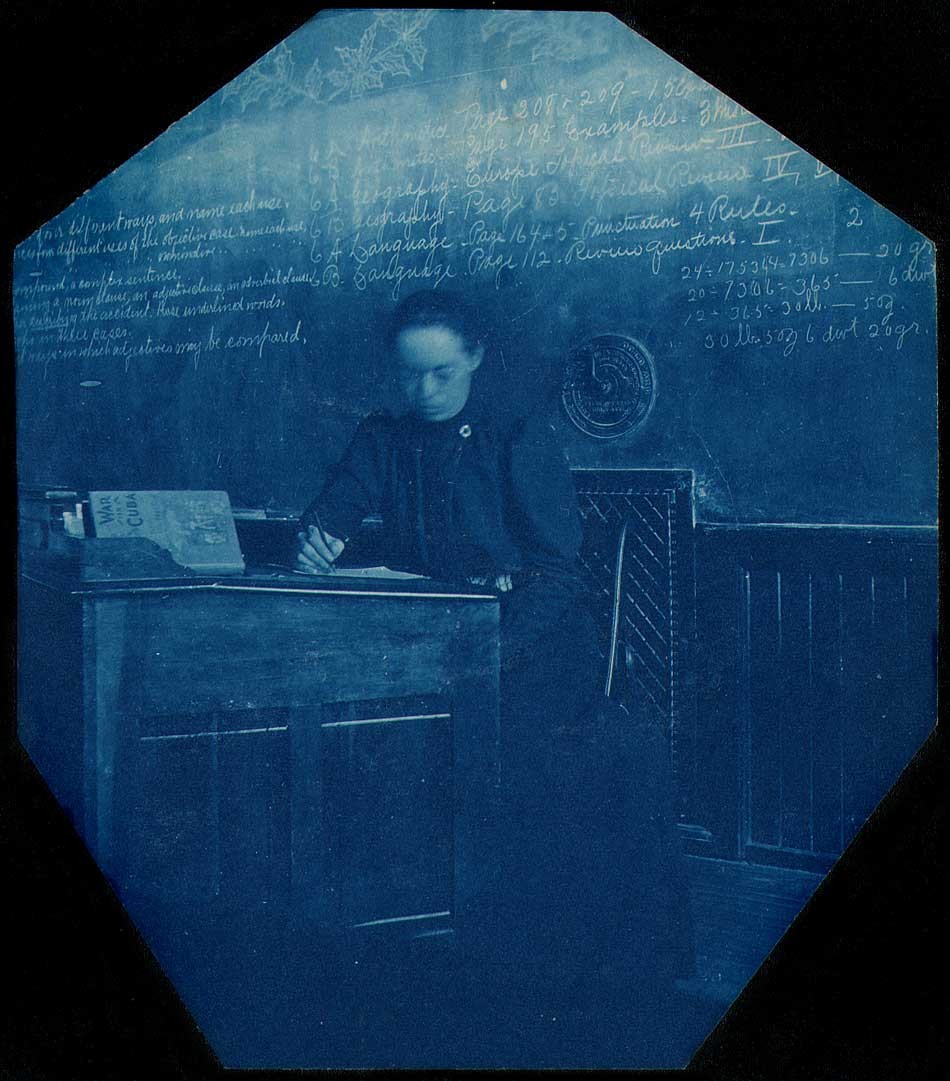 "Schoolteacher at Desk" : anonymous American photographer: cyanotype: 1899 or before: 10.5 x 9.1 cm: With slight motion blur seen in her face, a schoolteacher holding a pencil works on papers at her desk in front of a large blackboard listing student lesson plans including Arithmetic, Geography (Europe topical review) and Language, (Punctuation-4 rules) with additional lesson plans at left outlining sentence structures. The 1896 volume: The War in Cuba, Being a Full Account of Her Great Struggle for Freedom can be seen on the desk at left. A chalk drawing of holly leaves is at very top of blackboard, so view may date to the Christmas holiday of 1898. Photograph may have been additionally printed on commercially available presensitized Venus paper manufactured by the Peerless Blue Print Co., as it was included in a cardboard box of this brand with an expiration date of 1899. Location may have been the midwestern U.S., as it was purchased with other cyanotypes from an Indiana seller. From: PhotoSeed Archive
"Schoolteacher at Desk" : anonymous American photographer: cyanotype: 1899 or before: 10.5 x 9.1 cm: With slight motion blur seen in her face, a schoolteacher holding a pencil works on papers at her desk in front of a large blackboard listing student lesson plans including Arithmetic, Geography (Europe topical review) and Language, (Punctuation-4 rules) with additional lesson plans at left outlining sentence structures. The 1896 volume: The War in Cuba, Being a Full Account of Her Great Struggle for Freedom can be seen on the desk at left. A chalk drawing of holly leaves is at very top of blackboard, so view may date to the Christmas holiday of 1898. Photograph may have been additionally printed on commercially available presensitized Venus paper manufactured by the Peerless Blue Print Co., as it was included in a cardboard box of this brand with an expiration date of 1899. Location may have been the midwestern U.S., as it was purchased with other cyanotypes from an Indiana seller. From: PhotoSeed Archive
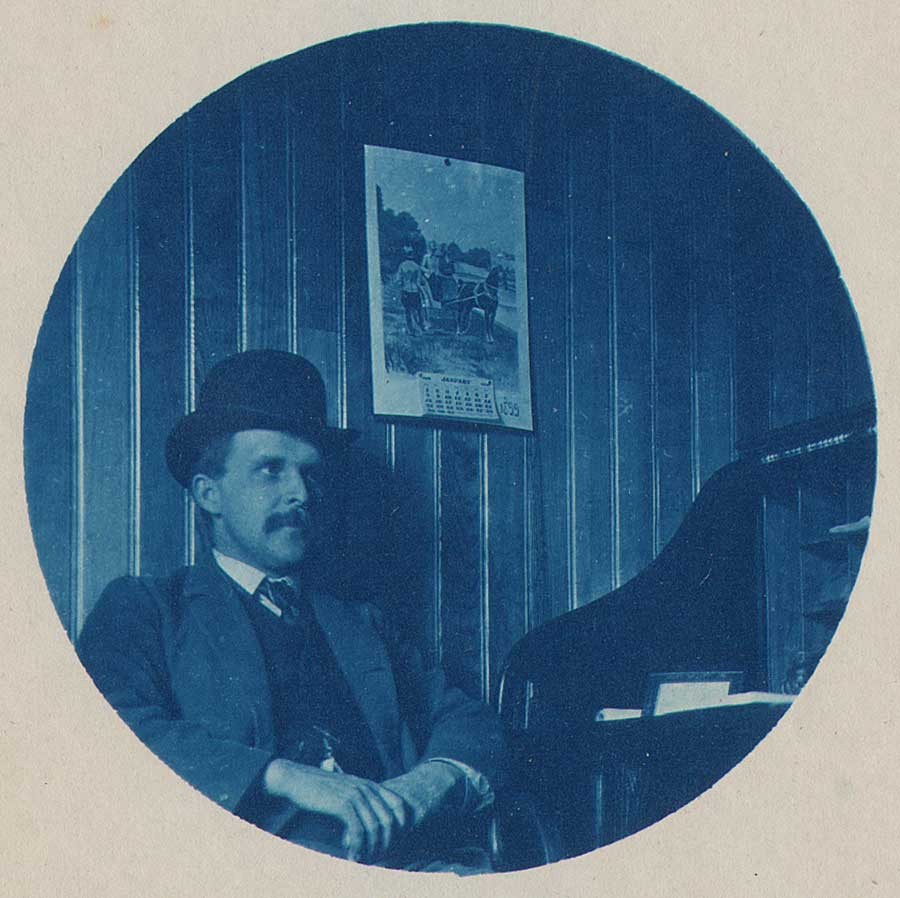 "Man with Bowler hat at Desk": : anonymous American photographer: cyanotype: 1899: 6.5 cm round | 11.3 x 8.8 cm: Possibly a self-portrait, a man wearing a bowler hat seated next to a desk stares away from the camera. A calendar featuring artwork of a horse preparing to pull a two-wheel cart dated January, 1899 hangs on the wall. Photograph may have been additionally printed on commercially available presensitized Venus paper manufactured by the Peerless Blue Print Co., as it was included in a cardboard box of this brand with an expiration date of 1899. Location may have been the midwestern U.S., as it was purchased with other cyanotypes from an Indiana seller. From: PhotoSeed Archive
"Man with Bowler hat at Desk": : anonymous American photographer: cyanotype: 1899: 6.5 cm round | 11.3 x 8.8 cm: Possibly a self-portrait, a man wearing a bowler hat seated next to a desk stares away from the camera. A calendar featuring artwork of a horse preparing to pull a two-wheel cart dated January, 1899 hangs on the wall. Photograph may have been additionally printed on commercially available presensitized Venus paper manufactured by the Peerless Blue Print Co., as it was included in a cardboard box of this brand with an expiration date of 1899. Location may have been the midwestern U.S., as it was purchased with other cyanotypes from an Indiana seller. From: PhotoSeed Archive
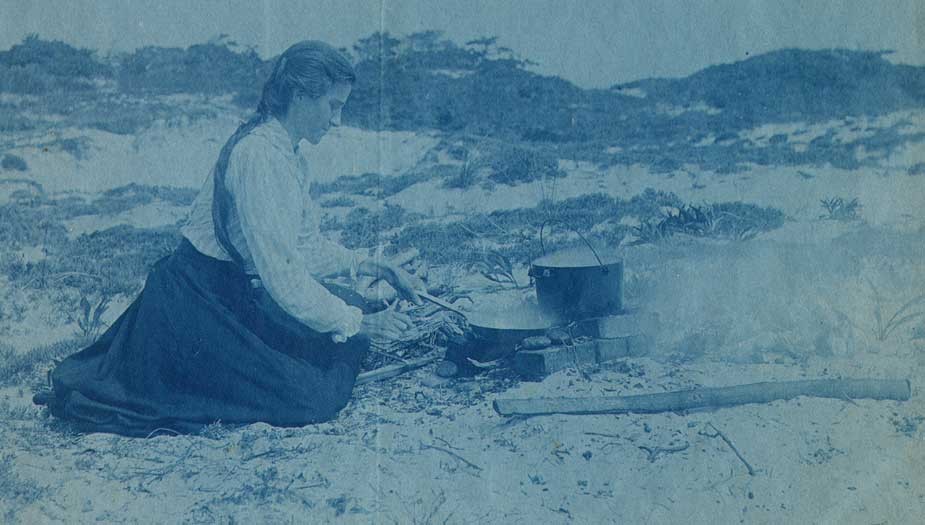 Detail: "Mother cooks at Point O' Woods LI": Charles Rollins Tucker: American: cyanotype: 1899: 12.5 x 17.3 cm: Mary (Carruthers) Tucker,(1870-1940) the spouse of amateur photographer C.R. Tucker, cooks on the beach at Point O'Woods. Wikipedia states this private retreat-even today- may have been the first settlement on Fire Island in Long Island Sound, and was originally organized in 1894 for religious retreats, some from the Chautauqua assemblies before ownership passed to the present-day Point O' Woods Association in 1898 after the first group went bankrupt. From: PhotoSeed Archive
Detail: "Mother cooks at Point O' Woods LI": Charles Rollins Tucker: American: cyanotype: 1899: 12.5 x 17.3 cm: Mary (Carruthers) Tucker,(1870-1940) the spouse of amateur photographer C.R. Tucker, cooks on the beach at Point O'Woods. Wikipedia states this private retreat-even today- may have been the first settlement on Fire Island in Long Island Sound, and was originally organized in 1894 for religious retreats, some from the Chautauqua assemblies before ownership passed to the present-day Point O' Woods Association in 1898 after the first group went bankrupt. From: PhotoSeed Archive
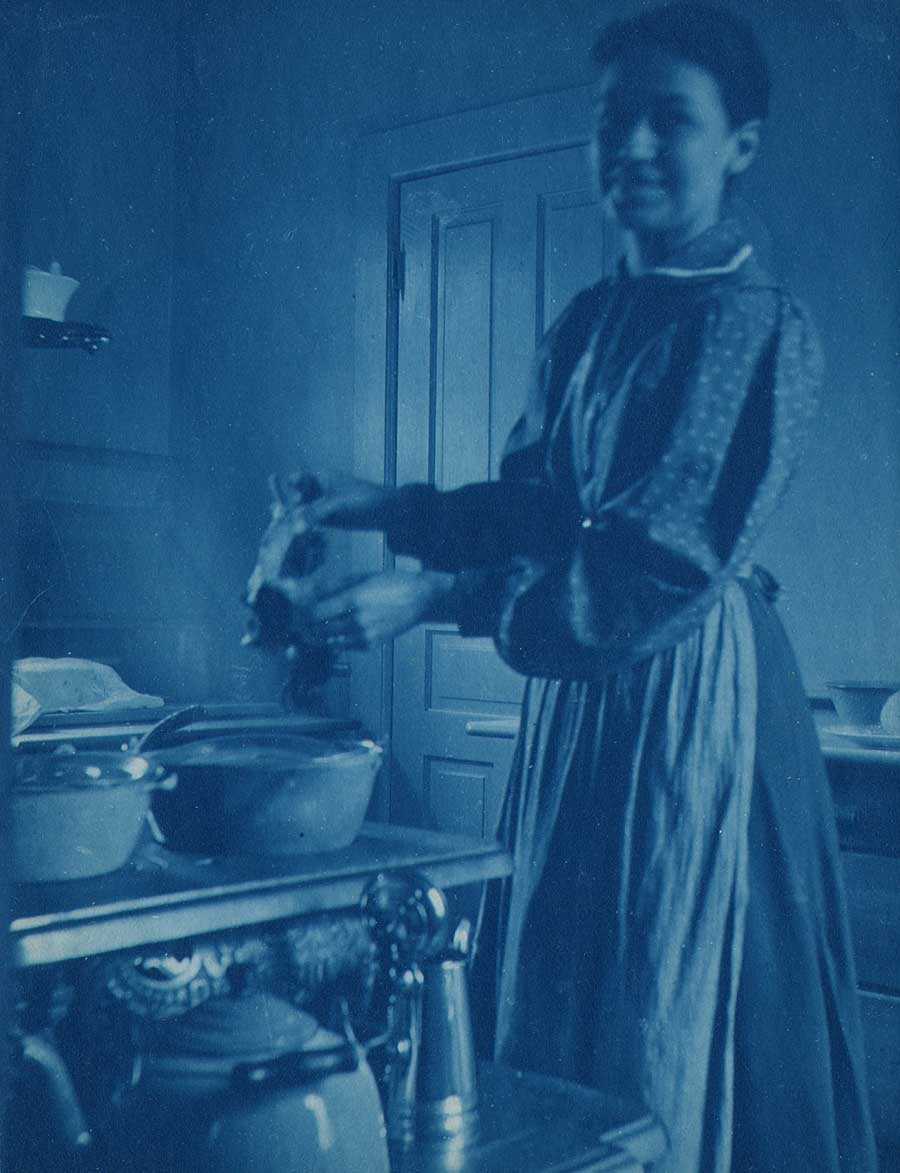 "Woman working in Kitchen" : anonymous American photographer: cyanotype: 1899: 11.9 x 9.2 cm: Wearing an apron and looking towards the camera, a woman prepares to place some type of food into a pot on a shelf above a stove while working in a home kitchen. Photograph may have been additionally printed on commercially available presensitized Venus paper manufactured by the Peerless Blue Print Co., as it was included in a cardboard box of this brand with an expiration date of 1899. Location may have been the midwestern U.S., as it was purchased with other cyanotypes from an Indiana seller. From: PhotoSeed Archive
"Woman working in Kitchen" : anonymous American photographer: cyanotype: 1899: 11.9 x 9.2 cm: Wearing an apron and looking towards the camera, a woman prepares to place some type of food into a pot on a shelf above a stove while working in a home kitchen. Photograph may have been additionally printed on commercially available presensitized Venus paper manufactured by the Peerless Blue Print Co., as it was included in a cardboard box of this brand with an expiration date of 1899. Location may have been the midwestern U.S., as it was purchased with other cyanotypes from an Indiana seller. From: PhotoSeed Archive
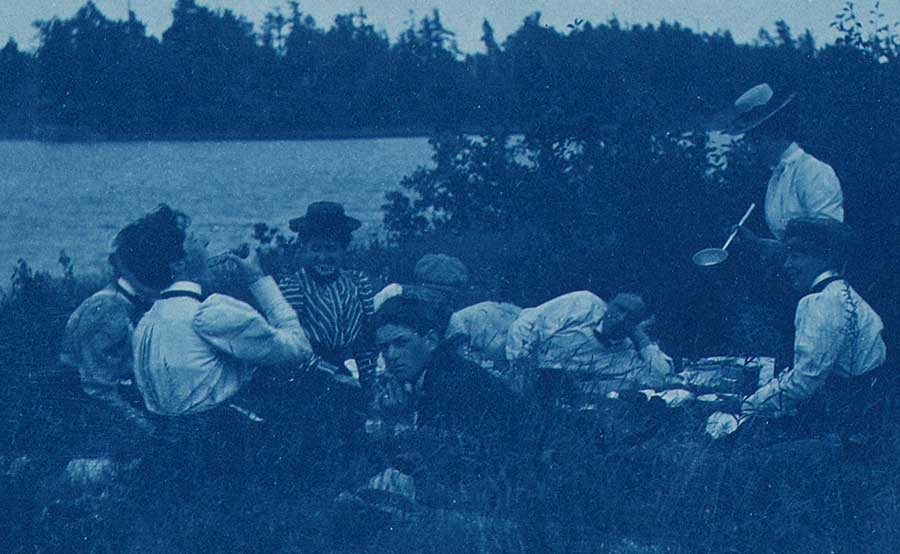 Detail: "Picnickers enjoy a Meal": anonymous American photographer: cyanotype: 1899: 8.0 x 10.6 | 9.9 x 12.5 cm: A party of seven fashionably-dressed men and women enjoy a picnic outing next to a lake. Photograph may have been additionally printed on commercially available presensitized Venus paper manufactured by the Peerless Blue Print Co., as it was included in a cardboard box of this brand with an expiration date of 1899. Location may have been the midwestern U.S., as it was purchased with other cyanotypes from an Indiana seller. From: PhotoSeed Archive
Detail: "Picnickers enjoy a Meal": anonymous American photographer: cyanotype: 1899: 8.0 x 10.6 | 9.9 x 12.5 cm: A party of seven fashionably-dressed men and women enjoy a picnic outing next to a lake. Photograph may have been additionally printed on commercially available presensitized Venus paper manufactured by the Peerless Blue Print Co., as it was included in a cardboard box of this brand with an expiration date of 1899. Location may have been the midwestern U.S., as it was purchased with other cyanotypes from an Indiana seller. From: PhotoSeed Archive
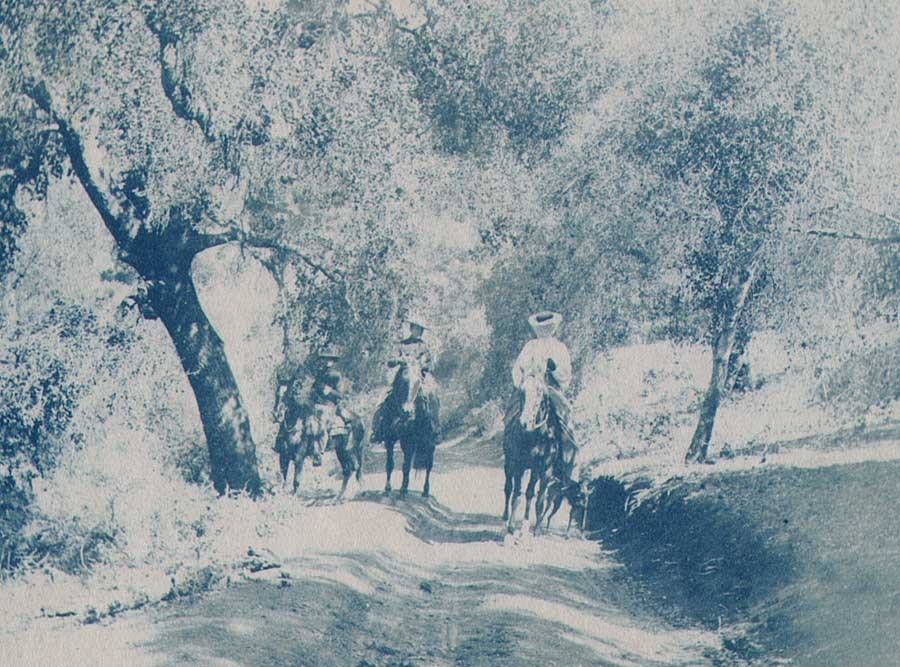 Detail: "Horseback Trail Ride": anonymous American photographer: cyanotype: 1899: 9.0 x 11.2 cm: Two men on horseback, who appear to be in military uniform at left, and a woman rider wearing mosquito netting over her hat and accompanied by a canine Whippet, stop for a moment in sunlight on a rural forest riding trail. Photograph may have been additionally printed on commercially available presensitized Venus paper manufactured by the Peerless Blue Print Co., as it was included in a cardboard box of this brand with an expiration date of 1899. Location may have been the midwestern U.S., as it was purchased with other cyanotypes from an Indiana seller. From: PhotoSeed Archive
Detail: "Horseback Trail Ride": anonymous American photographer: cyanotype: 1899: 9.0 x 11.2 cm: Two men on horseback, who appear to be in military uniform at left, and a woman rider wearing mosquito netting over her hat and accompanied by a canine Whippet, stop for a moment in sunlight on a rural forest riding trail. Photograph may have been additionally printed on commercially available presensitized Venus paper manufactured by the Peerless Blue Print Co., as it was included in a cardboard box of this brand with an expiration date of 1899. Location may have been the midwestern U.S., as it was purchased with other cyanotypes from an Indiana seller. From: PhotoSeed Archive
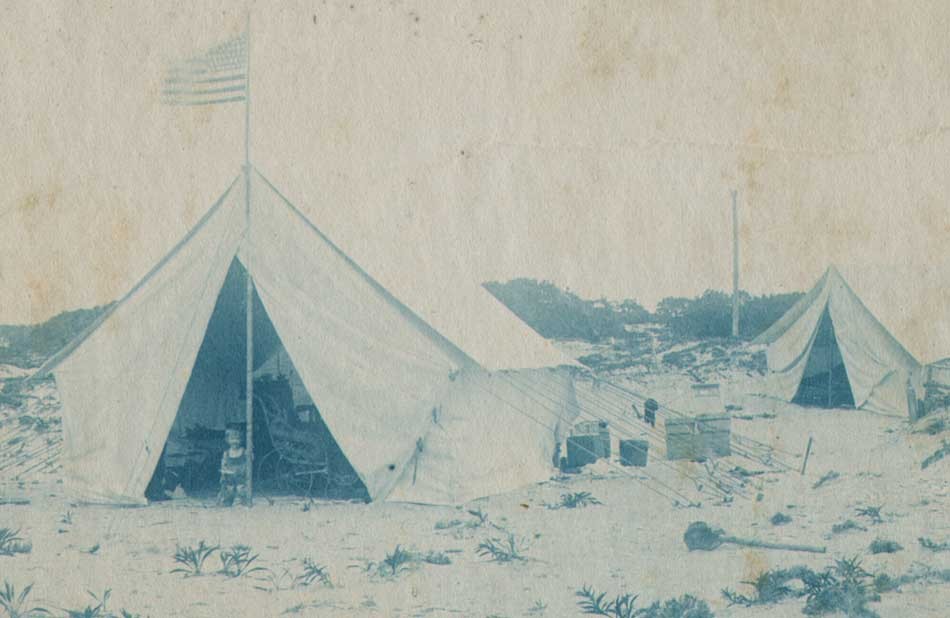 Detail: "Dorothy Tucker at Point O' Woods Beach Camp": Charles Rollins Tucker: American: cyanotype: 1901: 11.5 x 17.5 cm: Dorothy Tucker, (1899-1986) who appears to be no older than two years old, the young daughter of amateur photographer C.R. Tucker, stands at the entrance to a large canvas tent with American flag flying overhead on the beach at Point O' Woods. Wikipedia states this private retreat-even today- may have been the first settlement on Fire Island in Long Island Sound, and was originally organized in 1894 for religious retreats, some from the Chautauqua assemblies before ownership passed to the present-day Point O' Woods Association in 1898 after the first group went bankrupt. From: PhotoSeed Archive
Detail: "Dorothy Tucker at Point O' Woods Beach Camp": Charles Rollins Tucker: American: cyanotype: 1901: 11.5 x 17.5 cm: Dorothy Tucker, (1899-1986) who appears to be no older than two years old, the young daughter of amateur photographer C.R. Tucker, stands at the entrance to a large canvas tent with American flag flying overhead on the beach at Point O' Woods. Wikipedia states this private retreat-even today- may have been the first settlement on Fire Island in Long Island Sound, and was originally organized in 1894 for religious retreats, some from the Chautauqua assemblies before ownership passed to the present-day Point O' Woods Association in 1898 after the first group went bankrupt. From: PhotoSeed Archive
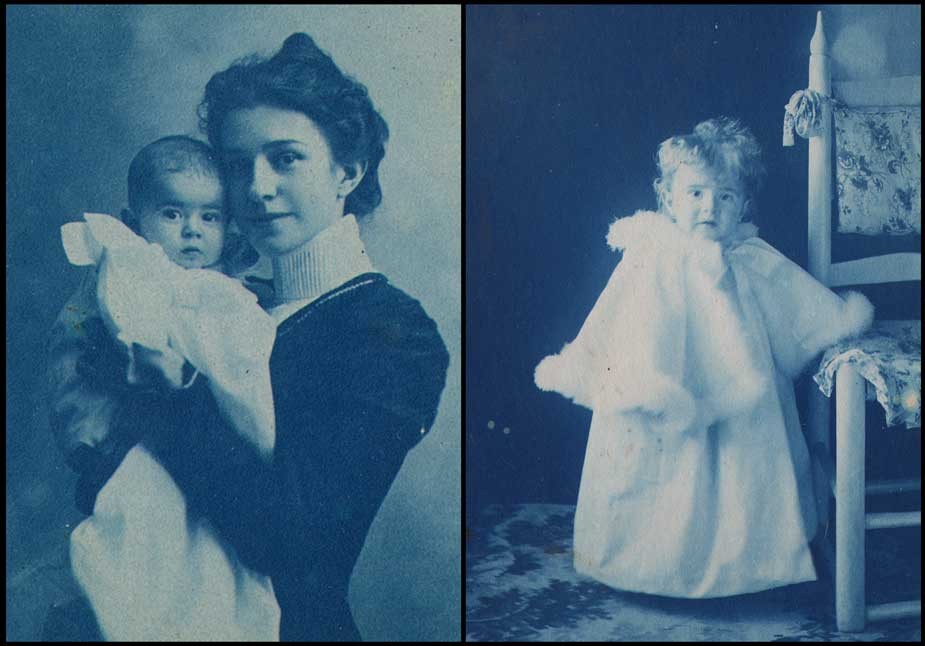 Left: Detail: "Baby Dorothy Tucker with Mother": Charles Rollins Tucker: American: cyanotype: 1899: 7.0 x 5.4 cm: Right: "Dorothy Tucker dressed in Fur-Trimmed Coat Next to Chair": Charles Rollins Tucker: American: cyanotype: 1900: 12.2 x 8.6 cm: Born in August of 1899 on New York's Staten Island, Dorothy Tucker was a constant subject for her father-a high school physics teacher at Curtis High School on the island-who trained his camera on her from birth to late teens. As a cyanotype, the photo showing Dorothy with her mother Mary Tucker (1870-1940) at left was thought well enough to frame behind glass as a family keepsake, lending credibility to the fact the process was not just considered a first way of proofing photos before a final selection was made. Instead, with the sequence shown in this post of four formal portraits of Dorothy as cyanotypes, the process was readily embraced by certain amateurs like Tucker. Both from: PhotoSeed Archive
Left: Detail: "Baby Dorothy Tucker with Mother": Charles Rollins Tucker: American: cyanotype: 1899: 7.0 x 5.4 cm: Right: "Dorothy Tucker dressed in Fur-Trimmed Coat Next to Chair": Charles Rollins Tucker: American: cyanotype: 1900: 12.2 x 8.6 cm: Born in August of 1899 on New York's Staten Island, Dorothy Tucker was a constant subject for her father-a high school physics teacher at Curtis High School on the island-who trained his camera on her from birth to late teens. As a cyanotype, the photo showing Dorothy with her mother Mary Tucker (1870-1940) at left was thought well enough to frame behind glass as a family keepsake, lending credibility to the fact the process was not just considered a first way of proofing photos before a final selection was made. Instead, with the sequence shown in this post of four formal portraits of Dorothy as cyanotypes, the process was readily embraced by certain amateurs like Tucker. Both from: PhotoSeed Archive
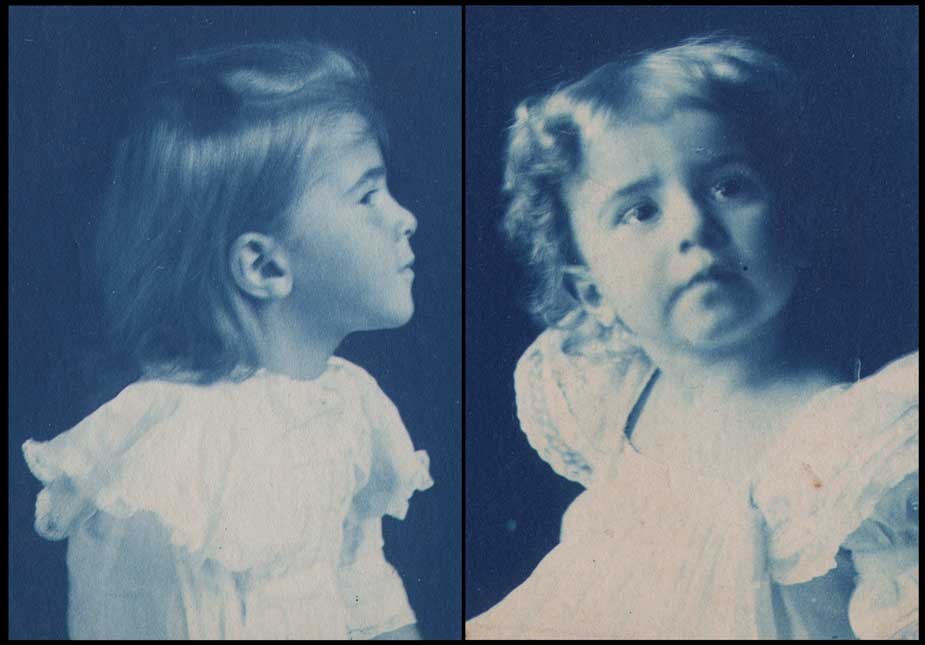 Left: "Dorothy Tucker Profile": Charles Rollins Tucker: American: cyanotype: ca. 1903: 9.9 x 7.2 cm: Right: "Portrait of Dorothy Tucker": Charles Rollins Tucker: American: cyanotype: ca. 1903: 9.3 x 6.9 | 17.8 x 12.8 cm. Born in August of 1899 on New York's Staten Island, Dorothy Tucker was a constant subject for her father-a high school physics teacher at Curtis High School on the island-who trained his camera on her from birth to late teens. Unlike many of the examples of Dorothy held by PhotoSeed that lack a mount, the cyanotype portrait of her at right was center-glued to a gray exhibition card, with another variant example printed in platinum showing evidence of being exhibited. Both from: PhotoSeed Archive
Left: "Dorothy Tucker Profile": Charles Rollins Tucker: American: cyanotype: ca. 1903: 9.9 x 7.2 cm: Right: "Portrait of Dorothy Tucker": Charles Rollins Tucker: American: cyanotype: ca. 1903: 9.3 x 6.9 | 17.8 x 12.8 cm. Born in August of 1899 on New York's Staten Island, Dorothy Tucker was a constant subject for her father-a high school physics teacher at Curtis High School on the island-who trained his camera on her from birth to late teens. Unlike many of the examples of Dorothy held by PhotoSeed that lack a mount, the cyanotype portrait of her at right was center-glued to a gray exhibition card, with another variant example printed in platinum showing evidence of being exhibited. Both from: PhotoSeed Archive
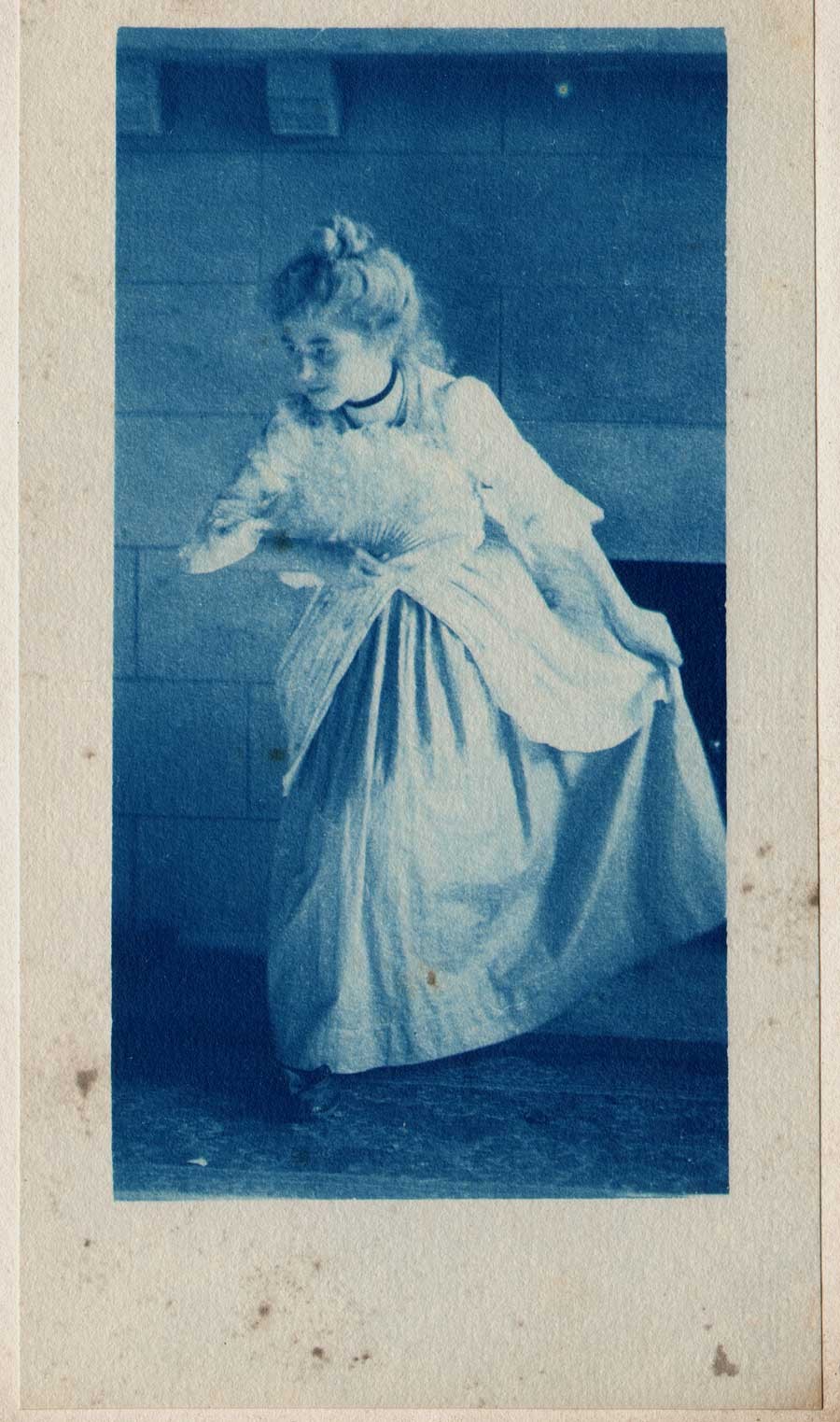 "Dorothy Tucker with Fan": presumed photographer: done in hand-inscribed, block letters: F.L.C.: American?: cyanotype: 1912: 16.5 x 8.6 | 22.0 x 11.3 cm: Shown presented within its tissue-guarded, ribbon tied folder, (22.6 x 12.3 cm) Dorothy Tucker, not quite 13 years old, strikes a pose with a fan inside her home on Staten Island, New York. She was most likely "performing" a part in a school play for "F.L.C.", presumed to be the photographer of this work who was certainly an acquaintance of Dorothy's amateur photographer father Charles Rollins Tucker. The presentation folder additionally dated in blue ink May 18, 1912 & annotated Dorothy Tucker in graphite along lower margin. From: PhotoSeed Archive
"Dorothy Tucker with Fan": presumed photographer: done in hand-inscribed, block letters: F.L.C.: American?: cyanotype: 1912: 16.5 x 8.6 | 22.0 x 11.3 cm: Shown presented within its tissue-guarded, ribbon tied folder, (22.6 x 12.3 cm) Dorothy Tucker, not quite 13 years old, strikes a pose with a fan inside her home on Staten Island, New York. She was most likely "performing" a part in a school play for "F.L.C.", presumed to be the photographer of this work who was certainly an acquaintance of Dorothy's amateur photographer father Charles Rollins Tucker. The presentation folder additionally dated in blue ink May 18, 1912 & annotated Dorothy Tucker in graphite along lower margin. From: PhotoSeed Archive
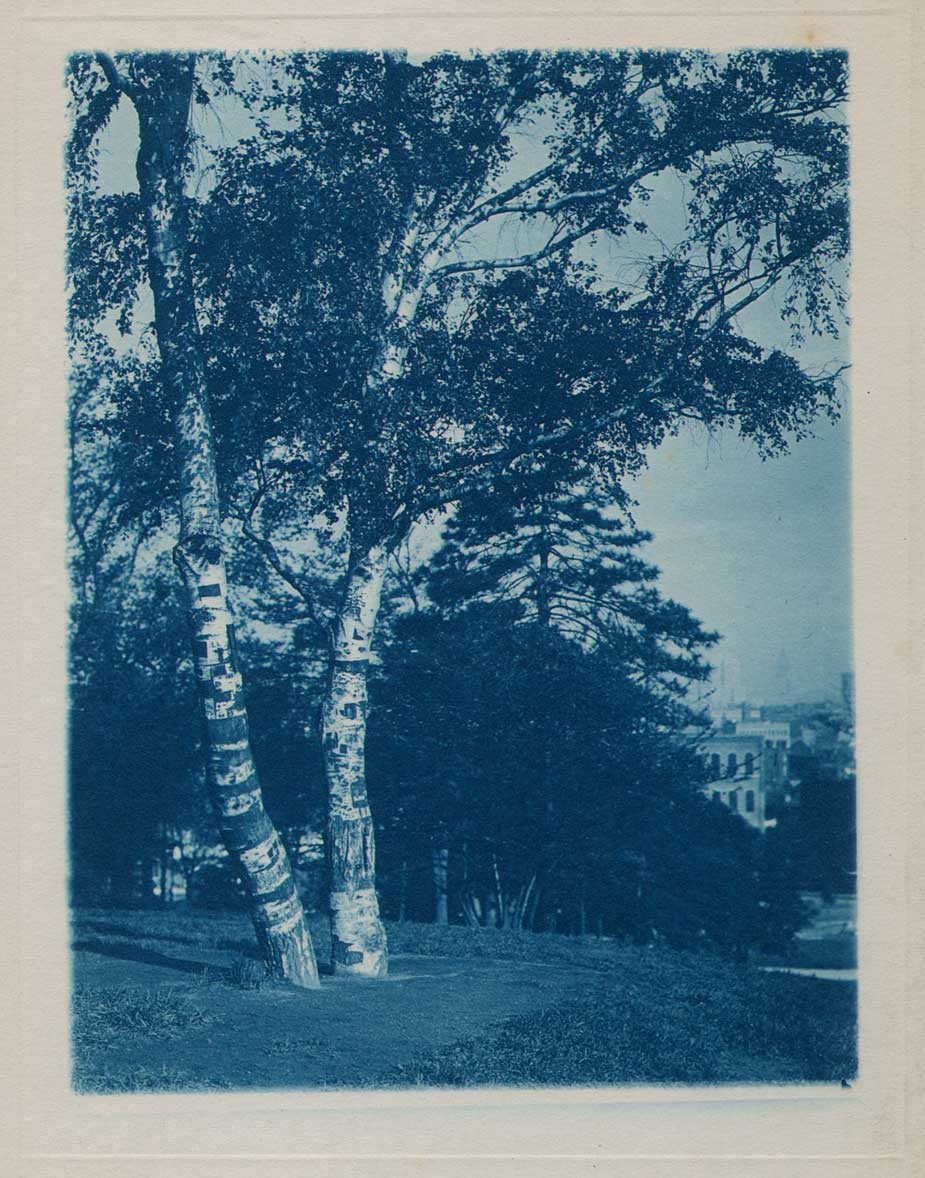 "White Birch Trees on Hill": by Unknown Brooklyn (photographer) : American: cyanotype: ca. 1905-10: 11.6 x 8.8 | 16.8 x 12.3 cm: A tantalizing backdrop of an unknown city can be seen in the distance at right of this cyanotype image featuring several sturdy white birch trees scarred in several places by penknives declaring true love. Possibly with a location of Prospect Park in Brooklyn, this photograph, with title supplied by this archive, is by an Unknown Brooklyn amateur photographer whose surviving work was discovered in a trunk in the American South. Background can be found by searching for this site's 2015 blog post: "No Junk in Trunk". From: PhotoSeed Archive
"White Birch Trees on Hill": by Unknown Brooklyn (photographer) : American: cyanotype: ca. 1905-10: 11.6 x 8.8 | 16.8 x 12.3 cm: A tantalizing backdrop of an unknown city can be seen in the distance at right of this cyanotype image featuring several sturdy white birch trees scarred in several places by penknives declaring true love. Possibly with a location of Prospect Park in Brooklyn, this photograph, with title supplied by this archive, is by an Unknown Brooklyn amateur photographer whose surviving work was discovered in a trunk in the American South. Background can be found by searching for this site's 2015 blog post: "No Junk in Trunk". From: PhotoSeed Archive
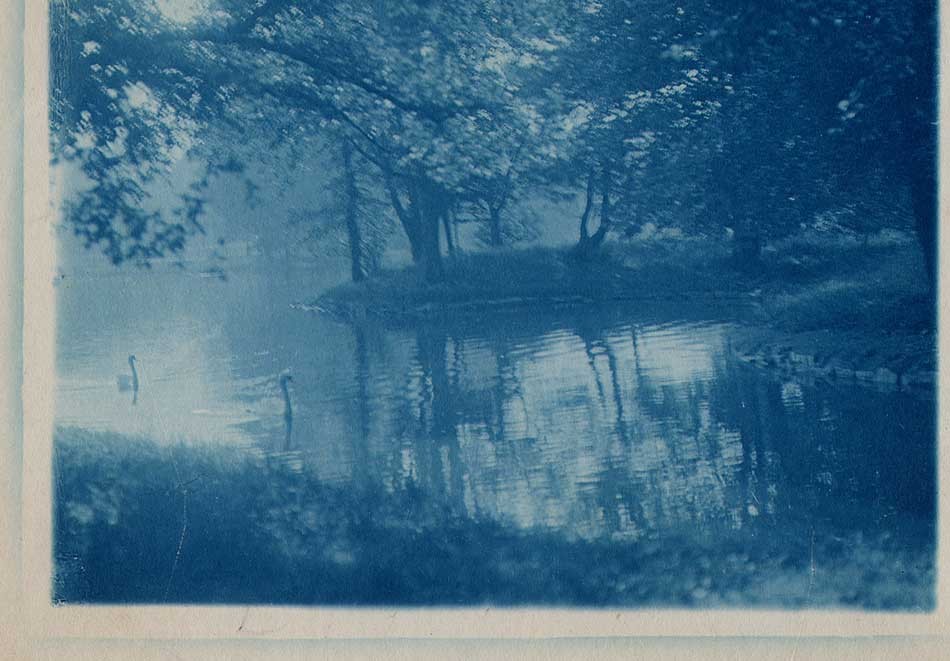 "Swans in Mist": by Unknown Brooklyn (photographer) : American: cyanotype: ca. 1905-10: 8.8 x 11.6 | 12.6 x 17.7 cm: Swans glide through mist on a lake in a park setting-possibly Brooklyn's Prospect Park as many known examples of this location were taken by this photographer. This photograph, with title supplied by this archive, is by an Unknown Brooklyn amateur photographer whose surviving work was discovered in a trunk in the American South. Background can be found by searching for this site's 2015 blog post: "No Junk in Trunk". From: PhotoSeed Archive
"Swans in Mist": by Unknown Brooklyn (photographer) : American: cyanotype: ca. 1905-10: 8.8 x 11.6 | 12.6 x 17.7 cm: Swans glide through mist on a lake in a park setting-possibly Brooklyn's Prospect Park as many known examples of this location were taken by this photographer. This photograph, with title supplied by this archive, is by an Unknown Brooklyn amateur photographer whose surviving work was discovered in a trunk in the American South. Background can be found by searching for this site's 2015 blog post: "No Junk in Trunk". From: PhotoSeed Archive
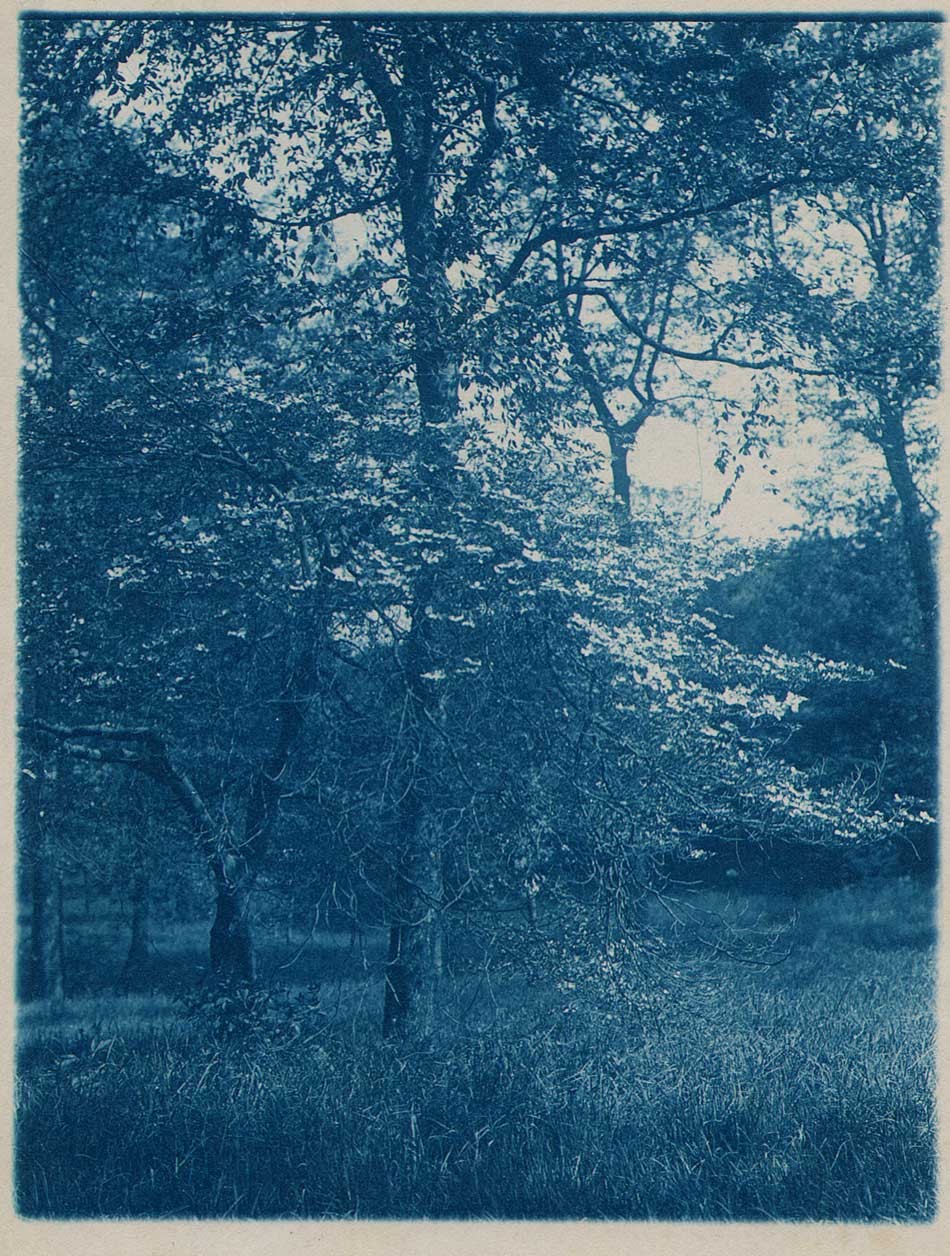 "Dogwood Tree in Bloom": by Unknown Brooklyn (photographer) : American: cyanotype: ca. 1905-10: 11.7 x 8.9 | 16.8 x 11.7 cm: A Dogwood tree blooms on the edge of a meadow in a park setting-possibly Brooklyn's Prospect Park as many known examples of this location were taken by this photographer. This photograph, with title supplied by this archive, is by an Unknown Brooklyn amateur photographer whose surviving work was discovered in a trunk in the American South. Background can be found by searching for this site's 2015 blog post: "No Junk in Trunk". From: private U.S. collection.
"Dogwood Tree in Bloom": by Unknown Brooklyn (photographer) : American: cyanotype: ca. 1905-10: 11.7 x 8.9 | 16.8 x 11.7 cm: A Dogwood tree blooms on the edge of a meadow in a park setting-possibly Brooklyn's Prospect Park as many known examples of this location were taken by this photographer. This photograph, with title supplied by this archive, is by an Unknown Brooklyn amateur photographer whose surviving work was discovered in a trunk in the American South. Background can be found by searching for this site's 2015 blog post: "No Junk in Trunk". From: private U.S. collection.
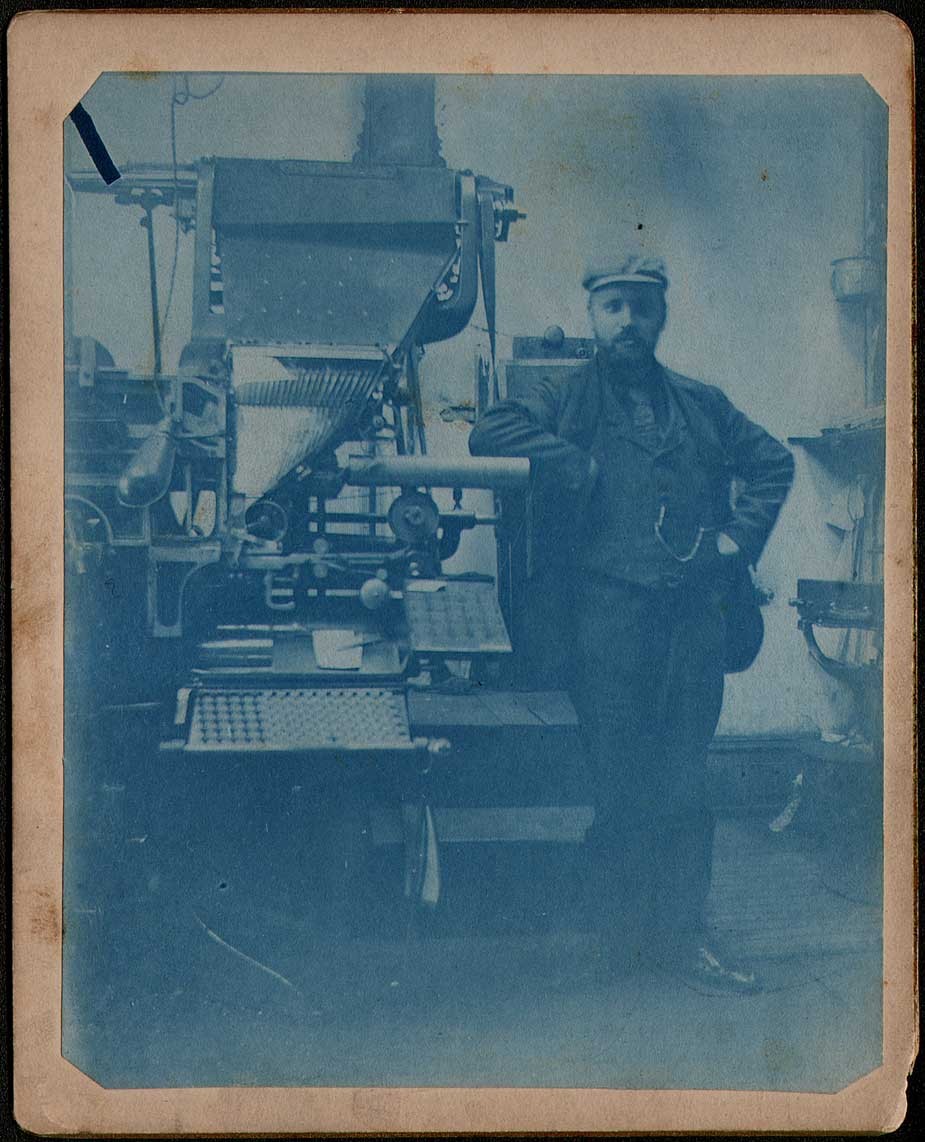 "Man Standing Next to Linotype Machine": unknown photographer: cyanotype: ca. 1895-1905: 11.9 x 9.6 | 13.2 x 10.6 cm: With the only annotation being the word Chicago written on the verso of this intriguing card-mounted cyanotype indicating origin, it's interesting to note that blueprinting, in addition to recording mechanical drawings, was also commonly used to make a record of large machinery like this early Linotype machine, an invention that revolutionized the speed of printing, particularly for newspapers and magazines. Invented by the German-born Ottmar Mergenthaler, (1854-1899) who has an uncanny surviving photographic likeness to the gentleman appearing in this cyanotype, the Linotype was first commercially used by the New York Tribune newspaper in 1886 and was in use into the 1970's, when it was largely replaced by offset lithography printing and computer typesetting. From: PhotoSeed Archive
"Man Standing Next to Linotype Machine": unknown photographer: cyanotype: ca. 1895-1905: 11.9 x 9.6 | 13.2 x 10.6 cm: With the only annotation being the word Chicago written on the verso of this intriguing card-mounted cyanotype indicating origin, it's interesting to note that blueprinting, in addition to recording mechanical drawings, was also commonly used to make a record of large machinery like this early Linotype machine, an invention that revolutionized the speed of printing, particularly for newspapers and magazines. Invented by the German-born Ottmar Mergenthaler, (1854-1899) who has an uncanny surviving photographic likeness to the gentleman appearing in this cyanotype, the Linotype was first commercially used by the New York Tribune newspaper in 1886 and was in use into the 1970's, when it was largely replaced by offset lithography printing and computer typesetting. From: PhotoSeed Archive
And now, examples of “blue prints” owing their roots to the beauty of the cyanotype reproduced using alternate photo-mechanical and photographic processes:
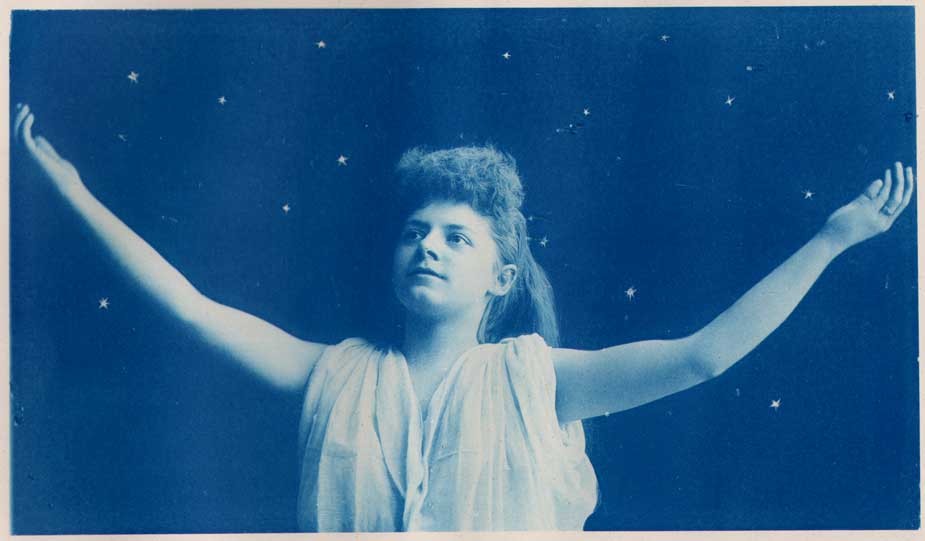 "Starlight": Charles Edward Doty: American 1862-1921: blue-toned collotype published in periodical "Sun & Shade: An Artistic Periodical": New York: January, 1890: whole #17: N.Y. Photo-Gravure Co.: 11.2 x 19.4 cm | 27.6 x 35.0 cm: The popularity of the cyanotype process gave reason for firms like the Photo Gravure Co. of New York to provide print runs for a larger audience of works like "Starlight" whose source imagery was originally a cyanotype. The model, said to be one Miss Emma McCormick, was photographed by Hamilton, Ohio portrait photographer Doty with outstretched arms against a backdrop of stars that were most likely added in the engraving process. Doty, according to the Smithsonian Institution in Washington, which owns hundreds of his original photographs, went on to become the "official photographer of the United States government in Havana," his duties included documenting the modernization of Cuba under American governorship. From: PhotoSeed Archive
"Starlight": Charles Edward Doty: American 1862-1921: blue-toned collotype published in periodical "Sun & Shade: An Artistic Periodical": New York: January, 1890: whole #17: N.Y. Photo-Gravure Co.: 11.2 x 19.4 cm | 27.6 x 35.0 cm: The popularity of the cyanotype process gave reason for firms like the Photo Gravure Co. of New York to provide print runs for a larger audience of works like "Starlight" whose source imagery was originally a cyanotype. The model, said to be one Miss Emma McCormick, was photographed by Hamilton, Ohio portrait photographer Doty with outstretched arms against a backdrop of stars that were most likely added in the engraving process. Doty, according to the Smithsonian Institution in Washington, which owns hundreds of his original photographs, went on to become the "official photographer of the United States government in Havana," his duties included documenting the modernization of Cuba under American governorship. From: PhotoSeed Archive
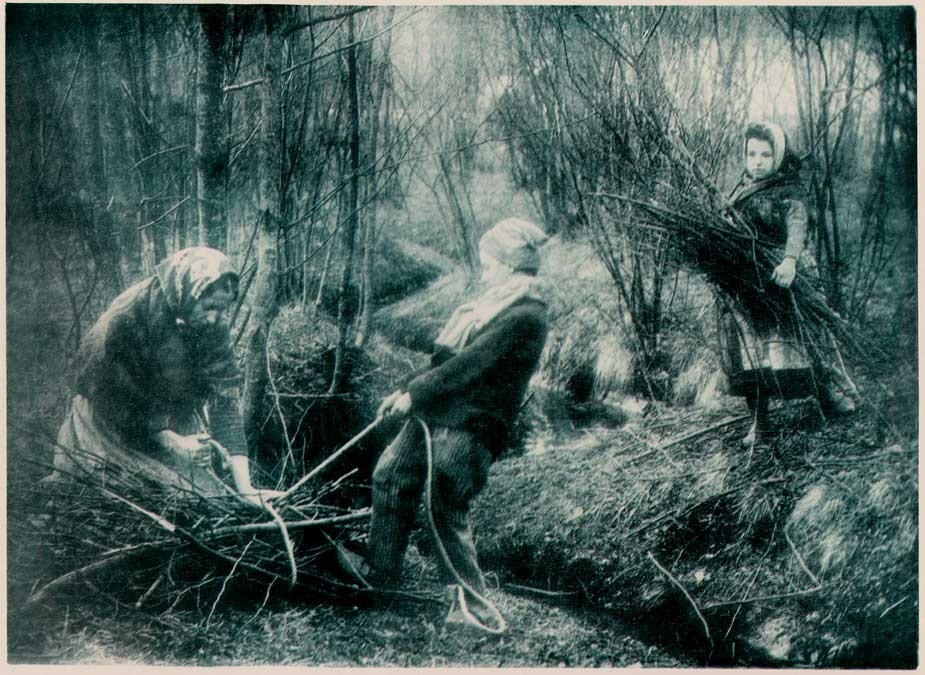 "Bundling and Gathering Faggots": Nestor Stekke: La Louvière, Belgium: blue-tinted collotype published in Sentiment d'Art en Photographie: Brussels,: Vol. II, No. 1, Planche 1: October, 1899: 16.1 x 22.3 | 26.5 x 37.2 cm: Featuring the work primarily of Belgian photographers but open to all, this folio-sized high-quality photographic plate publication, (The Feeling of Art in Photography) under the direction of Camille Smits with reproductions executed in collotype by Jules Liorel, featured the award winning work of pictorialists who entered monthly contests on a given theme judged by painter (M. Titz) and amateur photographer Van Gèle. Short-lived, Sentiment debuted in October, 1898 and ran until January, 1901 when it was renamed L'Art en Photographie . From: PhotoSeed Archive
"Bundling and Gathering Faggots": Nestor Stekke: La Louvière, Belgium: blue-tinted collotype published in Sentiment d'Art en Photographie: Brussels,: Vol. II, No. 1, Planche 1: October, 1899: 16.1 x 22.3 | 26.5 x 37.2 cm: Featuring the work primarily of Belgian photographers but open to all, this folio-sized high-quality photographic plate publication, (The Feeling of Art in Photography) under the direction of Camille Smits with reproductions executed in collotype by Jules Liorel, featured the award winning work of pictorialists who entered monthly contests on a given theme judged by painter (M. Titz) and amateur photographer Van Gèle. Short-lived, Sentiment debuted in October, 1898 and ran until January, 1901 when it was renamed L'Art en Photographie . From: PhotoSeed Archive
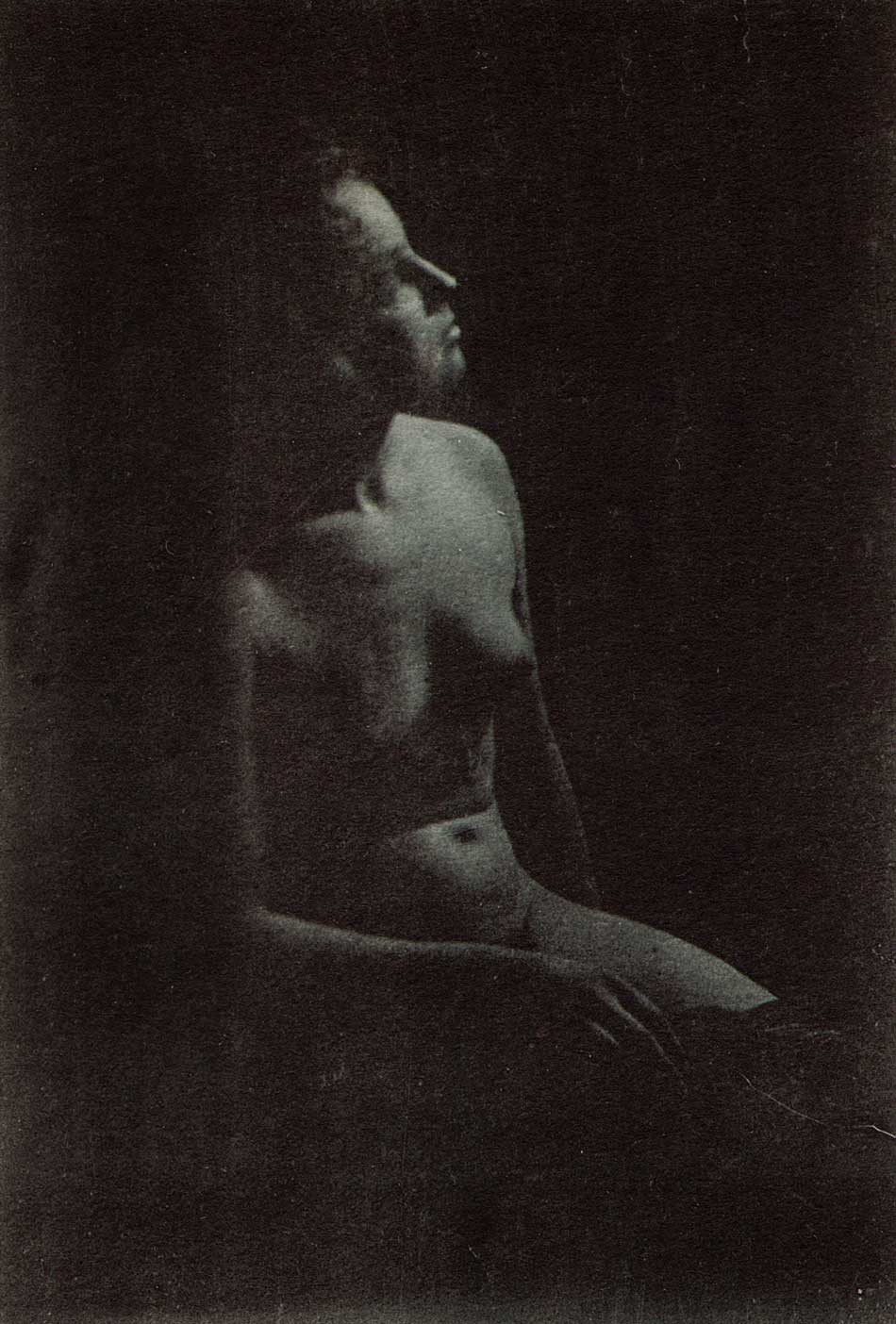 "Nude in Darkness": Léon Sneyers: Belgium:(1877-1949) collotype published in L'Art en Photographie: Brussels: No. 8: August, 1901: 12.4 x 8.3 | 37.0 x 25.5 cm: Translated to "Art in Photography", this folio-sized plate work was a continuation of "Le Sentiment d'Art en Photographie", with primarily Belgian pictorialists entering their work in contests on a given theme. Published by Jules Liorel, who also printed the plates in his Brussels atelier, a bibliography of this monthly work states it was "undoubtedly inspired by "Die Kunst in der Photographie", a German publication, and by "L'Art Photographique" published in Paris". This observation was made in reference to the fine-quality plates issued with it, as in this female nude study by Sneyers taken in the shadows and printed effectively by Liorel in collotype using an ink color combining deep black and violet to compliment the closed eyes of Sneyer's model. From: PhotoSeed Archive
"Nude in Darkness": Léon Sneyers: Belgium:(1877-1949) collotype published in L'Art en Photographie: Brussels: No. 8: August, 1901: 12.4 x 8.3 | 37.0 x 25.5 cm: Translated to "Art in Photography", this folio-sized plate work was a continuation of "Le Sentiment d'Art en Photographie", with primarily Belgian pictorialists entering their work in contests on a given theme. Published by Jules Liorel, who also printed the plates in his Brussels atelier, a bibliography of this monthly work states it was "undoubtedly inspired by "Die Kunst in der Photographie", a German publication, and by "L'Art Photographique" published in Paris". This observation was made in reference to the fine-quality plates issued with it, as in this female nude study by Sneyers taken in the shadows and printed effectively by Liorel in collotype using an ink color combining deep black and violet to compliment the closed eyes of Sneyer's model. From: PhotoSeed Archive
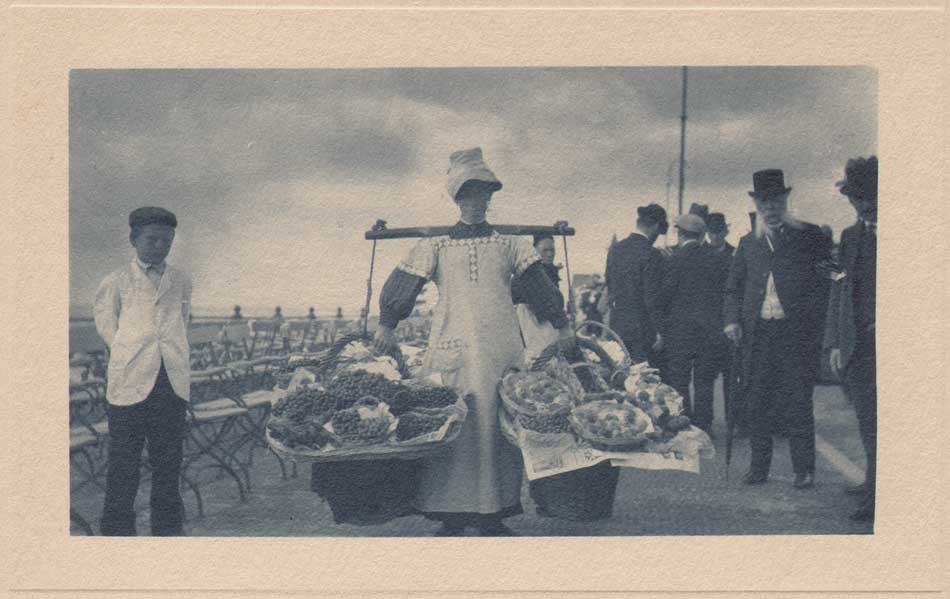 "Fruit Seller on Scheveningen Pier": Frank G.(eorge) Ensenberger, American: 1879-1966: blue-toned bromoil transfer print: 1910: 7.6 x 13.1 | 27.0 x 22.3 cm: A young woman balancing her load of grapes and other fruits for sale with a yoke stands on the Scheveningen Pier at the popular seaside resort located in The Hague in the Netherlands. In May, 1910, amateur photographer Frank Ensenberger of Bloomington, Ill sailed from Boston to Europe with his family, where he spent four months touring Great Britain, the Continent and other countries all while documenting the trip with his camera. On his return, approximately 900 selects were made by him and printed in various tints as bromoil transfer prints by an unknown professional photographer. They were gathered by country in leather-bound volumes, of which PhotoSeed owns nine. A prosperous business merchant and president of Ensenberger's home furnishings store in Bloomington, the Bloomington Pantagraph newspaper wrote of his photographic efforts during the trip in September, 1910, commenting: "The proofs show Mr. Ensenberger possesses the rare instinct of recognizing the setting for a good picture when he sees it, many of the views being truly artistic." Truthfully, his work was competent overall, with many of the plates being more "snapshot" in nature although documentary images scattered throughout the volumes show better than average compositional qualities. From: PhotoSeed Archive
"Fruit Seller on Scheveningen Pier": Frank G.(eorge) Ensenberger, American: 1879-1966: blue-toned bromoil transfer print: 1910: 7.6 x 13.1 | 27.0 x 22.3 cm: A young woman balancing her load of grapes and other fruits for sale with a yoke stands on the Scheveningen Pier at the popular seaside resort located in The Hague in the Netherlands. In May, 1910, amateur photographer Frank Ensenberger of Bloomington, Ill sailed from Boston to Europe with his family, where he spent four months touring Great Britain, the Continent and other countries all while documenting the trip with his camera. On his return, approximately 900 selects were made by him and printed in various tints as bromoil transfer prints by an unknown professional photographer. They were gathered by country in leather-bound volumes, of which PhotoSeed owns nine. A prosperous business merchant and president of Ensenberger's home furnishings store in Bloomington, the Bloomington Pantagraph newspaper wrote of his photographic efforts during the trip in September, 1910, commenting: "The proofs show Mr. Ensenberger possesses the rare instinct of recognizing the setting for a good picture when he sees it, many of the views being truly artistic." Truthfully, his work was competent overall, with many of the plates being more "snapshot" in nature although documentary images scattered throughout the volumes show better than average compositional qualities. From: PhotoSeed Archive
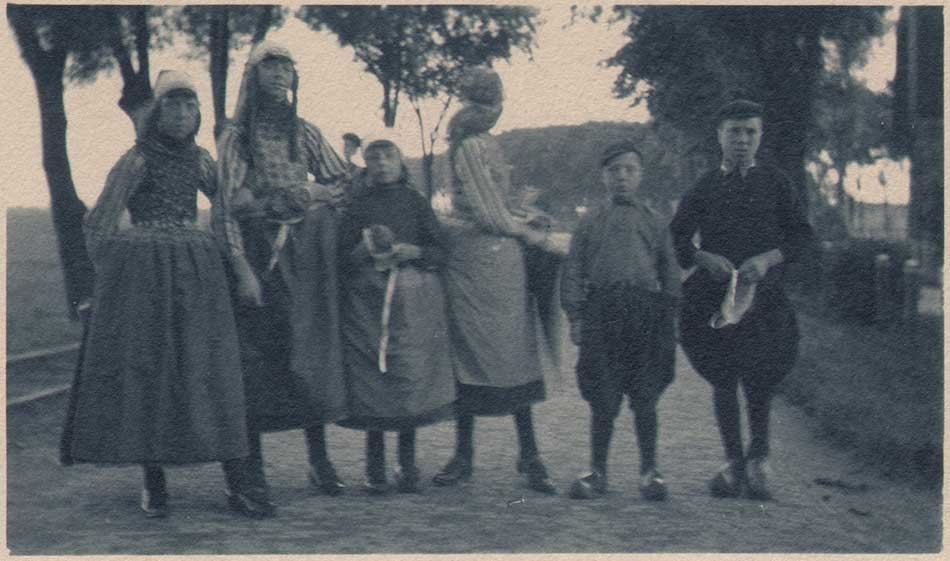 "Children Portrait Group in Holland": Frank G.(eorge) Ensenberger, American: 1879-1966: blue-toned bromoil transfer print: 1910: 7.6 x 13.1 | 27.0 x 22.3 cm: Standing in the middle of a roadway in Holland, a group of six children in their native dress stand for a portrait, the boys at right wearing traditional wooden shoes. In May, 1910, amateur photographer Frank Ensenberger of Bloomington, Ill sailed from Boston to Europe with his family, where he spent four months touring Great Britain, the Continent and other countries all while documenting the trip with his camera. On his return, approximately 900 selects were made by him and printed in various tints as bromoil transfer prints by an unknown professional photographer. They were gathered by country in leather-bound volumes, of which PhotoSeed owns nine. A prosperous business merchant and president of Ensenberger's home furnishings store in Bloomington, the Bloomington Pantagraph newspaper wrote of his photographic efforts during the trip in September, 1910, commenting: "The proofs show Mr. Ensenberger possesses the rare instinct of recognizing the setting for a good picture when he sees it, many of the views being truly artistic." Truthfully, his work was competent overall, with many of the plates being more "snapshot" in nature although documentary images scattered throughout the volumes show better than average compositional qualities. From: PhotoSeed Archive
"Children Portrait Group in Holland": Frank G.(eorge) Ensenberger, American: 1879-1966: blue-toned bromoil transfer print: 1910: 7.6 x 13.1 | 27.0 x 22.3 cm: Standing in the middle of a roadway in Holland, a group of six children in their native dress stand for a portrait, the boys at right wearing traditional wooden shoes. In May, 1910, amateur photographer Frank Ensenberger of Bloomington, Ill sailed from Boston to Europe with his family, where he spent four months touring Great Britain, the Continent and other countries all while documenting the trip with his camera. On his return, approximately 900 selects were made by him and printed in various tints as bromoil transfer prints by an unknown professional photographer. They were gathered by country in leather-bound volumes, of which PhotoSeed owns nine. A prosperous business merchant and president of Ensenberger's home furnishings store in Bloomington, the Bloomington Pantagraph newspaper wrote of his photographic efforts during the trip in September, 1910, commenting: "The proofs show Mr. Ensenberger possesses the rare instinct of recognizing the setting for a good picture when he sees it, many of the views being truly artistic." Truthfully, his work was competent overall, with many of the plates being more "snapshot" in nature although documentary images scattered throughout the volumes show better than average compositional qualities. From: PhotoSeed Archive
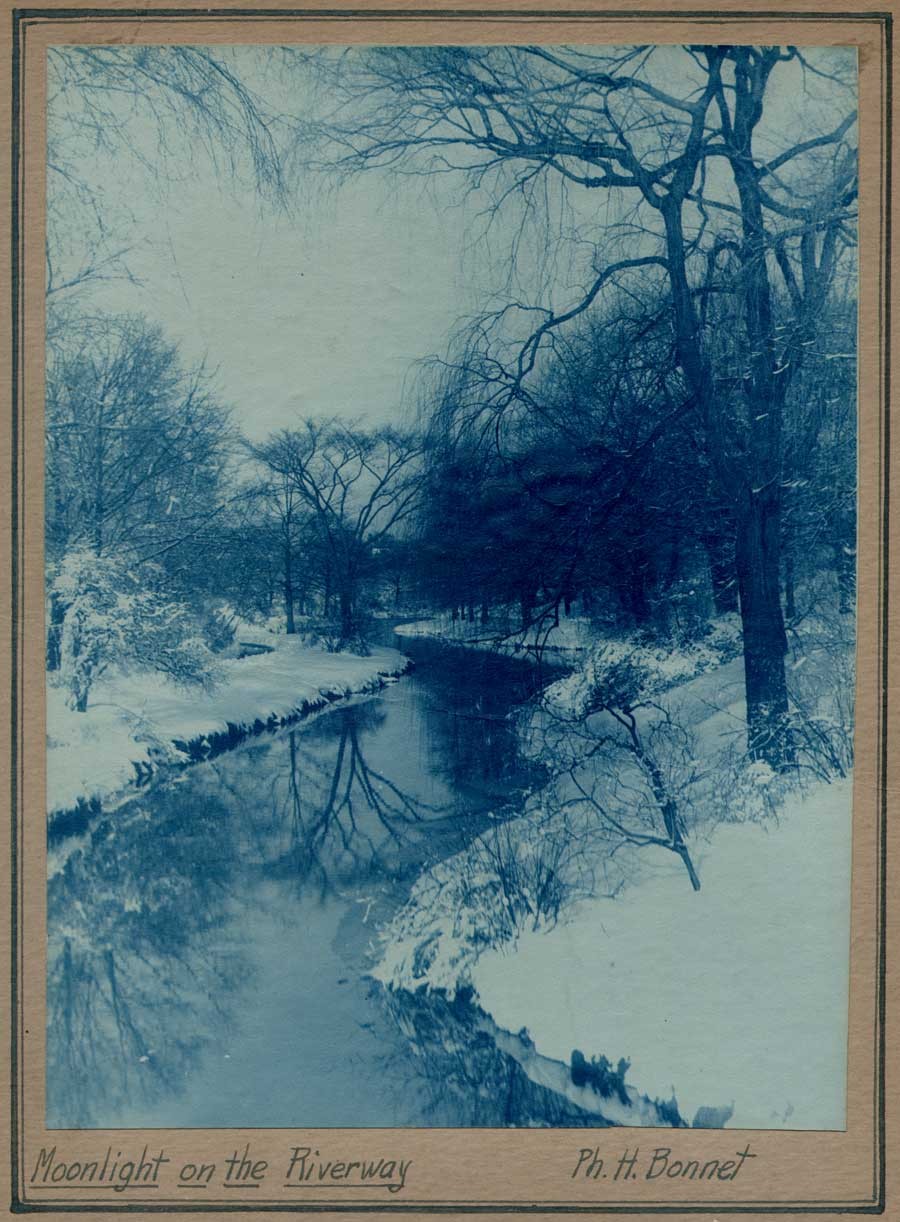 "Moonlight on the Riverway": Ph.(ilippe) H. Bonnet: 1904-1977: American: born France: blue-toned silver bromide print? ca. 1930-40: 24.8 x 18.6 | 38.6 x 26.3 cm: As a younger man, Philippe H. Bonnet was a staff photographer for The Tech, the Massachusetts Institute of Technology's undergraduate student newspaper. He is believed to have graduated from MIT in 1931 as listed in the Tech. In the early 1960's, a newspaper said he was a well known Boston architect. He also later made a name for himself as a railroad photographer-especially of trolley cars- and made his own real photo post cards and stamped them individually as a "Ferroviagraph". This scenic view of a river in Winter is from a series of landscape photographs believed to have been taken by him in the Middlesex Fells Reservation, a 2500 acre natural area located just north of Boston. A double-lined, hand-ruled frame in blue ink compliments the deep-blue effect achieved through the action of blue-toning. From: PhotoSeed Archive
"Moonlight on the Riverway": Ph.(ilippe) H. Bonnet: 1904-1977: American: born France: blue-toned silver bromide print? ca. 1930-40: 24.8 x 18.6 | 38.6 x 26.3 cm: As a younger man, Philippe H. Bonnet was a staff photographer for The Tech, the Massachusetts Institute of Technology's undergraduate student newspaper. He is believed to have graduated from MIT in 1931 as listed in the Tech. In the early 1960's, a newspaper said he was a well known Boston architect. He also later made a name for himself as a railroad photographer-especially of trolley cars- and made his own real photo post cards and stamped them individually as a "Ferroviagraph". This scenic view of a river in Winter is from a series of landscape photographs believed to have been taken by him in the Middlesex Fells Reservation, a 2500 acre natural area located just north of Boston. A double-lined, hand-ruled frame in blue ink compliments the deep-blue effect achieved through the action of blue-toning. From: PhotoSeed Archive
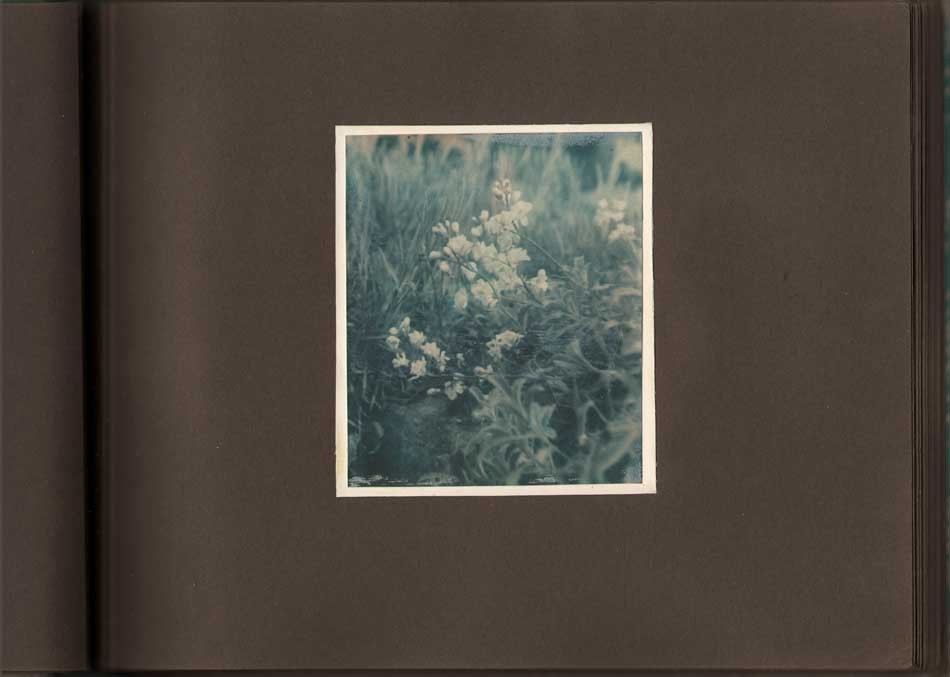 "Baby's Breath Growing in Wild": unknown photographer: blue-toned gelatin silver print: ca. 1930-40: 12.5 x 10.5 | 13.2 x 11.4 | 23.8 x 31.9 cm: This delicate study of what are believed to be Baby's Breath flowers (Gypsophilia, or Das Schleierkraut) is presented here in an album by an anonymous photographer (purchased from a seller in Greece) including a selection of pictorialist works featuring nicely mounted cityscape, mountain, and marine views, several of which show Frankfurt, Germany. From: PhotoSeed Archive
"Baby's Breath Growing in Wild": unknown photographer: blue-toned gelatin silver print: ca. 1930-40: 12.5 x 10.5 | 13.2 x 11.4 | 23.8 x 31.9 cm: This delicate study of what are believed to be Baby's Breath flowers (Gypsophilia, or Das Schleierkraut) is presented here in an album by an anonymous photographer (purchased from a seller in Greece) including a selection of pictorialist works featuring nicely mounted cityscape, mountain, and marine views, several of which show Frankfurt, Germany. From: PhotoSeed Archive
And in conclusion, a final cyanotype:
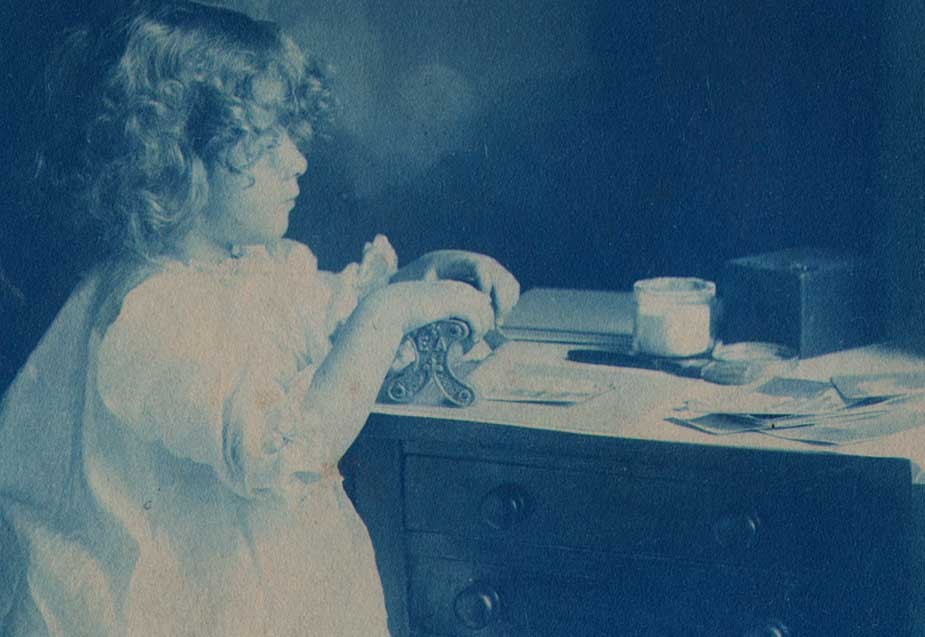 Detail: "Dorothy Tucker Mounting Photographs": Charles Rollins Tucker: American: cyanotype: ca. 1903: 11.3 x 8.6 | 15.0 x 12.6 cm: Seated on a stool, Dorothy Tucker, (1899-1986) the young daughter of amateur photographer Charles Rollins Tucker, is shown using an E. & H.T. Anthony brand Print Mounter to mount a photograph on a work table. Possibly taken for one of the yearly amateur Kodak advertising contests, the work space shows a Kodak Brownie camera at right rear, loose photographs, an album and a jar of what is most likely "Daisy" mounting paste with a brush next to it. Gripping the top of the mounter, young Dorothy prepares to slide the mounter with its two rollers over a print seen just to the right of it. The initials "EA" for Edward Anthony, are engraved on the side of roller. The E. & H.T. Anthony firm was considered the largest manufacturer and distributor of photographic supplies in the United States during the 19th century. From: PhotoSeed Archive
Detail: "Dorothy Tucker Mounting Photographs": Charles Rollins Tucker: American: cyanotype: ca. 1903: 11.3 x 8.6 | 15.0 x 12.6 cm: Seated on a stool, Dorothy Tucker, (1899-1986) the young daughter of amateur photographer Charles Rollins Tucker, is shown using an E. & H.T. Anthony brand Print Mounter to mount a photograph on a work table. Possibly taken for one of the yearly amateur Kodak advertising contests, the work space shows a Kodak Brownie camera at right rear, loose photographs, an album and a jar of what is most likely "Daisy" mounting paste with a brush next to it. Gripping the top of the mounter, young Dorothy prepares to slide the mounter with its two rollers over a print seen just to the right of it. The initials "EA" for Edward Anthony, are engraved on the side of roller. The E. & H.T. Anthony firm was considered the largest manufacturer and distributor of photographic supplies in the United States during the 19th century. From: PhotoSeed Archive
In with the New
Posted January 2016 in New Additions, PhotoSeed, Typography, Unknown Photographers
No Junk in Trunk
Posted December 2015 in Alternate Processes, Cameras, Color Photography, New Additions, Photography, Unknown Photographers
If the story is to be believed, the contents of a mystery trunk ⎯the artistic passion of yet another unknown early 20th Century photographer ⎯have been saved once again in the name of photographic collecting. The evidence was several hundred photographs tucked inside:
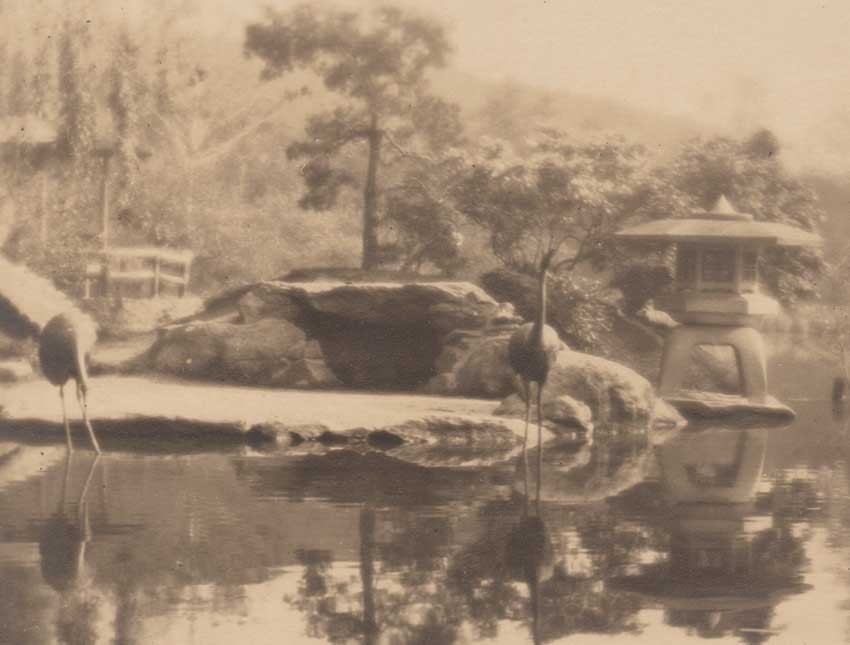 Detail: "Japanese Hill-and-Pond Garden Island" (at Brooklyn, New York Botanic Garden): ca. 1920-25: Unknown Brooklyn photographer: gelatin silver: 8.8 x 11.4 cm | 12.6 x 17.3 cm cream-colored, photographic paper stock: from: PhotoSeed Archive
Detail: "Japanese Hill-and-Pond Garden Island" (at Brooklyn, New York Botanic Garden): ca. 1920-25: Unknown Brooklyn photographer: gelatin silver: 8.8 x 11.4 cm | 12.6 x 17.3 cm cream-colored, photographic paper stock: from: PhotoSeed Archive
”The dealer had bought a trunk from an estate of a lady who had passed away.”
A story I’ve encountered before in my online foraging. My offer, in order to keep the archive together, was fortunately accepted, and now share with you a glimpse of some of these fruits.
Typically, when photographs enter this collection, initial research on origins and other factors are made and then set aside-often for years- until more deductions can be made or oftentimes additional primary source material percolates into that vast library we all humbly know as the public Internet.
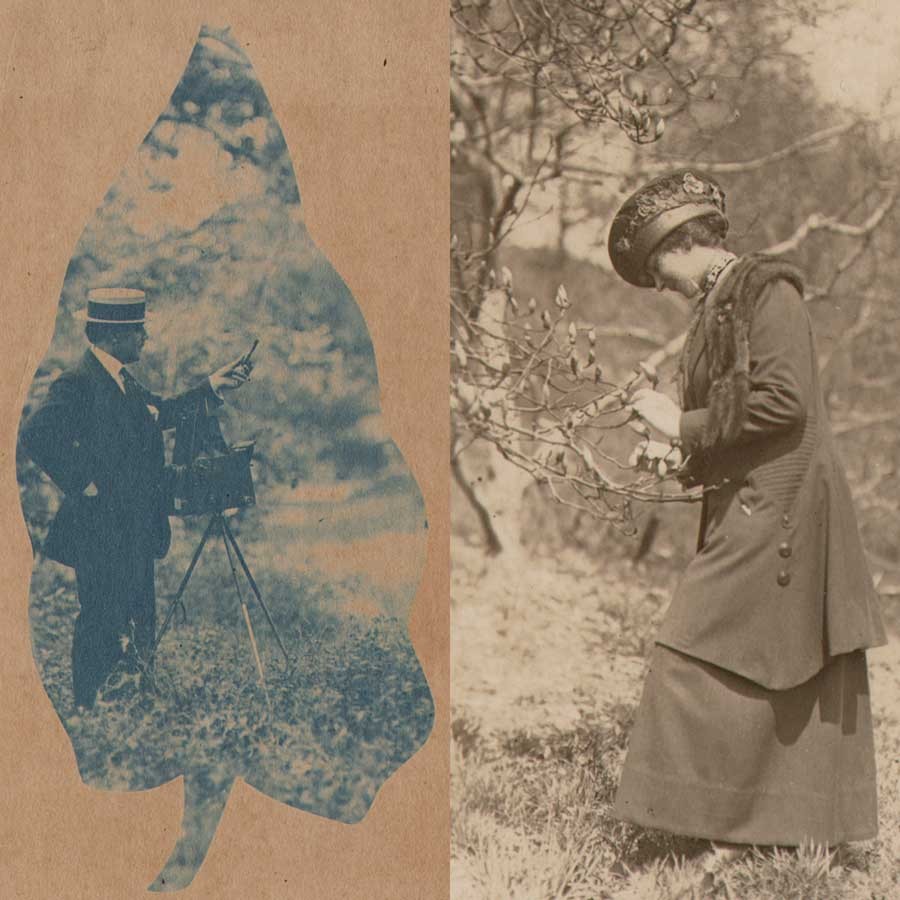 Husband & Wife? L: Detail: "Photographer in Boater Hat Behind Graflex Camera": ca. 1910-1920: Unknown Brooklyn photographer: cyanotype: 11.2 x 5.2 cm | 14.6 x 8.2 cm: image printed within leaf shape on thin cream-colored paper: R: Detail: "Woman Examining Magnolia Blossom": ca. 1910-1920: Unknown Brooklyn photographer: gelatin silver: 11.1 x 7.3 cm | 17.1 x 10.5 cm: both from: PhotoSeed Archive
Husband & Wife? L: Detail: "Photographer in Boater Hat Behind Graflex Camera": ca. 1910-1920: Unknown Brooklyn photographer: cyanotype: 11.2 x 5.2 cm | 14.6 x 8.2 cm: image printed within leaf shape on thin cream-colored paper: R: Detail: "Woman Examining Magnolia Blossom": ca. 1910-1920: Unknown Brooklyn photographer: gelatin silver: 11.1 x 7.3 cm | 17.1 x 10.5 cm: both from: PhotoSeed Archive
But exceptions, at least in my world, always exist. For these latest trunk photographs coming to light, my discovery a small portion documenting a place and event celebrating 100 year anniversaries in 2015 were primary motivators in showcasing them now with this post. These were the establishment of the Japanese Hill-and-Pond Garden in 1915 at the Brooklyn Botanic Garden, considered the first Japanese garden created in an American public garden, as well as a small cache of photographs taken the same year at the Panama-Pacific International Exposition in San Francisco, California.
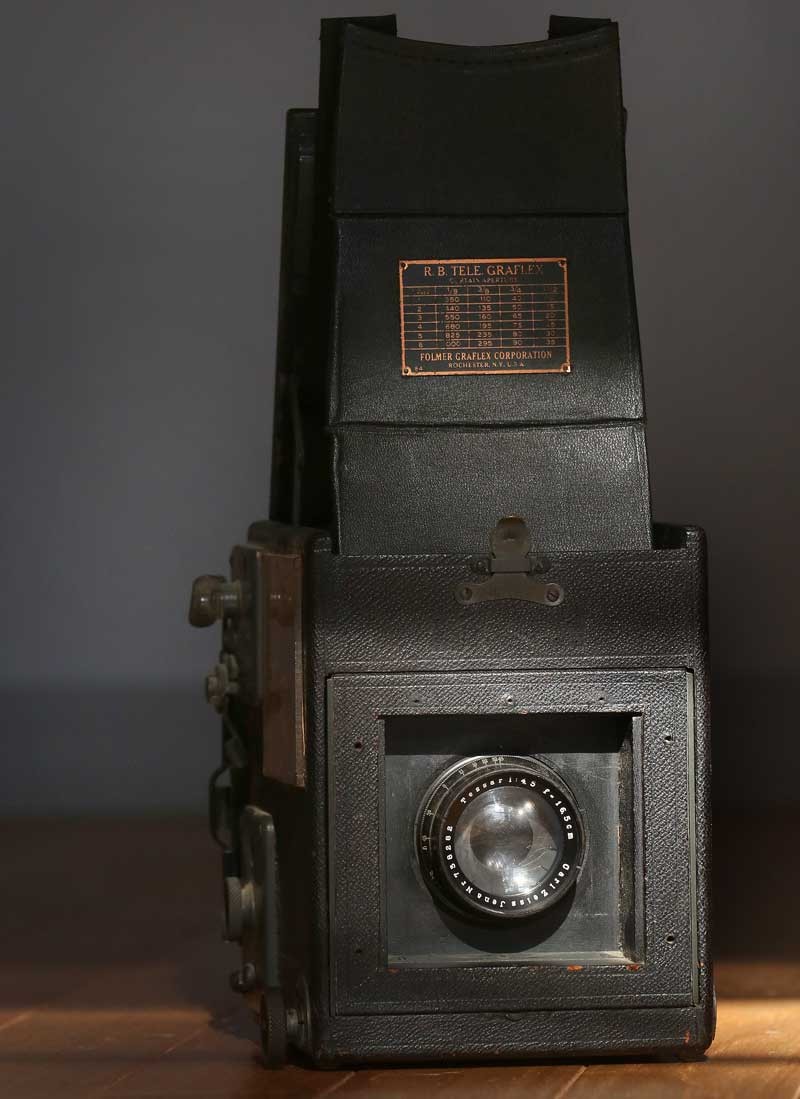 R.B.Tele-Graflex Camera outfitted with Carl Zeiss Tessar lens ca. 1913 (last patent is for June of this year on camera bottom) Manufactured by the Folmer Graflex Corporation, Rochester, New York. The Unknown Brooklyn photographer who took the images seen with this post used a similar Graflex model pictured in the above cyanotype. Lightweight so it could be carried in the field and used on a tripod or hand-held, it features a revolving back so the glass or cut film plates loaded into individual holders could be oriented on the camera back for a vertical or horizontal field of view. The photographer looked through the top of the camera (shown in open position here) and focused on the ground glass inside while bringing the subject into focus by manipulating the bellows (not extended in this photo) using the knob located at the far left of the lens board on lower side of camera. from: PhotoSeed Archive
R.B.Tele-Graflex Camera outfitted with Carl Zeiss Tessar lens ca. 1913 (last patent is for June of this year on camera bottom) Manufactured by the Folmer Graflex Corporation, Rochester, New York. The Unknown Brooklyn photographer who took the images seen with this post used a similar Graflex model pictured in the above cyanotype. Lightweight so it could be carried in the field and used on a tripod or hand-held, it features a revolving back so the glass or cut film plates loaded into individual holders could be oriented on the camera back for a vertical or horizontal field of view. The photographer looked through the top of the camera (shown in open position here) and focused on the ground glass inside while bringing the subject into focus by manipulating the bellows (not extended in this photo) using the knob located at the far left of the lens board on lower side of camera. from: PhotoSeed Archive
But there’s more as they say. Many of the photographs: gorgeous little jewels printed directly onto small impressed and ruled pieces of photographic paper which act as mounts-some toned in verdant hues of green for landscapes, blues for seascapes and others beautifully hand-colored, are known to have been taken in the mother of the Brooklyn Botanic Garden itself, the expansive 585-acre Prospect Park designed by Frederick Law Olmsted and Calvert Vaux- Brooklyn’s version of New York City’s Central Park which is celebrating its’ 150th anniversary in 2016.
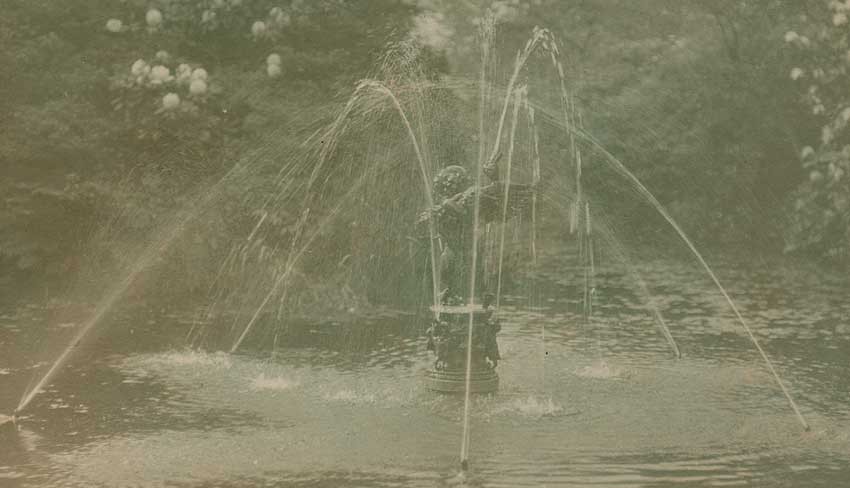 Detail: "Boy and Duck Fountain in Vale of Cashmere", sculpture by Frederick William MacMonnies, American: 1863-1937 (at Brooklyn Botanic Garden): ca. 1910-20: Unknown Brooklyn photographer: green toned gelatin silver: 8.8 x 11.6 cm|12.4 x 16.9 cm: from: PhotoSeed Archive
Detail: "Boy and Duck Fountain in Vale of Cashmere", sculpture by Frederick William MacMonnies, American: 1863-1937 (at Brooklyn Botanic Garden): ca. 1910-20: Unknown Brooklyn photographer: green toned gelatin silver: 8.8 x 11.6 cm|12.4 x 16.9 cm: from: PhotoSeed Archive
Frustratingly, the photographer’s identity responsible for these fruits is presently unknown, other than a cyanotype image included with the collection showing a dapper gentleman believed to be this person standing behind a tripod-mounted Graflex model camera. Photographically printed within the outlines of a leaf while standing in a park-like setting, he wears a straw boater hat while dressed in a suit and raises his hand clenching a pipe towards the scene before him as if to say, “now that’s a scene worthy of my camera”, or something to that effect.
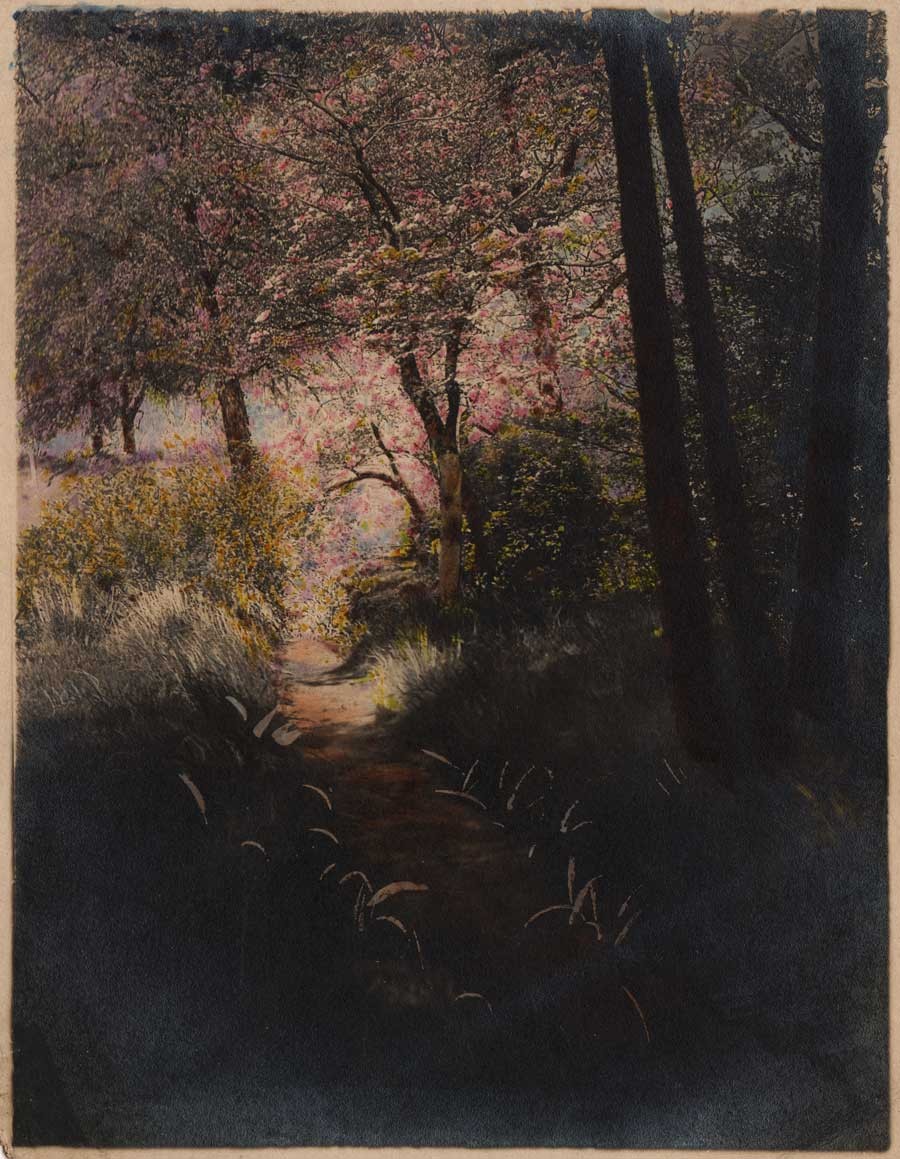 "Spring at Prospect Park"(Brooklyn, New York): ca. 1910-20: Unknown Brooklyn photographer: hand-colored gelatin silver: 11.8 x 9.0 cm | 13.2 x 9.9 cm: from: PhotoSeed Archive
"Spring at Prospect Park"(Brooklyn, New York): ca. 1910-20: Unknown Brooklyn photographer: hand-colored gelatin silver: 11.8 x 9.0 cm | 13.2 x 9.9 cm: from: PhotoSeed Archive
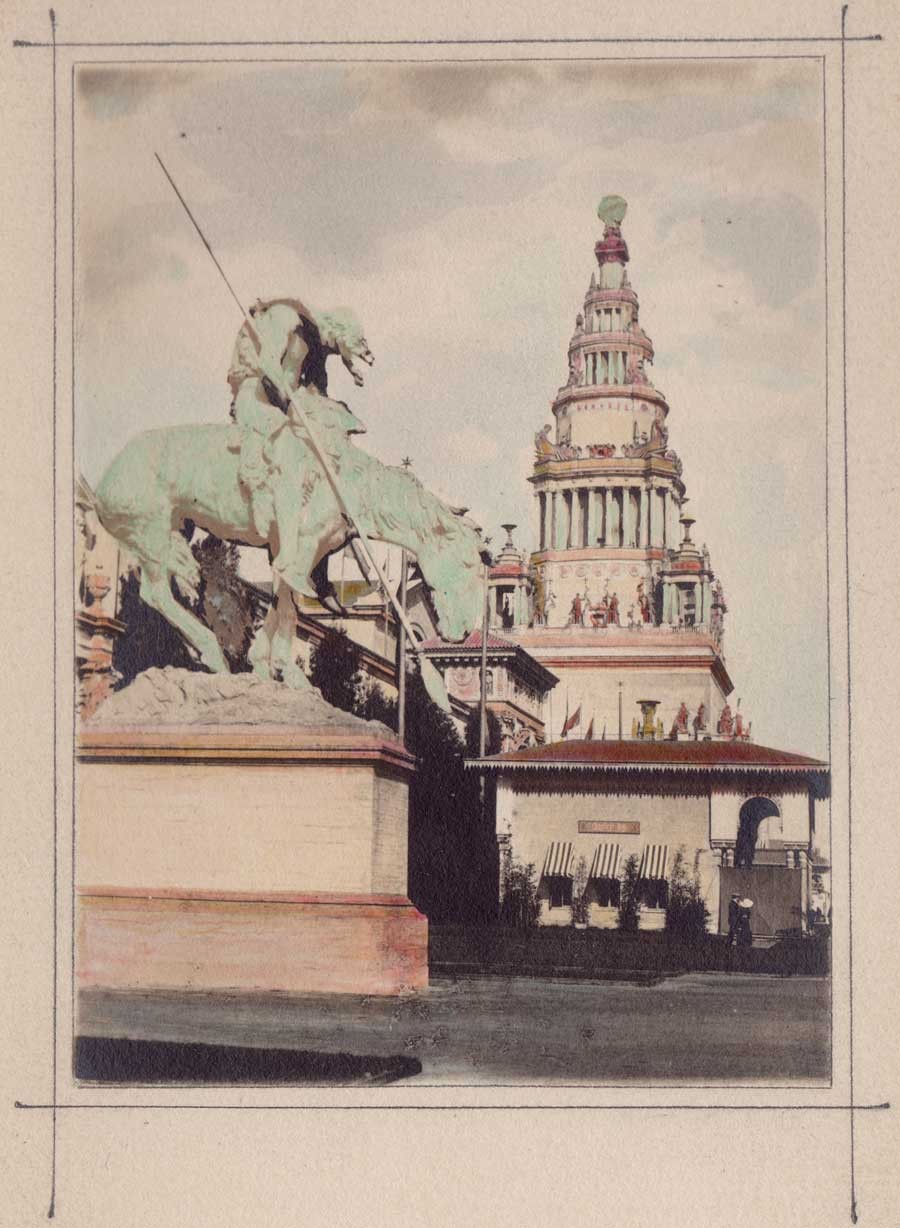 "The End of the Trail": sculpture by James Earle Fraser (American: 1876-1953) at Panama-Pacific International Exposition, San Francisco, California (Tower of Jewels in background) : 1915: Unknown Brooklyn photographer: hand-ruled & colored gelatin silver: 11.0 x 8.0 cm | 17.1 x 11.5 cm: from: PhotoSeed Archive
"The End of the Trail": sculpture by James Earle Fraser (American: 1876-1953) at Panama-Pacific International Exposition, San Francisco, California (Tower of Jewels in background) : 1915: Unknown Brooklyn photographer: hand-ruled & colored gelatin silver: 11.0 x 8.0 cm | 17.1 x 11.5 cm: from: PhotoSeed Archive
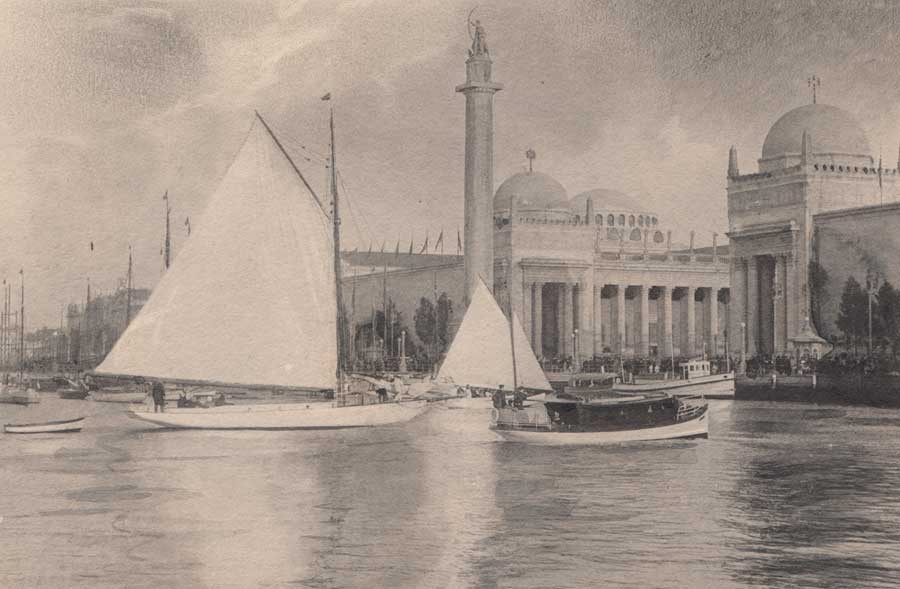 Detail: "Yacht Harbor at Panama-Pacific International Exposition" (Palaces of Agriculture & Transportation in background): 1915: Unknown Brooklyn photographer: gelatin silver with ink wash & photographic border: 7.4 x 11.5 cm | 11.4 x 17.8 cm: from: PhotoSeed Archive
Detail: "Yacht Harbor at Panama-Pacific International Exposition" (Palaces of Agriculture & Transportation in background): 1915: Unknown Brooklyn photographer: gelatin silver with ink wash & photographic border: 7.4 x 11.5 cm | 11.4 x 17.8 cm: from: PhotoSeed Archive
Several other photographs showing an unknown woman, most likely the photographer’s wife, or perhaps the artist herself, (can’t be ruled out) were also included in the trunk photographs. In one, a full-length profile view, she examines a Magnolia blossom in a park setting. (shown here) In another, her gaze is directed towards the camera while wearing an Asian influenced floral dress posing in front of blooming Wisteria vines. The dealer who had initially acquired the photographs, according to the seller I purchased them from, stated they had been acquired from the estate of a woman, (most likely depicted in the photographs) who had (presumably) attended or graduated from Wesleyan Female College, (now Wesleyan College) in Macon, Georgia at the turn of the 20th Century.
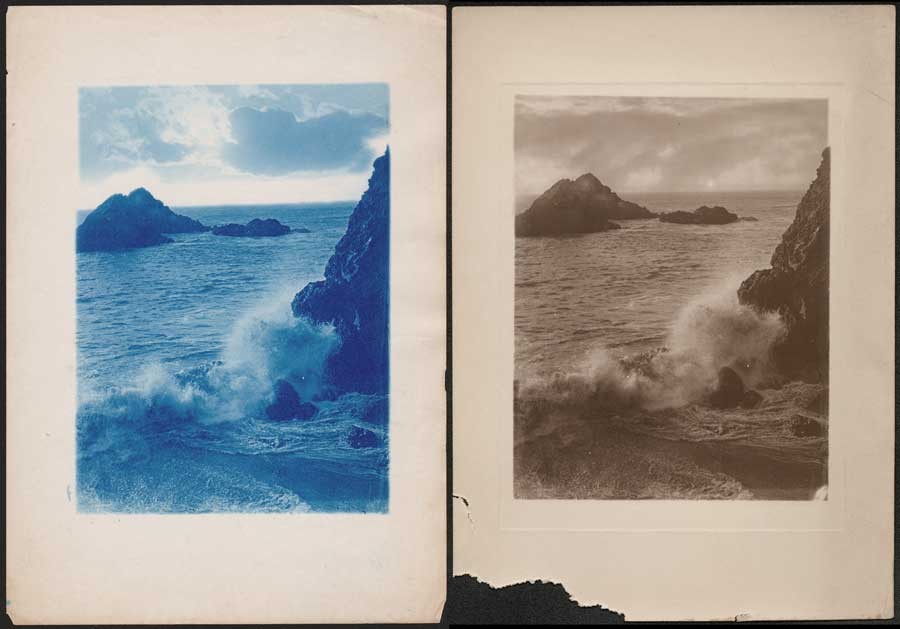 L: "Coastline with Rocks & Wave Action" (possibly California ) :12.3 x 9.0 cm | 17.7 x 12.6 cm: ca. 1910-1920: Unknown Brooklyn photographer: cyanotype with addition of clouds from alternate source photo: R: variant: "Coastline with Rocks & Wave Action" (possibly California) : 11.5 x 9.0 cm | 17.6 x 12.7 cm: ca. 1910-1920: Unknown Brooklyn photographer: gelatin silver: (mouse damage to lower margin): both from: PhotoSeed Archive
L: "Coastline with Rocks & Wave Action" (possibly California ) :12.3 x 9.0 cm | 17.7 x 12.6 cm: ca. 1910-1920: Unknown Brooklyn photographer: cyanotype with addition of clouds from alternate source photo: R: variant: "Coastline with Rocks & Wave Action" (possibly California) : 11.5 x 9.0 cm | 17.6 x 12.7 cm: ca. 1910-1920: Unknown Brooklyn photographer: gelatin silver: (mouse damage to lower margin): both from: PhotoSeed Archive
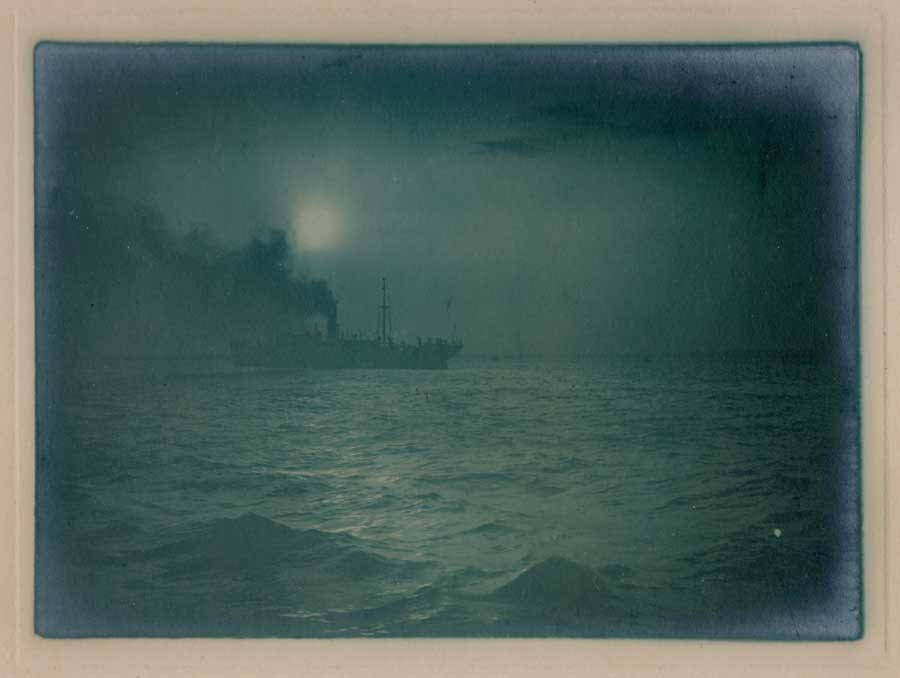 "Steamer in New York Harbor": ca. 1910-20: Unknown Brooklyn photographer: green toned gelatin silver: 8.4 x 11.6 cm | 12.3 x 17.9 cm: from: PhotoSeed Archive
"Steamer in New York Harbor": ca. 1910-20: Unknown Brooklyn photographer: green toned gelatin silver: 8.4 x 11.6 cm | 12.3 x 17.9 cm: from: PhotoSeed Archive
And even though the photographs ended their life residing in a mystery trunk in the American South, I’ll label them for now as being the work of Unknown Brooklyn, in order to keep their attribution consistent for those searching this archive going forward.
